Cambium Networks 50450M 5 GHz Point to Multipoint User MIMO Accesspoint User Manual 450 Platform User Guide
Cambium Networks Limited 5 GHz Point to Multipoint User MIMO Accesspoint 450 Platform User Guide
Contents
- 1. USER GUIDE P1
- 2. USER GUIDE P2
- 3. USER GUIDE P3
- 4. USER GUIDE P4
- 5. User manual
- 6. User Manual
- 7. USERS MANUAL PART1
- 8. USERS MANUAL PART2
- 9. USERS MANUAL PART3
- 10. USERS MANUAL PART4
- 11. USER MANUAL PART1
- 12. USER MANUAL PART2
- 13. USER MANUAL PART 3
- 14. USER MANUAL PART 4
- 15. USER MANUAL PT1
- 16. USER MANUAL PT2
- 17. USER MANUAL PT3
USER GUIDE P1

33F
Cambium
450 Platform
User Guide
System Release 15.0
pass
pmp-0957_006v002 (August 2016)
Accuracy
While reasonable efforts have been made to assure the accuracy of this document, Cambium Networks
assumes no liability resulting from any inaccuracies or omissions in this document, or from use of the
information obtained herein. Cambium reserves the right to make changes to any products described
herein to improve reliability, function, or design, and reserves the right to revise this document and to
make changes from time to time in content hereof with no obligation to notify any person of revisions
or changes. Cambium does not assume any liability arising out of the application or use of any
product, software, or circuit described herein; neither does it convey license under its patent rights or
the rights of others. It is possible that this publication may contain references to, or information about
Cambium products (machines and programs), programming, or services that are not announced in
your country. Such references or information must not be construed to mean that Cambium intends to
announce such Cambium products, programming, or services in your country.
Copyrights
This document, Cambium products, and 3rd Party software products described in this document may
include or describe copyrighted Cambium and other 3rd Party supplied computer programs stored in
semiconductor memories or other media. Laws in the United States and other countries preserve for
Cambium, its licensors, and other 3rd Party supplied software certain exclusive rights for copyrighted
material, including the exclusive right to copy, reproduce in any form, distribute and make derivative
works of the copyrighted material. Accordingly, any copyrighted material of Cambium, its licensors, or
the 3rd Party software supplied material contained in the Cambium products described in this
document may not be copied, reproduced, reverse engineered, distributed, merged or modified in any
manner without the express written permission of Cambium. Furthermore, the purchase of Cambium
products shall not be deemed to grant either directly or by implication, estoppel, or otherwise, any
license under the copyrights, patents or patent applications of Cambium or other 3rd Party supplied
software, except for the normal non-exclusive, royalty free license to use that arises by operation of
law in the sale of a product.
Restrictions
Software and documentation are copyrighted materials. Making unauthorized copies is prohibited by
law. No part of the software or documentation may be reproduced, transmitted, transcribed, stored in a
retrieval system, or translated into any language or computer language, in any form or by any means,
without prior written permission of Cambium.
License Agreements
The software described in this document is the property of Cambium and its licensors. It is furnished
by express license agreement only and may be used only in accordance with the terms of such an
agreement.
High Risk Materials
Cambium and its supplier(s) specifically disclaim any express or implied warranty of fitness for any
high risk activities or uses of its products including, but not limited to, the operation of nuclear
facilities, aircraft navigation or aircraft communication systems, air traffic control, life support, or
weapons systems (“High Risk Use”). Any “High Risk Use” is unauthorized, is made at your own risk
and you shall be responsible for any and all losses, damage or claims arising out of any High Risk Use.
© 2016 Cambium Networks Limited. All Rights Reserved.

Page i
Contents
About This User Guide .......................................................................................................................... 1
Contacting Cambium Networks .................................................................................................... 1
Purpose ........................................................................................................................................... 2
Cross references ............................................................................................................................. 2
Feedback ......................................................................................................................................... 2
Important regulatory information........................................................................................................ 3
Application firmware ..................................................................................................................... 3
USA specific information............................................................................................................... 3
Canada specific information ......................................................................................................... 4
Renseignements specifiques au Canada ..................................................................................... 5
EU Declaration of Conformity ....................................................................................................... 6
Specific expertise and training for professional installers ......................................................... 6
Ethernet networking skills ............................................................................................................. 6
Lightning protection ....................................................................................................................... 7
Training ........................................................................................................................................... 7
Problems and warranty ........................................................................................................................ 8
Reporting problems ....................................................................................................................... 8
Repair and service .......................................................................................................................... 8
Hardware warranty ........................................................................................................................ 8
Security advice ...................................................................................................................................... 9
Warnings, cautions, and notes .......................................................................................................... 10
Warnings ....................................................................................................................................... 10
Cautions ........................................................................................................................................ 10
Notes ............................................................................................................................................. 10
Caring for the environment ................................................................................................................ 11
In EU countries ............................................................................................................................. 11
In non-EU countries ..................................................................................................................... 11
Chapter 1: Product description ....................................................................................................... 1-1
Overview of the PMP/PTP 450 platform ........................................................................................... 1-2
Purpose ........................................................................................................................................ 1-2
PMP 450m Series ........................................................................................................................ 1-2
PMP/PTP 450i Series ................................................................................................................... 1-4
PMP/PTP 450 Series .................................................................................................................... 1-7
Supported interoperability for 450m/450i/450/430 platforms ............................................... 1-10
Typical deployment ................................................................................................................... 1-11
Product variants ........................................................................................................................ 1-13
Wireless operation ........................................................................................................................... 1-14
Contents
Page ii
Time division duplexing ........................................................................................................... 1-14
MIMO .......................................................................................................................................... 1-17
Encryption .................................................................................................................................. 1-17
System management ....................................................................................................................... 1-18
Management agent ................................................................................................................... 1-18
Web server ................................................................................................................................. 1-18
Remote Authentication Dial-in User Service (RADIUS) ......................................................... 1-20
SNMP.......................................................................................................................................... 1-20
Network Time Protocol (NTP) .................................................................................................. 1-20
Wireless Manager (WM) ........................................................................................................... 1-21
Radio recovery mode ................................................................................................................ 1-22
Chapter 2: System hardware .......................................................................................................... 2-1
System Components ......................................................................................................................... 2-2
Point-to-Multipoint (PMP) ........................................................................................................... 2-2
Backhaul (PTP) ............................................................................................................................. 2-5
PMP/PTP 450 platform interfaces .............................................................................................. 2-7
Diagnostic LEDs ......................................................................................................................... 2-12
Power supply options ............................................................................................................... 2-15
ODU mounting brackets & accessories ................................................................................... 2-21
Lightning protection .................................................................................................................. 2-21
Cabling and lightning protection .................................................................................................... 2-22
ODU interfaces – PMP 450m AP .............................................................................................. 2-22
ODU interfaces – PMP/PTP 450i ............................................................................................... 2-23
Ethernet standards and cable lengths ..................................................................................... 2-24
Outdoor copper Cat5e Ethernet cable ..................................................................................... 2-26
Main Ethernet port .................................................................................................................... 2-27
Aux port ..................................................................................................................................... 2-27
Cable grounding kit ................................................................................................................... 2-29
Lightning protection unit (LPU) and grounding kit ................................................................ 2-29
Antennas and antenna cabling ....................................................................................................... 2-31
Antenna requirements .............................................................................................................. 2-31
Supported external AP antennas ............................................................................................. 2-31
Supported external BH/SM antenna ........................................................................................ 2-31
RF cable and connectors........................................................................................................... 2-32
Antenna accessories ................................................................................................................. 2-32
RJ45 connectors and spare glands .......................................................................................... 2-32
GPS synchronization ........................................................................................................................ 2-34
GPS synchronization description ............................................................................................. 2-34
Universal GPS (uGPS) .............................................................................................................. 2-34
CMM5 ......................................................................................................................................... 2-34
CMM4 (Rack
Mount)
................................................................................................................ 2-35
CMM4
(Cabinet
with switch) .................................................................................................. 2-38
CMM4
(Cabinet
without switch) ............................................................................................ 2-38
Contents
Page iii
CMM3/CMMmicro ..................................................................................................................... 2-38
Installing a GPS receiver ................................................................................................................. 2-40
GPS receiver location................................................................................................................ 2-40
Mounting the GPS receiver ...................................................................................................... 2-41
Cabling the GPS Antenna ......................................................................................................... 2-42
Installing and connecting the GPS LPU .................................................................................. 2-42
Ordering the components ............................................................................................................... 2-43
Chapter 3: System planning ........................................................................................................... 3-1
Typical deployment ........................................................................................................................... 3-2
ODU with PoE interface to PSU ................................................................................................. 3-2
Site planning....................................................................................................................................... 3-7
Site selection for PMP/PTP radios ............................................................................................. 3-7
Calculated distances and power compliance margin .............................................................. 3-7
Power supply site selection ........................................................................................................ 3-8
Maximum cable lengths ............................................................................................................. 3-8
Grounding and lightning protection .......................................................................................... 3-8
ODU and external antenna location ........................................................................................ 3-10
ODU ambient temperature limits ............................................................................................ 3-10
ODU wind loading ..................................................................................................................... 3-11
Drop cable grounding points ................................................................................................... 3-14
Lightning Protection Unit(LPU) location ................................................................................. 3-15
Radio Frequency planning .............................................................................................................. 3-16
Regulatory limits ....................................................................................................................... 3-16
Conforming to the limits........................................................................................................... 3-16
Available spectrum ................................................................................................................... 3-16
Analyzing the RF Environment ................................................................................................ 3-17
Channel bandwidth ................................................................................................................... 3-17
Anticipating Reflection of Radio Waves .................................................................................. 3-17
Obstructions in the Fresnel Zone ............................................................................................. 3-18
Planning for co-location............................................................................................................ 3-18
Multiple OFDM Access Point Clusters ..................................................................................... 3-18
Link planning .................................................................................................................................... 3-21
Range and obstacles ................................................................................................................. 3-21
Path loss ..................................................................................................................................... 3-21
Calculating Link Loss ................................................................................................................ 3-22
Calculating Rx Signal Level ...................................................................................................... 3-22
Calculating Fade Margin ........................................................................................................... 3-23
Adaptive modulation ................................................................................................................ 3-23
Planning for connectorized units .................................................................................................... 3-24
When to install connectorized units ........................................................................................ 3-24
Choosing external antennas .................................................................................................... 3-24
Calculating RF cable length (5.8 GHz FCC only) ..................................................................... 3-24
Data network planning .................................................................................................................... 3-26
Contents
Page iv
Understanding addresses......................................................................................................... 3-26
Dynamic or static addressing ................................................................................................... 3-26
DNS Client .................................................................................................................................. 3-27
Network Address Translation (NAT) ....................................................................................... 3-27
Developing an IP addressing scheme ..................................................................................... 3-28
Address Resolution Protocol .................................................................................................... 3-28
Allocating subnets ..................................................................................................................... 3-29
Selecting non-routable IP addresses ....................................................................................... 3-29
Translation bridging .................................................................................................................. 3-30
Engineering VLANs ................................................................................................................... 3-30
Network management planning ..................................................................................................... 3-34
Planning for SNMP operation .................................................................................................. 3-34
Enabling SNMP ......................................................................................................................... 3-34
Security planning ............................................................................................................................. 3-35
Isolating AP/BHM from the Internet ........................................................................................ 3-35
Encrypting radio transmissions ............................................................................................... 3-35
Planning for HTTPS operation ................................................................................................. 3-36
Planning for SNMPv3 operation .............................................................................................. 3-36
Managing module access by passwords ................................................................................ 3-37
Planning for RADIUS operation ............................................................................................... 3-38
Filtering protocols and ports .................................................................................................... 3-38
Encrypting downlink broadcasts ............................................................................................. 3-42
Isolating SMs in PMP ................................................................................................................ 3-42
Filtering management through Ethernet ................................................................................ 3-42
Allowing management from only specified IP addresses ..................................................... 3-43
Configuring management IP by DHCP .................................................................................... 3-43
Controlling PPPoE PADI Downlink Forwarding ...................................................................... 3-44
Chapter 4: Legal and regulatory information ................................................................................ 4-1
Cambium Networks end user license agreement ........................................................................... 4-2
Definitions .................................................................................................................................... 4-2
Acceptance of this agreement ................................................................................................... 4-2
Grant of license ........................................................................................................................... 4-2
Conditions of use ........................................................................................................................ 4-3
Title and restrictions ................................................................................................................... 4-4
Confidentiality ............................................................................................................................. 4-4
Right to use Cambium’s name ................................................................................................... 4-5
Transfer ........................................................................................................................................ 4-5
Updates ........................................................................................................................................ 4-5
Maintenance ................................................................................................................................ 4-5
Disclaimer .................................................................................................................................... 4-6
Limitation of liability ................................................................................................................... 4-6
U.S. government ......................................................................................................................... 4-6
Term of license ............................................................................................................................ 4-7
Contents
Page v
Governing law ............................................................................................................................. 4-7
Assignment .................................................................................................................................. 4-7
Survival of provisions ................................................................................................................. 4-7
Entire agreement ......................................................................................................................... 4-7
Third party software .................................................................................................................... 4-7
Compliance with safety standards ................................................................................................. 4-22
Electrical safety compliance ..................................................................................................... 4-22
Electromagnetic compatibility (EMC) compliance ................................................................. 4-22
Human exposure to radio frequency energy .......................................................................... 4-22
Compliance with radio regulations ................................................................................................ 4-31
Type approvals .......................................................................................................................... 4-32
Brazil specific information ........................................................................................................ 4-33
Australia Notification ................................................................................................................ 4-33
Regulatory Requirements for CEPT Member States (www.cept.org) .................................. 4-33
Chapter 5: Preparing for installation .............................................................................................. 5-1
Safety .................................................................................................................................................. 5-2
Power lines .................................................................................................................................. 5-2
Working at heights ...................................................................................................................... 5-2
Power supply ............................................................................................................................... 5-2
Grounding and protective earth ................................................................................................ 5-2
Powering down before servicing ............................................................................................... 5-2
Primary disconnect device ......................................................................................................... 5-3
External cables ............................................................................................................................ 5-3
RF exposure near the antenna ................................................................................................... 5-3
Minimum separation distances ................................................................................................. 5-3
Grounding and lightning protection requirements .................................................................. 5-3
Grounding cable installation methods ...................................................................................... 5-3
Siting ODUs and antennas ......................................................................................................... 5-4
Thermal Safety ............................................................................................................................ 5-4
Preparing for installation ................................................................................................................... 5-5
ODU pre-configuration ............................................................................................................... 5-5
Preparing personnel .................................................................................................................... 5-5
Preparing inventory .................................................................................................................... 5-5
Preparing tools ............................................................................................................................ 5-6
Testing system components ............................................................................................................. 5-7
Unpacking Components ............................................................................................................. 5-7
Preparing the ODU ...................................................................................................................... 5-7
Configuring Link for Test ................................................................................................................. 5-15
Configuring the management PC ............................................................................................ 5-15
Logging into the web interface – AP/SM/BH........................................................................... 5-16
Using the Quick Start Configuration Wizard of the AP/BHM ................................................ 5-16
Chapter 6: Installation .................................................................................................................... 6-1
ODU variants and mounting bracket options .................................................................................. 6-2
Contents
Page vi
Mount the ODU, LPU and surge suppressor ................................................................................... 6-3
Attach ground cables to the ODU .............................................................................................. 6-3
Mount the ODU on the mast ...................................................................................................... 6-6
Mount the top LPU ...................................................................................................................... 6-9
Mount the Surge Suppressor ..................................................................................................... 6-9
General protection installation ................................................................................................ 6-12
Installing the copper Cat5e Ethernet interface .............................................................................. 6-17
Install the main drop cable ....................................................................................................... 6-17
Install the bottom LPU to PSU drop cable .............................................................................. 6-19
Installing external antennas to a connectorized ODU .................................................................. 6-21
PMP 450i Series ......................................................................................................................... 6-21
PMP 450 Series .......................................................................................................................... 6-29
Attaching the PMP 450 platform AP and antenna to the mount point ................................. 6-35
PMP 450i Series 900 MHz AP ................................................................................................... 6-38
PMP 450 Series 900 MHz SM ................................................................................................... 6-45
Installing an integrated ODU........................................................................................................... 6-49
PMP 450m Series – AP .............................................................................................................. 6-49
PMP/PTP 450i Series – AP/SM/BH ............................................................................................ 6-52
Connecting Cat5e Ethernet cable.................................................................................................... 6-53
Connecting an RJ45 and gland to a unit ................................................................................. 6-53
Disconnecting an RJ45 and gland from a unit ....................................................................... 6-55
Installing ODU .................................................................................................................................. 6-56
Installing an PMP 450 platform AP .......................................................................................... 6-56
Installing a PMP 450 platform SM ........................................................................................... 6-57
Installing a PTP 450 platform BHM .......................................................................................... 6-58
Installing a PTP 450 platform BHS ........................................................................................... 6-59
Configuring the Link .................................................................................................................. 6-60
Monitoring the Link ................................................................................................................... 6-60
Installing the AC Power Injector ..................................................................................................... 6-61
Installing the AC Power Injector .............................................................................................. 6-61
Installing CMM4 ............................................................................................................................... 6-62
Supplemental installation information .......................................................................................... 6-64
Stripping drop cable ................................................................................................................. 6-64
Creating a drop cable grounding point ................................................................................... 6-65
Attaching and weatherproofing an N type connector ........................................................... 6-68
Chapter 7: Configuration .............................................................................................................. 7-71
Preparing for configuration ............................................................................................................. 7-72
Safety precautions .................................................................................................................... 7-72
Regulatory compliance ............................................................................................................. 7-72
Connecting to the unit ..................................................................................................................... 7-73
Configuring the management PC ............................................................................................ 7-73
Connecting to the PC and powering up .................................................................................. 7-74
Using the web interface ................................................................................................................... 7-75
Contents
Page vii
Logging into the web interface ................................................................................................ 7-75
Web GUI ..................................................................................................................................... 7-76
Using the menu options ........................................................................................................... 7-77
Quick link setup ................................................................................................................................ 7-81
Initiating Quick Start Wizard .................................................................................................... 7-81
Configuring time settings ......................................................................................................... 7-87
Powering the SM/BHS for test ................................................................................................. 7-88
Viewing the Session Status of the AP/BHM to determine test registration ......................... 7-89
Configuring IP and Ethernet interfaces .......................................................................................... 7-92
Configuring the IP interface ..................................................................................................... 7-93
Auxiliary port ............................................................................................................................. 7-96
NAT, DHCP Server, DHCP Client and DMZ ............................................................................. 7-97
DHCP – BHS ............................................................................................................................. 7-114
Reconnecting to the management PC ................................................................................... 7-114
VLAN configuration for PMP ...................................................................................................... 7-114
VLAN configuration for PTP ...................................................................................................... 7-124
PPPoE page of SM ................................................................................................................... 7-128
IP4 and IPv6 ............................................................................................................................. 7-131
Upgrading the software version and using CNUT ...................................................................... 7-135
Checking the installed software version ............................................................................... 7-135
Upgrading to a new software version ................................................................................... 7-135
General configuration .................................................................................................................... 7-139
PMP 450m and PMP/PTP 450i Series .................................................................................... 7-139
PMP/PTP 450 Series ................................................................................................................ 7-152
Configuring Unit Settings page .................................................................................................... 7-157
Setting up time and date ............................................................................................................... 7-161
Time page of PMP/PTP 450 platform AP/BHM ..................................................................... 7-161
Configuring synchronization ......................................................................................................... 7-163
Configuring security ...................................................................................................................... 7-165
Managing module access by password ................................................................................ 7-166
Isolating from the internet – APs/BHMs ................................................................................ 7-169
Encrypting radio transmissions ............................................................................................. 7-169
Requiring SM Authentication ................................................................................................. 7-170
Filtering protocols and ports .................................................................................................. 7-171
Encrypting downlink broadcasts ........................................................................................... 7-174
Isolating SMs ........................................................................................................................... 7-174
Filtering management through Ethernet .............................................................................. 7-175
Allowing management only from specified IP addresses ................................................... 7-175
Restricting radio Telnet access over the RF interface .......................................................... 7-175
Configuring SNMP Access ..................................................................................................... 7-178
Configuring Security ............................................................................................................... 7-180
Configuring radio parameters....................................................................................................... 7-192
PMP 450m – Configurating radio ........................................................................................... 7-193
Contents
Page viii
PMP/PTP 450i – Configurating radio ...................................................................................... 7-199
PMP/PTP 450 – Configurating radio ....................................................................................... 7-217
Custom Frequencies page ...................................................................................................... 7-234
DFS for 5 GHz Radios .............................................................................................................. 7-237
MIMO-A mode of operation .................................................................................................... 7-239
Improved PPS performance of PMP 450 and 450i SMs ......................................................... 7-241
Setting up SNMP agent ................................................................................................................. 7-242
Configuring SM/BHS’s IP over-the-air access ...................................................................... 7-243
Configuring SNMP .................................................................................................................. 7-244
Configuring syslog ......................................................................................................................... 7-249
Syslog event logging .............................................................................................................. 7-250
Configuring system logging ................................................................................................... 7-250
Configuring remote access ........................................................................................................... 7-255
Accessing SM/BHS over-the-air by Web Proxy .................................................................... 7-255
Monitoring the Link ........................................................................................................................ 7-256
Link monitoring procedure ..................................................................................................... 7-256
Exporting Session Status page of AP/BHM .......................................................................... 7-258
Configuring quality of service ....................................................................................................... 7-259
Maximum Information Rate (MIR) Parameters .................................................................... 7-259
Token Bucket Algorithm ......................................................................................................... 7-259
MIR Data Entry Checking ........................................................................................................ 7-260
Committed Information Rate (CIR) ........................................................................................ 7-260
Bandwidth from the SM Perspective ..................................................................................... 7-261
Interaction of Burst Allocation and Sustained Data Rate Settings ..................................... 7-261
High-priority Bandwidth ......................................................................................................... 7-261
Traffic Scheduling ................................................................................................................... 7-263
Setting the Configuration Source .......................................................................................... 7-264
Configuring Quality of Service (QoS) .................................................................................... 7-266
Installation Color Code .................................................................................................................. 7-272
Zero Touch Configuration Using DHCP Option 66...................................................................... 7-273
Configuration Steps ................................................................................................................ 7-273
Troubleshooting ...................................................................................................................... 7-278
Configuring Radio via config file .................................................................................................. 7-279
Import and Export of config file ............................................................................................. 7-279
Configuring a RADIUS server ....................................................................................................... 7-281
Understanding RADIUS for PMP 450 platform .................................................................... 7-281
Choosing Authentication Mode and Configuring for Authenti
c
ation Ser
v
er
s - AP
..... 7-282
SM Authentication Mode – Require RADIUS or Follow AP ............................................ 7-287
Handling Certificates ............................................................................................................... 7-292
Configuring RADIUS servers for SM authentication ........................................................... 7-293
Assigning SM management IP addressing via RADIUS ...................................................... 7-295
Configuring RADIUS server for SM configuration ............................................................... 7-295
Configuring RADIUS server for SM configuration using Zero Touch feature ................... 7-298
Contents
Page ix
Using RADIUS for centralized AP and SM user name and password management ........ 7-299
RADIUS Device Data Accounting ........................................................................................... 7-303
RADIUS Device Re-authentication ......................................................................................... 7-306
RADIUS Change of Authorization and Disconnect Message .............................................. 7-307
Microsoft RADIUS support ..................................................................................................... 7-308
Cisco ACS RADIUS Server Support ....................................................................................... 7-312
Configuring VSA ...................................................................................................................... 7-315
Chapter 8: Tools .............................................................................................................................. 8-1
Using Spectrum Analyzer tool .......................................................................................................... 8-2
Mapping RF Neighbor Frequencies ........................................................................................... 8-2
Spectrum Analyzer tool .............................................................................................................. 8-3
Remote Spectrum Analyzer tool .............................................................................................. 8-12
Using the Alignment Tool ............................................................................................................... 8-15
Aiming page and Diagnostic LED – SM/BHS .......................................................................... 8-16
Alignment Tone ......................................................................................................................... 8-20
Using the Link Capacity Test tool ................................................................................................... 8-21
Performing “RF Link Test”, “Link Test with Bridge” or “Link Test with Bridge and MIR” 8-22
Performing Extrapolated Link Test .......................................................................................... 8-23
Link Capacity Test page of AP .................................................................................................. 8-24
Link Capacity Test page of BHM/BHS/SM ............................................................................... 8-26
Using AP Evaluation tool ................................................................................................................. 8-27
AP Evaluation page of AP ......................................................................................................... 8-27
Using BHM Evaluation tool ............................................................................................................. 8-31
BHM Evaluation page of BHS .................................................................................................. 8-31
Using the OFDM Frame Calculator tool ......................................................................................... 8-35
Using the Subscriber Configuration tool ....................................................................................... 8-39
Using the Link Status tool ............................................................................................................... 8-40
Link Status – AP/BHM ............................................................................................................... 8-40
Link Status – SM/BHS ............................................................................................................... 8-42
Using BER Results tool .................................................................................................................... 8-45
Using the Sessions tool ................................................................................................................... 8-46
Chapter 9: Operation ...................................................................................................................... 9-1
System information ........................................................................................................................... 9-2
Viewing General Status .............................................................................................................. 9-2
Viewing Session Status ............................................................................................................ 9-16
Viewing Remote Subscribers ................................................................................................... 9-22
Interpreting messages in the Event Log ................................................................................. 9-23
Viewing the Network Interface ................................................................................................. 9-25
Viewing the Layer 2 Neighbors ................................................................................................ 9-26
System statistics .............................................................................................................................. 9-27
Viewing the Scheduler statistics .............................................................................................. 9-27
Viewing list of Registration Failures statistics ........................................................................ 9-29
Interpreting Bridging Table statistics ...................................................................................... 9-30
Contents
Page x
Interpreting Translation Table statistics.................................................................................. 9-31
Interpreting Ethernet statistics ................................................................................................. 9-32
Interpreting RF Control Block statistics ................................................................................... 9-35
Interpreting VLAN statistics ..................................................................................................... 9-36
Interpreting Data VC statistics .................................................................................................. 9-38
Interpreting Throughput statistics ........................................................................................... 9-40
Interpreting Overload statistics ................................................................................................ 9-43
Interpreting DHCP Relay statistics ........................................................................................... 9-44
Interpreting Filter statistics ....................................................................................................... 9-46
Viewing ARP statistics .............................................................................................................. 9-47
Viewing NAT statistics .............................................................................................................. 9-47
Viewing NAT DHCP Statistics .................................................................................................. 9-49
Interpreting Sync Status statistics ........................................................................................... 9-50
Interpreting PPPoE Statistics for Customer Activities ........................................................... 9-51
Interpreting Bridge Control Block statistics ............................................................................ 9-52
Interpreting Pass Through Statistics ....................................................................................... 9-54
Interpreting SNMPv3 Statistics ................................................................................................ 9-55
Interpreting syslog statistics .................................................................................................... 9-57
Interpreting Frame Utilization statistics .................................................................................. 9-57
Radio Recovery ................................................................................................................................ 9-61
Radio Recovery Console– PMP/PTP 450i ................................................................................ 9-61
Default Mode (or Default/Override Plug) - PMP/PTP 450 ....................................................... 9-63
Chapter 10: Reference Information ............................................................................................. 10-1
Equipment specifications ................................................................................................................ 10-2
Specifications for PMP 450m AP ............................................................................................. 10-2
Specifications for PMP 450i AP ................................................................................................ 10-5
Specifications for PMP 450i SM ............................................................................................... 10-9
Specifications for PTP 450i BH ............................................................................................... 10-13
Specifications for PMP 450 AP ............................................................................................... 10-17
Specifications for PMP 450 SM .............................................................................................. 10-22
Specifications for PTP 450 BH ................................................................................................ 10-26
PSU specifications ................................................................................................................... 10-31
Data network specifications .......................................................................................................... 10-33
Ethernet interface .................................................................................................................... 10-33
Wireless specifications .................................................................................................................. 10-34
General wireless specifications ............................................................................................. 10-34
Link Range and Throughput ................................................................................................... 10-34
Country specific radio regulations ............................................................................................... 10-35
Type approvals ........................................................................................................................ 10-35
DFS for 2.4 and 5 GHz Radios ................................................................................................ 10-36
Equipment Disposal ....................................................................................................................... 10-37
Waste (Disposal) of Electronic and Electric Equipment ....................................................... 10-37
Country specific maximum transmit power ......................................................................... 10-37
Contents
Page xi
Country specific frequency range .......................................................................................... 10-48
FCC specific information......................................................................................................... 10-55
Innovation Science and Economic Development Canada (ISEDC) specific information . 10-59
Chapter 11: Troubleshooting .................................................................................................... 11-64
General troubleshooting procedure ............................................................................................. 11-65
General planning for troubleshooting ................................................................................... 11-65
General fault isolation process .............................................................................................. 11-66
Secondary Steps ..................................................................................................................... 11-67
Troubleshooting procedures ......................................................................................................... 11-68
Module has lost or does not establish connectivity ............................................................ 11-68
NAT/DHCP-configured SM has lost or does not establish connectivity ............................ 11-70
SM Does Not Register to an AP ............................................................................................. 11-72
Module has lost or does not gain sync ................................................................................. 11-73
Module does not establish Ethernet connectivity ................................................................ 11-74
CMM4 does not pass proper GPS sync to connected modules.......................................... 11-75
Module Software Cannot be Upgraded ................................................................................ 11-76
Module Functions Properly, Except Web Interface Became Inaccessible ......................... 11-76
Power-up troubleshooting ............................................................................................................ 11-77
Registration and connectivity troubleshooting ........................................................................... 11-78
SM/BMS Registration .............................................................................................................. 11-78
Glossary .................................................................................................................................................. I

List of Figures
Page xii
List of Figures
Figure 1 PMP/PTP 450 platform typical bridge deployment .............................................................. 1-11
Figure 2 TDD frame division.................................................................................................................. 1-14
Figure 3 PMP/PTP 450 interfaces - AP .................................................................................................... 2-9
Figure 4 PMP/PTP 450 interfaces – SM/BH ........................................................................................... 2-10
Figure 5 PMP/PTP 450 interfaces – SM/BH Connectorized ................................................................. 2-10
Figure 6 PMP 450d SM - Integrated Dish ............................................................................................. 2-11
Figure 7 PMP 450 Series – 3 GHz Integrated SM ................................................................................. 2-11
Figure 8 PTP 450 Series – BHM/BHS .................................................................................................... 2-11
Figure 9 AP/BHM diagnostic LEDs, viewed from unit front ............................................................... 2-12
Figure 10 AP/BH diagnostic LEDs, viewed from unit front ................................................................. 2-14
Figure 11 AC Power Injector interfaces ................................................................................................ 2-17
Figure 12 AC+DC Enhanced Power Injector interfaces ....................................................................... 2-18
Figure 13 -48 V DC Power Injector interfaces ...................................................................................... 2-19
Figure 14 Gigabit Enet Capable power supply .................................................................................... 2-20
Figure 15 ODU rear interfaces ............................................................................................................... 2-22
Figure 16 ODU rear interfaces ............................................................................................................... 2-23
Figure 17 Connectorized ODU antenna interfaces .............................................................................. 2-24
Figure 18 Outdoor drop cable ............................................................................................................... 2-26
Figure 19 Alignment Tone Cable .......................................................................................................... 2-28
Figure 20 Cable grounding kit ............................................................................................................... 2-29
Figure 21 Cable gland (part number #N000065L033) ......................................................................... 2-33
Figure 22 uGPS ....................................................................................................................................... 2-34
Figure 23 CMM4 (Rack Mount).............................................................................................................. 2-35
Figure 24 CMM4 56V power adapter (dongle)..................................................................................... 2-36
Figure 25 CMM4 power adapter cabling diagram .............................................................................. 2-36
Figure 26 CMM4 (Cabinet with switch) ................................................................................................ 2-38
Figure 27 CMM3 ..................................................................................................................................... 2-39
Figure 28 Pole mounted CMM3 ............................................................................................................ 2-39
Figure 29 GPS antenna mounting ........................................................................................................ 2-41
Figure 30 Mast or tower installation ....................................................................................................... 3-2
Figure 31 Wall installation ....................................................................................................................... 3-3
Figure 32 Roof installation....................................................................................................................... 3-4
Figure 33 GPS receiver wall installation ................................................................................................ 3-5
Figure 34 GPS receiver tower or mast installation ............................................................................... 3-6
Figure 35 Rolling sphere method to determine the lightning protection zones ................................ 3-9
Figure 36 Example layout of 16 Access Point sectors (ABCD), 90 degree sectors ........................... 3-19
Figure 37 Example layout of 6 Access Point sectors (ABC), 60 degree sectors ............................... 3-20
Figure 38 Determinants in Rx signal level ........................................................................................... 3-22
List of Figures
Page xiii
Figure 39 Cambium networks management domain ......................................................................... 3-27
Figure 40 Example of IP address in Class B subnet ............................................................................ 3-29
Figure 41 Categorical protocol filtering ................................................................................................ 3-40
Figure 42 Pin 1 location ......................................................................................................................... 5-10
Figure 43 Straight-through Ethernet Cable .......................................................................................... 5-12
Figure 44 AP/BHM to UGPS cable ........................................................................................................ 5-13
Figure 45 Alignment tone cable pin configuration ............................................................................. 5-14
Figure 46 RJ-11 pinout for the default plug ......................................................................................... 5-14
Figure 47 PMP 450 900 MHz SM grounding .......................................................................................... 6-6
Figure 48 Gigabit Surge Suppressor .................................................................................................... 6-10
Figure 49 600SSH Surge Suppressor – inside .................................................................................... 6-11
Figure 50 Grounding cable minimum bend radius and angle ........................................................... 6-13
Figure 51 Grounding and lightning protection on mast or tower ..................................................... 6-14
Figure 52 Grounding and lightning protection on wall ...................................................................... 6-15
Figure 53 Grounding and lightning protection on building ............................................................... 6-16
Figure 54 RJ45 cable .............................................................................................................................. 6-18
Figure 55 AP antenna parts ................................................................................................................... 6-23
Figure 56 Antenna top plate .................................................................................................................. 6-24
Figure 57 Attaching antenna plate to the AP ....................................................................................... 6-24
Figure 58 Attaching the plate ................................................................................................................ 6-25
Figure 59 Connect the port A and B to the PMP 450i AP .................................................................... 6-25
Figure 60 AP antenna upper bracket assembly ................................................................................... 6-26
Figure 61 AP antenna upper bracket attached to upper adjustment arms ....................................... 6-26
Figure 62 Rear strap connected to upper AP antenna bracket........................................................... 6-27
Figure 63 Assembled upper bracket connected to AP antenna ......................................................... 6-27
Figure 64 AP Antenna Lower Bracket Assembly ................................................................................. 6-27
Figure 65 Lower bracket attached to AP antenna................................................................................ 6-28
Figure 66 Completed AP and antenna assembly ................................................................................ 6-28
Figure 67 PMP 450 AP antenna parts ................................................................................................... 6-29
Figure 68 AP antenna upper bracket assembly .................................................................................. 6-30
Figure 69 AP antenna upper bracket attached to upper adjustment arms ...................................... 6-30
Figure 70 Rear strap connected to upper AP antenna bracket.......................................................... 6-31
Figure 71 Assembled upper bracket connected to AP antenna ........................................................ 6-31
Figure 72 AP Antenna Lower Bracket Assembly ................................................................................ 6-32
Figure 73 Lower bracket attached to AP antenna .............................................................................. 6-32
Figure 74 Attaching bracket to the rear of the AP .............................................................................. 6-33
Figure 75 Lower bracket attached to AP antenna .............................................................................. 6-33
Figure 76 Mounted PMP 450 AP and antenna assembly, viewed from back and back .................. 6-34
Figure 77 Attaching the AP antenna upper bracket to the pole ......................................................... 6-35
Figure 78 Attaching the AP antenna lower bracket to the pole ......................................................... 6-35
Figure 79 Variables for calculating angle of elevation (and depression) .......................................... 6-37
Figure 80 PMP 450i 900 MHz AP antenna unbox view ...................................................................... 6-38
Figure 81 PMP 450i 900 MHz AP antenna inventory .......................................................................... 6-38
List of Figures
Page xiv
Figure 82 Attaching radio mounting PMP 450i 900 MHz AP antenna to the pole ........................... 6-43
Figure 83 900 MHz sector antenna alignment .................................................................................... 6-44
Figure 84 PMP 450i 900 MHz SM external directional antenna ......................................................... 6-45
Figure 85 Attach the antenna to the pole ............................................................................................ 6-45
Figure 86 Fixing the nuts ...................................................................................................................... 6-46
Figure 87 Fixing the radio to the antenna ............................................................................................ 6-47
Figure 88 Connecting RF cable to the radio ......................................................................................... 6-47
Figure 89 Yagi antenn alignment - horizentaly.................................................................................... 6-48
Figure 90 Yagi antenna alignment - upward tilt ................................................................................. 6-48
Figure 91 Yagi antenna alignment - downward tilt ............................................................................ 6-48
Figure 92 PMP 450m Series - AP unbox view..................................................................................... 6-49
Figure 93 Fixing the mounting plate to the back of the ODU ............................................................. 6-52
Figure 94 Attaching the bracket body .................................................................................................. 6-52
Figure 95 Ethernet cable gland for PMP/PTP 450 Series ................................................................... 6-54
Figure 96 Ethernet cable gland for PMP/PTP 450i Series .................................................................. 6-54
Figure 97 Ethernet cable gland for PMP 450m Series ....................................................................... 6-55
Figure 98 CMM4 cabled to support PMP/PTP 450 platform ............................................................... 6-63
Figure 99 Disarm Installation page (top and bottom of page shown) .............................................. 7-81
Figure 100 Regional Settings tab of AP/BHM ...................................................................................... 7-82
Figure 101 Radio Carrier Frequency tab of AP/BHM ........................................................................... 7-83
Figure 102 Synchronization tab of AP/BHM ......................................................................................... 7-84
Figure 103 LAN IP Address tab of the AP/BHM ................................................................................... 7-85
Figure 104 Review and Save Configuration tab of the AP/BHM ........................................................ 7-86
Figure 105 Time tab of the AP/BHM ..................................................................................................... 7-87
Figure 106 Time and date entry formats .............................................................................................. 7-88
Figure 107 Session Status tab of AP .................................................................................................... 7-90
Figure 108 NAT disabled implementation ........................................................................................... 7-98
Figure 109 NAT with DHCP client and DHCP server implementation ............................................... 7-99
Figure 110 NAT with DHCP client implementation ............................................................................. 7-99
Figure 111 NAT with DHCP server implementation .......................................................................... 7-100
Figure 112 NAT without DHCP implementation ................................................................................ 7-100
Figure 113 General page attributes - PMP 450 AP ............................................................................ 7-153
Figure 114 General page of PMP 450 SM .......................................................................................... 7-154
Figure 115 General page of PTP 450 BHM ......................................................................................... 7-155
Figure 116 General page of PTP 450 BHS .......................................................................................... 7-156
Figure 117 Sync Setting configuration ............................................................................................... 7-163
Figure 118 AP Evaluation Configuration parameter of Security tab for PMP ................................. 7-168
Figure 119 BHM Evaluation Configuration parameter of Security tab for PTP .............................. 7-168
Figure 120 RF Telnet Access Restrictions (orange) and Flow through (green) .............................. 7-175
Figure 121 RF Telnet Access Restriction (orange) and Potential Security Hole (green) ................ 7-176
Figure 122 Multicast VC statistics ....................................................................................................... 7-232
Figure 123 Multicast scheduler statistics ........................................................................................... 7-233
Figure 124 AP DFS Status ................................................................................................................... 7-237
List of Figures
Page xv
Figure 125 AP Session Status page .................................................................................................... 7-255
Figure 126 AP Remote Subscribers page ........................................................................................... 7-255
Figure 127 Session Status page .......................................................................................................... 7-256
Figure 128 Exporting Session Status page of PMP 450i AP ............................................................. 7-258
Figure 129 Uplink and downlink rate caps adjusted to apply aggregate cap ................................. 7-260
Figure 130 Uplink and downlink rate cap adjustment example ....................................................... 7-260
Figure 131 Installation Color Code of AP ........................................................................................... 7-272
Figure 132 Configuration File upload and download page .............................................................. 7-279
Figure 133 SM Certificate Management ............................................................................................. 7-293
Figure 134 User Authentication and Access Tracking tab of the AP ............................................... 7-299
Figure 135 User Authentication and Access Tracking tab of the SM .............................................. 7-301
Figure 136 RADIUS accounting messages configuration ................................................................. 7-305
Figure 137 Device re-authentication configuration ........................................................................... 7-306
Figure 138 RADIUS CoA configuration for AP ................................................................................... 7-307
Figure 139 EAPPEAP settings .............................................................................................................. 7-308
Figure 140 Importing certificate in NPS ............................................................................................. 7-309
Figure 141 Selecting MD5 from NPS console.................................................................................... 7-310
Figure 142 User configuration ............................................................................................................ 7-310
Figure 143 RADIUS VSA configuration .............................................................................................. 7-311
Figure 144 Adding RADIUS client ....................................................................................................... 7-312
Figure 145 Creating users .................................................................................................................... 7-312
Figure 146 Creating RADIUS instance ................................................................................................ 7-313
Figure 147 RADIUS protocols.............................................................................................................. 7-313
Figure 148 Service selection ............................................................................................................... 7-314
Figure 149 Adding Trusted CA ............................................................................................................ 7-314
Figure 150 Installing Server Certificate .............................................................................................. 7-314
Figure 151 Mornitoring logs ................................................................................................................ 7-315
Figure 152 VSA list ............................................................................................................................... 7-316
Figure 153 Spectrum analysis - Results ................................................................................................. 8-3
Figure 154 Spectrum Analyzer page result – PMP 450 SM ................................................................ 8-11
Figure 155 Alignment Tool tab of SM – Receive Power Level > -70 dBm ......................................... 8-15
Figure 156 Alignment Tool tab of SM – Receive Power Level between -70 to -80 dBm ................. 8-15
Figure 157 Alignment Tool tab of SM – Receive Power Level < -80 dBm ......................................... 8-15
Figure 158 PMP/PTP 450i link alignment tone ..................................................................................... 8-20
Figure 159 Link Capacity Test - AP ....................................................................................................... 8-21
Figure 160 Link Capacity Test tab with 1714-byte packet length ....................................................... 8-22
Figure 161 Extrapolated Link Test results ............................................................................................ 8-24
Figure 162 SM Configuration page of AP ............................................................................................ 8-39
Figure 163 BER Results tab of the SM .................................................................................................. 8-45
Figure 164 Sessions tab of the AP ........................................................................................................ 8-46
Figure 165 Remote Subscribers page of AP ........................................................................................ 9-22
Figure 166 Event log data ...................................................................................................................... 9-24
Figure 167 Network Interface tab of the AP ......................................................................................... 9-25
List of Figures
Page xvi
Figure 168 Network Interface tab of the SM ........................................................................................ 9-26
Figure 169 Layer 2 Neighbors page ...................................................................................................... 9-26
Figure 170 Bridging Table page ............................................................................................................ 9-31
Figure 171 Translation Table page of SM ............................................................................................ 9-31
Figure 172 ARP page of the SM ............................................................................................................ 9-47
Figure 173 Recovery Options page ....................................................................................................... 9-62

List of Tables
Page xvii
List of Tables
Table 1 Main characteristics of the PMP 450m Series AP .................................................................... 1-3
Table 2 PMP 450m Series hardware configurations ............................................................................. 1-3
Table 3 Main characteristics of the PMP/PTP 450i Series ..................................................................... 1-4
Table 4 PMP/PTP 450i Series hardware configurations ........................................................................ 1-6
Table 5 Main characteristics of the PMP/PTP 450 Series ...................................................................... 1-8
Table 6 PMP/PTP 450 Series hardware configurations ......................................................................... 1-9
Table 7 Supported Interoperability for PMP ....................................................................................... 1-10
Table 8 Supported Interoperability for PTP ........................................................................................ 1-10
Table 9 Modulation levels ..................................................................................................................... 1-16
Table 10 PMP 450m variants ................................................................................................................... 2-2
Table 11 PMP 450i variants ..................................................................................................................... 2-3
Table 12 PMP 450 variants ...................................................................................................................... 2-4
Table 13 PTP 450i variants....................................................................................................................... 2-5
Table 14 PTP 450 variants........................................................................................................................ 2-6
Table 15 450m AP interface descriptions and cabling .......................................................................... 2-7
Table 16 AP/SM/BH interface descriptions and cabling ....................................................................... 2-8
Table 17 AP interface descriptions and cabling – 2.4 GHz, 5 GHz ....................................................... 2-9
Table 18 AP/BHM LED descriptions ...................................................................................................... 2-13
Table 19 SM/BHS LED descriptions ...................................................................................................... 2-14
Table 20 PSU part numbers for PMP 450m AP ................................................................................... 2-15
Table 21 PSU part numbers for PMP/PTP 450i .................................................................................... 2-16
Table 22 AC Power Injector interface functions .................................................................................. 2-17
Table 23 AC+DC Enhanced Power Injector interface functions ......................................................... 2-18
Table 24 -48V DC Power Injector interfaces ......................................................................................... 2-19
Table 25 PSU part numbers for PMP/PTP 450 ..................................................................................... 2-20
Table 26 –Gigabit Enet Capable power supply .................................................................................... 2-20
Table 27 Accessories part numbers ..................................................................................................... 2-21
Table 28 Lightning protection part numbers ....................................................................................... 2-21
Table 29 ODU rear interfaces ................................................................................................................ 2-22
Table 30 ODU rear interfaces ................................................................................................................ 2-23
Table 31 PSU drop cable length restrictions ....................................................................................... 2-25
Table 32 Drop cable part numbers ....................................................................................................... 2-26
Table 33 Main port PoE cable pinout ................................................................................................... 2-27
Table 34 Aux port PoE cable pinout ..................................................................................................... 2-27
Table 35 Aux port PoE cable pinout ..................................................................................................... 2-28
Table 36 Alignment tone adapter third party product details ............................................................ 2-28
Table 37 Cable grounding kit part numbers ........................................................................................ 2-29
Table 38 LPU and grounding kit contents ............................................................................................ 2-30
Table 39 LPU and grounding kit part number ..................................................................................... 2-30
List of Tables
Page xviii
Table 40 List of AP external antennas .................................................................................................. 2-31
Table 41 PTP 450i BH or PMP 450/450i SM external antenna ............................................................ 2-31
Table 42 RF cable and connector part numbers .................................................................................. 2-32
Table 43 RJ45 connector and spare gland part numbers ................................................................... 2-33
Table 44 CMM4 power adapter cable pinout....................................................................................... 2-37
Table 45 PMP 450m ODU part numbers .............................................................................................. 2-43
Table 46 PMP 450i ODU part numbers ................................................................................................. 2-43
Table 47 PTP 450i ODU part numbers .................................................................................................. 2-44
Table 48 PMP 450 ODU part numbers .................................................................................................. 2-44
Table 49 PTP 450 ODU part numbers ................................................................................................... 2-47
Table 50 PMP/PTP 450/450i Accessories .............................................................................................. 2-47
Table 51 PMP 450m wind loading (Newton) ....................................................................................... 3-12
Table 52 PMP/PTP 450i wind loading (Newton) .................................................................................. 3-12
Table 53 PMP 450m wind loading (lb force) ........................................................................................ 3-12
Table 54 PMP/PTP 450i wind loading (lb force) ................................................................................... 3-13
Table 55 PMP/PTP 450 wind loading (Newton) ................................................................................... 3-13
Table 56 PMP/PTP 450 wind loading (lb force) .................................................................................... 3-14
Table 57 Example 5.8 GHz 4-channel assignment by access site ...................................................... 3-19
Table 58 Example 5.8 GHz 3-channel assignment by access site ...................................................... 3-20
Table 59 RF cable lengths required to achieve 1.2 dB loss at 5.8 GHz .............................................. 3-25
Table 60 Special case VLAN IDs ........................................................................................................... 3-31
Table 61 VLAN filters in point-to-multipoint modules ........................................................................ 3-32
Table 62 Q-in-Q Ethernet frame ............................................................................................................ 3-33
Table 63 HTTPS security material ......................................................................................................... 3-36
Table 64 Ports filtered per protocol selections .................................................................................... 3-41
Table 65 Device default port numbers ................................................................................................. 3-41
Table 66 PMP 450 platform safety compliance specifications ........................................................... 4-22
Table 67 EMC emissions compliance ................................................................................................... 4-22
Table 68 FCC minimum safe distances – PMP 450m 5.1 GHz, 5.2 GHz, 5.4 GHz and 5.8 GHz ........ 4-25
Table 69 FCC minimum safe distances – PMP/PTP 450i 900 MHz, 4.9 GHz, 5.1 GHz, 5.2 GHz, 5.4 GHz
and 5.8 GHz ...................................................................................................................................... 4-26
Table 70 ISEDC minimum safe distances – PMP 450m 5.1, 5.2, 5.4 and 5.8 GHz............................ 4-27
Table 71 ISEDC minimum safe distances – PMP/PTP 450i 4.9 GHz and 5.8 GHz ............................ 4-27
Table 72 FCC minimum safe distances – PMP/PTP 450 900 MHz, 2.4 GHz, 3.65 GHz and 5 GHz ... 4-28
Table 73 ISEDC minimum safe distances – PMP/PTP 450 900 MHz, 2.4 GHz, 3.5/3.65 GHz and 5 GHz
........................................................................................................................................................... 4-29
Table 74 Radio certifications ................................................................................................................. 4-32
Table 75 Tools for PMP and PTP 450 platform equipment installation .............................................. 5-8
Table 76 Main port pinout ..................................................................................................................... 5-11
Table 77 Aux port pinout ....................................................................................................................... 5-11
Table 78 RJ-45 pinout for straight-through Ethernet cable ................................................................ 5-12
Table 79 RJ-45 pinout for crossover Ethernet cable ........................................................................... 5-13
Table 80 AP/BHM to UGPS cable pinout .............................................................................................. 5-13
List of Tables
Page xix
Table 81 PMP/PTP 450i ODU mounting bracket part numbers ............................................................ 6-2
Table 82 RJ45 connector and cable color code ................................................................................... 6-18
Table 83 Menu options and web pages ............................................................................................... 7-77
Table 84 Session Status Attributes – AP .............................................................................................. 7-91
Table 85 IP interface attributes ............................................................................................................. 7-94
Table 86 SM/BHS private IP and LUID .................................................................................................. 7-95
Table 87 Aux port attributs .................................................................................................................... 7-96
Table 88 IP attributes - SM with NAT disabled .................................................................................. 7-102
Table 89 IP attributes - SM with NAT enabled................................................................................... 7-104
Table 90 NAT attributes - SM with NAT disabled ............................................................................. 7-105
Table 91 NAT attributes - SM with NAT enabled .............................................................................. 7-108
Table 92 SM DNS Options with NAT Enabled ................................................................................... 7-113
Table 93 NAT Port Mapping attributes - SM ...................................................................................... 7-113
Table 94 VLAN Remarking Example ................................................................................................... 7-115
Table 95 AP/BHM VLAN tab attributes ............................................................................................... 7-117
Table 96 Q-in-Q Ethernet frame .......................................................................................................... 7-118
Table 97 SM VLAN attributes .............................................................................................................. 7-120
Table 98 SM VLAN Membership attributes ....................................................................................... 7-124
Table 99 BHM VLAN page attributes .................................................................................................. 7-124
Table 100 BHS VLAN page attributes ................................................................................................. 7-127
Table 101 SM PPPoE attributes ........................................................................................................... 7-129
Table 102 DiffServ attributes – AP/BHM ............................................................................................. 7-131
Table 103 Packet Filter Configuration attributes ............................................................................... 7-133
Table 104 General page attributes – PMP 450i AP / PMP 450m AP ................................................. 7-140
Table 105 General page attributes – PMP 450i SM ........................................................................... 7-145
Table 106 General page attributes – PTP 450i BHM .......................................................................... 7-148
Table 107 General page attributes – PTP 450i BHS ........................................................................... 7-150
Table 108 Unit Settings attributes – PMP/PTP 450 platform AP/BHM ............................................. 7-158
Table 109 SM Unit Settings attributes ............................................................................................... 7-160
Table 110 PMP/PTP 450 platform AP/BHM Time attributes ............................................................ 7-161
Table 111 Add User page of account page - AP/ SM/BH .................................................................. 7-166
Table 112 Delete User page - PMP/PTP 450 platform AP/ SM/BH ................................................... 7-167
Table 113 Change User Setting page - PMP/PTP 450 platform AP/ SM/BH .................................... 7-167
Table 114 User page – PMP/PTP 450 platform AP/SM/BH ................................................................ 7-168
Table 115 AP/BHM Protocol Filtering attributes ................................................................................ 7-171
Table 116 SM/BHS Protocol Filtering attributes ................................................................................ 7-173
Table 117 Port Configuration attributes – AP/SM/BHM/BMS ........................................................... 7-174
Table 118 Security tab of the AP ......................................................................................................... 7-180
Table 119 Security attributes – PMP 450 platform SM ..................................................................... 7-185
Table 120 Security attributes for PTP 450/450i BHS ......................................................................... 7-190
Table 121 PMP 450m AP Radio attributes - 5 GHz ............................................................................ 7-193
Table 122 PMP 450i AP Radio attributes - 5 GHz ............................................................................... 7-199
Table 123 PMP 450i SM Radio attributes – 5 GHz ............................................................................. 7-206
List of Tables
Page xx
Table 124 PMP 450i AP Radio attributes - 900 MHz .......................................................................... 7-210
Table 125 PTP 450i BHM Radio page attributes – 5 GHz .................................................................. 7-212
Table 126 PTP 450i BHS Radio attributes – 5 GHz ............................................................................. 7-215
Table 127 PMP 450 AP Radio attributes - 5 GHz ................................................................................ 7-217
Table 128 PMP 450 AP Radio attributes - 3.65 GHz ........................................................................... 7-219
Table 129 PMP 450 AP Radio attributes - 3.5 GHz ............................................................................. 7-220
Table 130 PMP 450 AP Radio attributes - 2.4 GHz ............................................................................. 7-221
Table 131 PMP 450 SM Radio attributes – 5 GHz .............................................................................. 7-222
Table 132 PMP 450 SM Radio attributes – 3.65 GHz ......................................................................... 7-224
Table 133 PMP 450 SM Radio attributes – 3.5 GHz ........................................................................... 7-225
Table 134 PMP 450 SM Radio attributes – 2.4 GHz ........................................................................... 7-226
Table 135 PMP 450 SM Radio attributes –900 MHz .......................................................................... 7-227
Table 136 PTP 450 BHM Radio attributes –5 GHz .............................................................................. 7-229
Table 137 PTP 450 BHM Radio attributes –5 GHz .............................................................................. 7-230
Table 138 Example for mix of multicast and unicast traffic scenarios ............................................ 7-232
Table 139 PMP/PTP 450 platform AP/SM/BH Custom Frequencies page – 5 GHz .......................... 7-234
Table 140 PMP/PTP 450 SM/BH Custom Frequencies page – 3.65 GHz .......................................... 7-235
Table 141 PMP/PTP 450 SM/BH Custom Frequencies page – 3.5 GHz ............................................ 7-236
Table 142 Contention slots and number of VCs ................................................................................ 7-238
Table 143 PMP/PTP 450 platform Modulation levels ........................................................................ 7-239
Table 144 Co-channel Interference per (CCI) MCS ............................................................................ 7-240
Table 145 Adjacent Channel Interference (ACI) per MCS ................................................................. 7-240
Table 146 LAN1 Network Interface Configuration tab of IP page attributes ................................... 7-243
Table 147 SNMP page attributes ........................................................................................................ 7-245
Table 148 Syslog parameters .............................................................................................................. 7-250
Table 149 Syslog Configuration attributes - AP ................................................................................ 7-251
Table 150 Syslog Configuration attributes - SM ............................................................................... 7-252
Table 151 Syslog Configuration attributes - BHS .............................................................................. 7-253
Table 152 Characteristics of traffic scheduling .................................................................................. 7-263
Table 153 Recommended combined settings for typical operations .............................................. 7-264
Table 154 Where feature values are obtained for a SM with authentication required .................. 7-265
Table 155 MIR, VLAN, HPC, and CIR Configuration Sources, Authentication Disabled ................ 7-265
Table 156 QoS page attributes - AP .................................................................................................... 7-266
Table 157 QoS page attributes - SM ................................................................................................... 7-268
Table 158 QoS page attributes - BHM ................................................................................................ 7-270
Table 159 QoS page attributes - BHS ................................................................................................. 7-271
Table 160 Security tab attributes ........................................................................................................ 7-283
Table 161 SM Security tab attributes ................................................................................................. 7-287
Table 162 RADIUS Vendor Specific Attributes (VSAs) ..................................................................... 7-296
Table 163 AP User Authentication and Access Tracking attributes ................................................ 7-300
Table 164 SM User Authentication and Access Tracking attributes ............................................... 7-302
Table 165 Device data accounting RADIUS attributes ...................................................................... 7-303
Table 166 Spectrum Analyzer page attributes - AP .............................................................................. 8-5
List of Tables
Page xxi
Table 167 Spectrum Analyzer page attributes - SM ............................................................................. 8-6
Table 168 Spectrum Analyzer page attributes - BHM ........................................................................... 8-8
Table 169 Spectrum Analyzer page attributes - BHS ............................................................................ 8-9
Table 170 Remote Spectrum Analyzer attributes - AP ........................................................................ 8-13
Table 171 Remote Spectrum Analyzer attributes - BHM .................................................................... 8-14
Table 172 Aiming page attributes – SM ............................................................................................... 8-17
Table 173 Aiming page attributes - BHS .............................................................................................. 8-19
Table 174 Link Capacity Test page attributes – AP ............................................................................. 8-25
Table 175 Link Capacity Test page attributes – BHM/BHS ................................................................. 8-26
Table 176 AP Evaluation tab attributes - AP ........................................................................................ 8-27
Table 177 BHM Evaluation tab attributes - BHS .................................................................................. 8-31
Table 178 OFDM Frame Calculator page attributes ............................................................................ 8-36
Table 179 OFDM Calculated Frame Results attributes ....................................................................... 8-37
Table 180 Color code vers uplink/downlink rate column ................................................................... 8-40
Table 181 Link Status page attributes – AP/BHM ................................................................................ 8-40
Table 182 Link Status page attributes – SM/BHS ................................................................................ 8-43
Table 183 General Status page attributes - AP ...................................................................................... 9-3
Table 184 General Status page attributes - SM ..................................................................................... 9-7
Table 185 General Status page attributes - BHM ................................................................................ 9-11
Table 186 General Status page attributes - BHS ................................................................................. 9-14
Table 187 Device tab attributes ............................................................................................................. 9-16
Table 188 Session tab attributes ........................................................................................................... 9-17
Table 189 Power tab attributes ............................................................................................................. 9-19
Table 190 Configuration tab attributes ................................................................................................. 9-20
Table 191 Session Status > Configuration CIR configuration denotations ....................................... 9-22
Table 192 Event Log messages for abnormal events ......................................................................... 9-24
Table 193 Event Log messages for normal events ............................................................................. 9-25
Table 194 Scheduler tab attributes ....................................................................................................... 9-27
Table 195 SM Registration Failures page attributes - AP ................................................................... 9-29
Table 196 BHS Registration Failures page attributes - BHM .............................................................. 9-29
Table 197 Flags status ............................................................................................................................ 9-30
Table 198 Ethernet tab attributes .......................................................................................................... 9-32
Table 199 Radio (Statistics) page attributes ........................................................................................ 9-35
Table 200 VLAN page attributes ........................................................................................................... 9-36
Table 201 Data VC page attributes ....................................................................................................... 9-38
Table 202 RF overload Configuration attributes – AP/BHM ............................................................... 9-40
Table 203 Overload page attributes – AP/SM/BHM/BHS .................................................................... 9-43
Table 204 DHCP Relay page attributes – AP/SM ................................................................................. 9-44
Table 205 Filter page attributes - SM ................................................................................................... 9-46
Table 206 NAT page attributes - SM .................................................................................................... 9-48
Table 207 NAT DHCP Statistics page attributes - SM ......................................................................... 9-49
Table 208 Sync Status page attributes - AP ......................................................................................... 9-50
Table 209 PPPoE Statistics page attributes - SM ................................................................................ 9-51
List of Tables
Page xxii
Table 210 Bridge Control Block page attributes – AP/SM/BHM/BHS................................................. 9-52
Table 211 Pass Through Statistics page attributes – AP .................................................................... 9-54
Table 212 SNMPv3 Statistics page attributes – AP ............................................................................. 9-55
Table 213 Syslog statistics page attributes – AP/SM/BH .................................................................... 9-57
Table 214 Frame utilization statistics ................................................................................................... 9-58
Table 215 Recovery Options attributes ................................................................................................ 9-62
Table 216 PMP 450m AP specifications ............................................................................................... 10-2
Table 217 PMP 450i AP specifications .................................................................................................. 10-5
Table 218 PMP 450i SM specifications ................................................................................................. 10-9
Table 219 PTP 450i BH specifications ................................................................................................. 10-13
Table 220 PMP 450 AP specifications ................................................................................................. 10-17
Table 221 PMP 450 SM specifications ................................................................................................ 10-22
Table 222 PTP 450i BH specifications ................................................................................................. 10-26
Table 223 PMP/PTP 450i AC power Injector specifications .............................................................. 10-31
Table 224 PMP/PTP 450 power supply specifications (part number: N000900L001A) .................. 10-31
Table 225 PMP/PTP 450i Main and Aux Ethernet bridging specifications ...................................... 10-33
Table 226 PMP/PTP 450 Ethernet bridging specifications ................................................................ 10-33
Table 227 PMP/PTP 450 platform wireless specifications ................................................................ 10-34
Table 228 Radio certifications ............................................................................................................ 10-35
Table 229 Country & Bands DFS setting ............................................................................................ 10-36
Table 230 Default combined transmit power per country – 900 MHz band PMP 450i................... 10-37
Table 231 Default combined transmit power per country – 2.4 GHz band PMP/PTP 450 ............. 10-38
Table 232 Default combined transmit power per country – 3.5 GHz band PMP/PTP 450 ............. 10-38
Table 233 Default combined transmit power per country – 3.65 GHz band PMP/PTP 450 ........... 10-38
Table 234 Default combined transmit power per country – 4.9 GHz band PMP/PTP 450/450i ..... 10-39
Table 235 Default combined transmit power per Country – 5.1 GHz band PMP/PTP 450i ............ 10-40
Table 236 Default combined transmit power per Country – 5.1 GHz band PMP 450m ................. 10-41
Table 237 Default combined transmit power per country – 5.2 GHz band ..................................... 10-41
Table 238 Default combined transmit power per Country – 5.2 GHz band PMP 450m ................. 10-42
Table 239 Default combined transmit power per country – 5.4 GHz band PMP/PTP 450i ............ 10-43
Table 240 Default combined transmit power per Country – 5.4 GHz band PMP 450m ................. 10-44
Table 241 Default combined transmit power per country – 5.4 GHz band PMP 450 ..................... 10-45
Table 242 Default combined transmit power per country – 5.8 GHz band PMP/PTP 450i ............ 10-46
Table 243 Default combined transmit power per Country – 5.8 GHz band PMP 450m ................. 10-46
Table 244 Default combined transmit power per country – 5.8 GHz band PMP 450 ..................... 10-46
Table 245 Frequency range per country – 900 MHz band ................................................................ 10-48
Table 246 Frequency range per country – 2.4 GHz band PMP/PTP 450 .......................................... 10-49
Table 247 Frequency range per country – 3.5 GHz band PMP/PTP 450 .......................................... 10-49
Table 248 Frequency range per country – 3.65 GHz band PMP/PTP 450 ........................................ 10-50
Table 249 Frequency range per country – 4.9 GHz band PMP/PTP 450i ......................................... 10-50
Table 250 Frequency range per country – 5.4 GHz band PMP/PTP 450i ......................................... 10-51
Table 251 Frequency range per country – 5.4 GHz band PMP/PTP 450 .......................................... 10-52
Table 252 Frequency range per country – 5.8 GHz band PMP/PTP 450i ......................................... 10-53
List of Tables
Page xxiii
Table 253 Frequency range per country – 5.8 GHz band PMP/PTP 450 .......................................... 10-53
Table 254 US FCC IDs .......................................................................................................................... 10-55
Table 255 USA approved antenna list 4.9 GHz .................................................................................. 10-57
Table 256 USA approved antenna list 5.1 and 5.2 GHz .................................................................... 10-58
Table 257 USA approved antenna list 5.4 GHz .................................................................................. 10-58
Table 258 USA approved antenna list 5.8 GHz .................................................................................. 10-59
Table 259 ISEDC Certification Numbers ............................................................................................ 10-61
Table 260 Canada approved antenna list 4.9 and 5.8 GHz ............................................................... 10-62
Table 261 Canada approved antenna list 5.2 and 5.4 GHz .............................................................. 10-63

Page 1
About This User Guide
This guide describes the planning, installation, configuration and operation of the Cambium point-
to-point and point-to-multipoint wireless Ethernet bridges. It covers PMP/PTP 450, 450i, 450d and
PMP 450m platform Series. It is intended for use by the system designer, system installer and
system administrator.
For radio network design, refer to the following chapters:
Chapter 1: Product description
Chapter 2: System hardware
Chapter 3: System planning
Chapter 4: Legal and regulatory information
Chapter 5: Preparing for installation
Chapter 6: Installation
For system configuration, tools and troubleshooting, refer to the following chapters:
Chapter 7: Configuration
Chapter 8: Tools
Chapter 9: Operation
Chapter 10: Reference Information
Chapter 11: Troubleshooting
Contacting Cambium Networks
Support website:
http://www.cambiumnetworks.com/support
Main website:
http://www.cambiumnetworks.com
Sales enquiries:
solutions@cambiumnetworks.com
Support enquiries:
support@cambiumnetworks.com
Repair enquiries:
rma@cambiumnetworks.com
Telephone number list:
http://www.cambiumnetworks.com/contact
Address:
Cambium Networks Limited,
Global Headquarters, 3800 Golf Road,
Suite 360, Rolling Meadows,
IL 60008 USA

Chapter 1: Product description
Important regulatory information
Page 2
Purpose
Cambium Networks Point-to-Multi-Point (PMP)/Point-To-Point (PTP) 450 documents are intended
to instruct and assist personnel in the operation, installation and maintenance of the Cambium
PMP/PTP equipment and ancillary devices of 450 platforms. It is recommended that all personnel
engaged in such activities be properly trained.
Cambium disclaims all liability whatsoever, implied or express, for any risk of damage, loss or
reduction in system performance arising directly or indirectly out of the failure of the customer, or
anyone acting on the customer's behalf, to abide by the instructions, system parameters, or
recommendations made in this document.
Cross references
References to external publications are shown in italics. Other cross references, emphasized in
blue text in electronic versions, are active links to the references.
This document is divided into numbered chapters that are divided into sections. Sections are not
numbered, but are individually named at the top of each page, and are listed in the table of
contents.
Feedback
We appreciate feedback from the users of our documents. This includes feedback on the structure,
content, accuracy, or completeness of our documents. Send feedback to
support@cambiumnetworks.com.

Chapter 1: Product description
Important regulatory information
Page 3
Important regulatory information
The 450 platfrom products are certified as an unlicensed device in frequency bands where it is not
allowed to cause interference to licensed services (called primary users of the bands).
Application firmware
Download the latest 450 platform firmware and install it in the Outdoor Units (ODUs) before
deploying the equipment. Instructions for installing firmware are provided in Upgrading the
software version and using CNUT on page 7-135.
USA specific information
Caution
This device complies with Part 15 of the FCC Rules. Operation is subject to the
following two conditions:
This device may not cause harmful interference, and
This device must accept any interference received, including interference that may
cause undesired operation
The USA Federal Communications Commission (FCC) requires manufacturers to implement
special features to prevent interference to weather radar systems that operate in the band 5600
MHz to 5650 MHz. These features must be implemented in all products able to operate outdoors in
the band 5470 MHz to 5725 MHz.
Manufacturers must ensure that such radio products cannot be configured to operate outside of
FCC rules; specifically it must not be possible to disable or modify the radar protection functions
that have been demonstrated to the FCC.
Cambium supplies variants of the PMP/PTP 450i specifically for operation in the USA in order to
comply with FCC requirements (KDB 905462 D02 UNII DFS Compliance Procedures New Rules
v01r02). These variants are only allowed to operate with license keys that comply with FCC rules.
Similarly, Cambium supplies variants of the PMP/PTP 450 specifically for operation in the USA in
order to comply with FCC requirements (KDB 443999 D01 Approval of DFS UNII Devices v01r04).
These variants are only allowed to operate with license keys that comply with FCC rules. To ensure
compliance when using PMP 450 and PTP 450, follow the recommendation in Avoidance of
weather radars (USA only).

Chapter 1: Product description
Important regulatory information
Page 4
External antennas
When using a connectorized version of the product, the conducted transmit power may need to be
reduced to ensure the regulatory limit on transmitter EIRP is not exceeded. The installer must have
an understanding of how to compute the effective antenna gain from the actual antenna gain and
the feeder cable losses.
The range of permissible values for maximum antenna gain and feeder cable losses are included
in this user guide together with a sample calculation. The product GUI automatically applies the
correct conducted power limit to ensure that it is not possible for the installation to exceed the
EIRP limit, when the appropriate values for antenna gain and feeder cable losses are entered into
the GUI.
Avoidance of weather radars (USA only)
To comply with FCC rules (KDB 443999: Interim Plans to Approve UNII Devices Operating in the
5470 - 5725 MHz Band with Radar Detection and DFS Capabilities), units which are installed within
35 km (22 miles) of a Terminal Doppler Weather Radar (TDWR) system (or have a line of sight
propagation path to such a system) must be configured to avoid any frequency within +30 MHz or
–30 MHz of the frequency of the TDWR device. This requirement applies even if the master is
outside the 35 km (22 miles) radius but communicates with outdoor clients which may be within
the 35 km (22 miles) radius of the TDWRs. If interference is not eliminated, a distance limitation
based on line-of-sight from TDWR will need to be used. Devices with bandwidths greater than 20
MHz may require greater frequency separation.
When planning a link in the USA, visit http://spectrumbridge.com/udia/home.aspx, enter the
location of the planned link and search for TDWR radars. If a TDWR system is located within 35 km
(22 miles) or has line of sight propagation to the PTP device, perform the following tasks:
Register the installation on http://spectrumbridge.com/udia/home.aspx.
Make a list of channel center frequencies that must be barred, that is, those falling within
+30 MHz or –30 MHz of the frequency of the TDWR radars.
The PMP 450 platform AP must be configured to not operate on the affected channels.
Canada specific information
Caution
This device complies with ISEDC ’s license-exempt RSSs. Operation is subject to the
following two conditions:
(1) This device may not cause interference; and
(2) This device must accept any interference, including interference that may cause
undesired operation of the device.
ISEDC requires manufacturers to implement special features to prevent interference to weather
radar systems that operate in the band 5600 MHz to 5650 MHz. These features must be
implemented in all products able to operate outdoors in the band 5470 MHz to 5725 MHz.

Chapter 1: Product description
Important regulatory information
Page 5
Manufacturers must ensure that such radio products cannot be configured to operate outside of
ISEDC rules; specifically it must not be possible to disable or modify the radar protection functions
that have been demonstrated to ISEDC .
In order to comply with these ISEDC requirements, Cambium supplies variants of the PMP/PTP
450 platform for operation in Canada. These variants are only allowed to operate with license keys
that comply with ISEDC rules. In particular, operation of radio channels overlapping the band
5600 MHz to 5650 MHz is not allowed and these channels are permanently barred.
In addition, other channels may also need to be barred when operating close to weather radar
installations.
Other variants of the PMP/PTP 450 platform are available for use in the rest of the world, but these
variants are not supplied to Canada except under strict controls, when they are needed for export
and deployment outside Canada.
Renseignements specifiques au Canada
Attention
Le présent appareil est conforme aux CNR d'Industrie Canada applicables aux
appareils radio exempts de licence. L'exploitation est autorisée aux deux conditions
suivantes :
(1) l'appareil ne doit pas produire de brouillage, et
(2) l'utilisateur de l'appareil doit accepter tout brouillage radioélectrique subi, même si
le brouillage est susceptible d'en compromettre le fonctionnement.
ISEDC (ISEDC ) a demandé aux fabricants de mettre en œuvre des mécanismes spécifiques pour
éviter d’interférer avec des systèmes radar fonctionnant dans la bande 5600 MHz à 5650 MHz. Ces
mécanismes doivent être mis en œuvre dans tous les produits capables de fonctionner à
l'extérieur dans la bande 5470 MHz à 5725 MHz.
Les fabricants doivent s'assurer que les produits de radiocommunications ne peuvent pas être
configurés pour fonctionner en dehors des règles ISEDC , en particulier, il ne doit pas être possible
de désactiver ou modifier les fonctions de protection des radars qui ont été démontrés à ISEDC .
Afin de se conformer à ces exigences de ISEDC , Cambium fournit des variantes du PMP/PTP 450
platform exclusivement pour le Canada. Ces variantes ne permettent pas à l’équipement de
fonctionner en dehors des règles de ISEDC . En particulier, le fonctionnement des canaux de radio
qui chevauchent la bande 5600-5650 MHz est interdite et ces canaux sont définitivement exclus.
ISEDC Approved Antennas
The list of antennas used to obtain ISEDC approvals is provided in section Country specific radio
regulations, Innovation Science and Economic Development Canada (ISEDC) , Table 260.

Chapter 1: Product description
Important regulatory information
Page 6
Antennas externes
Lorsque vous utilisez une version du produit sans antenne intégrée, il peut être nécessaire de
réduire la puissance d'émission pour garantir que la limite réglementaire de puissance isotrope
rayonnée équivalente (PIRE) n'est pas dépassée. L'installateur doit avoir une bonne
compréhension de la façon de calculer le gain de l'antenne réelle et les pertes dans les câbles de
connections.
La plage de valeurs admissibles pour un gain maximal de l'antenne et des pertes de câbles de
connections sont inclus dans ce guide d'utilisation avec un exemple de calcul. L'interface
utilisateur du produit applique automatiquement la limite de puissance menée correct afin de
s'assurer qu'il ne soit pas possible pour l'installation de dépasser la limite PIRE, lorsque les valeurs
appropriées pour le gain d'antenne et les pertes de câbles d'alimentation sont entrées dans
l’interface utilisateur.
Antennes approuvées par ISEDC
La liste des antennas approveés pour l’operation au Canada est founie dans le chapitre Country
specific radio regulations, Innovation Science and Economic Development Canada (ISEDC)
tableaux Table 260.
EU Declaration of Conformity
Hereby, Cambium Networks declares that the Cambium PMP/PTP 450i, 450d and 450 Series
Wireless Ethernet Bridge complies with the essential requirements and other relevant provisions
of Directive 1999/5/EC. The declaration of conformity may be consulted at:
http://www.cambiumnetworks.com/support/ec-doc
Specific expertise and training for professional installers
To ensure that the PMP/PTP 450 platform equipment is installed and configured in compliance
with the requirements of ISEDC and the FCC, installers must have the radio engineering skills and
training described in this section.
The Cambium Networks technical training program details can be accessed from below link:
http://www.cambiumnetworks.com/training/category/technical-training/
Ethernet networking skills
The installer must have the ability to configure IP addressing on a PC and to set up and control
products using a web browser interface.

Chapter 1: Product description
Important regulatory information
Page 7
Lightning protection
To protect outdoor radio installations from the impact of lightning strikes, the installer must be
familiar with the normal procedures for site selection, bonding and grounding. Installation
guidelines for the 450 platform can be found in Chapter 2: System hardware and Chapter 3:
System planning.
Training
The installer needs to have basic competence in radio and IP network installation. The specific
requirements applicable to the 450 platform should be gained by reading Chapter 5: Preparing for
installation, Chapter 6: Installation, Chapter 7: Configuration, Chapter 8: Tools and Chapter 9:
Operation; and by performing sample set ups at base workshop before live deployments.
The Cambium Networks technical training program details can be accessed from below link:
http://www.cambiumnetworks.com/training/category/technical-training/

Chapter 1: Product description
Problems and warranty
Page 8
Problems and warranty
Reporting problems
If any problems are encountered when installing or operating this equipment, follow this
procedure to investigate and report:
1
Search this document and the software release notes of supported releases.
2
Visit the support website.
3
Ask for assistance from the Cambium product supplier.
4
Gather information from affected units, such as any available diagnostic downloads.
5
Escalate the problem by emailing or telephoning support.
Repair and service
If unit failure is suspected, obtain details of the Return Material Authorization (RMA) process from
the support website (http://www.cambiumnetworks.com/support).
Hardware warranty
Cambium’s standard hardware warranty is for one (1) year from date of shipment from Cambium
Networks or a Cambium distributor. Cambium Networks warrants that hardware will conform to
the relevant published specifications and will be free from material defects in material and
workmanship under normal use and service. Cambium shall within this time, at its own option,
either repair or replace the defective product within thirty (30) days of receipt of the defective
product. Repaired or replaced product will be subject to the original warranty period but not less
than thirty (30) days.
To register PMP and PTP products or activate warranties, visit the support website. For warranty
assistance, contact the reseller or distributor. The removal of the tamper-evident seal will void the
warranty.
Caution
Using non-Cambium parts for repair could damage the equipment or void warranty.
Contact Cambium for service and repair instructions.
Portions of Cambium equipment may be damaged from exposure to electrostatic
discharge. Use precautions to prevent damage.

Chapter 1: Product description
Security advice
Page 9
Security advice
Cambium Networks systems and equipment provide security parameters that can be configured
by the operator based on their particular operating environment. Cambium recommends setting
and using these parameters following industry recognized security practices. Security aspects to
be considered are protecting the confidentiality, integrity, and availability of information and
assets. Assets include the ability to communicate, information about the nature of the
communications, and information about the parties involved.
In certain instances Cambium makes specific recommendations regarding security practices,
however the implementation of these recommendations and final responsibility for the security of
the system lies with the operator of the system.
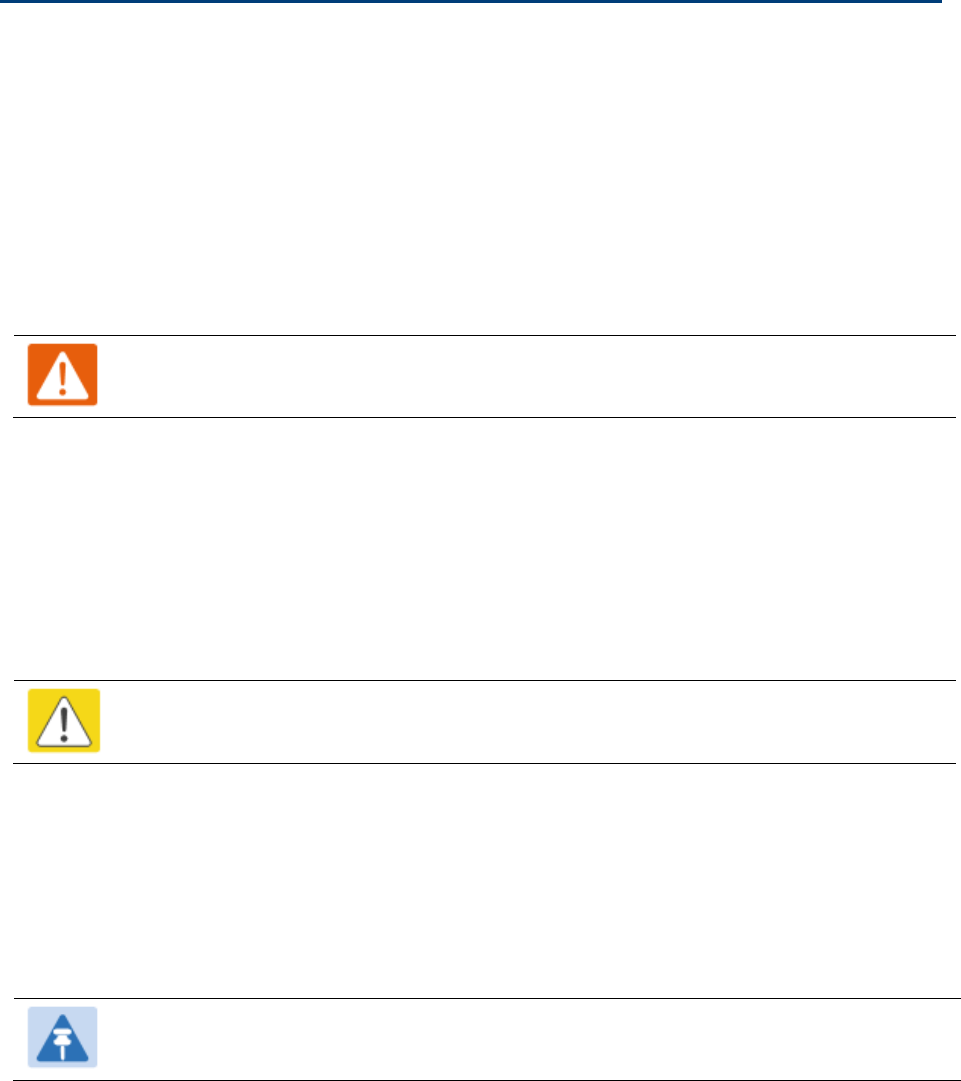
Chapter 1: Product description
Warnings, cautions, and notes
Page 10
Warnings, cautions, and notes
The following describes how warnings and cautions are used in this document and in all
documents of the Cambium Networks document set.
Warnings
Warnings precede instructions that contain potentially hazardous situations. Warnings are used to
alert the reader to possible hazards that could cause loss of life or physical injury. A warning has
the following format:
Warning
Warning text and consequence for not following the instructions in the warning.
Cautions
Cautions precede instructions and are used when there is a possibility of damage to systems,
software, or individual items of equipment within a system. However, this damage presents no
danger to personnel. A caution has the following format:
Caution
Caution text and consequence for not following the instructions in the caution.
Notes
A note means that there is a possibility of an undesirable situation or provides additional
information to help the reader understand a topic or concept. A note has the following format:
Note
Note text.

Chapter 1: Product description
Caring for the environment
Page 11
Caring for the environment
The following information describes national or regional requirements for the disposal of
Cambium Networks supplied equipment and for the approved disposal of surplus packaging.
In EU countries
The following information is provided to enable regulatory compliance with the European Union
(EU) directives identified and any amendments made to these directives when using Cambium
equipment in EU countries.
Disposal of Cambium equipment
European Union (EU) Directive 2002/96/EC Waste Electrical and Electronic Equipment (WEEE)
Do not dispose of Cambium equipment in landfill sites. For disposal instructions, refer to
http://www.cambiumnetworks.com/support/weee-compliance
Disposal of surplus packaging
Do not dispose of surplus packaging in landfill sites. In the EU, it is the individual recipient’s
responsibility to ensure that packaging materials are collected and recycled according to the
requirements of EU environmental law.
In non-EU countries
In non-EU countries, dispose of Cambium equipment and all surplus packaging in accordance with
national and regional regulations.

Page 1-1
Chapter 1: Product description
This chapter provides a high level description of 450 platform Series products. It describes in
general terms the function of the product, the main product variants and the main hardware
components. The following topics are described in this chapter:
Overview of the PMP/PTP 450 platform on page 1-2 introduces the key features, typical uses,
product variants and components of the PMP/PTP 450i and 450 series platform.
Wireless operation on page 1-14 describes how the PMP/PTP 450 platform wireless link is
operated, including modulation modes and spectrum management.
System management on page 1-18 introduces the PMP/PTP 450 platform management system,
including the web interface, configuration, security, alerts and recovery.

Chapter 1: Product description
Overview of the PMP/PTP 450 platform
Page 1-2
Overview of the PMP/PTP 450 platform
This section introduces the key features, typical uses, product variants and components of the
PMP/PTP 450 platform.
Purpose
Cambium PMP/PTP 450 platform Series products are designed for Ethernet bridging over point-to-
point and point-to-multipoint microwave links in unlicensed and lightly-licensed frequency bands
900MHz, 2.4 GHz, 3.5/3.65 GHz and 4.9 to 5.925 GHz.
Users must ensure that the 450 platform Series complies with local operating regulations.
The 450 platform Series acts as a transparent bridge between two or more segments of the
operator’s network. In this sense, it can be treated as a virtual wired connection among points. The
450 platform Series forwards 802.3 Ethernet frames destined for the other part of the network and
filters frames it does not need to forward. The system is transparent to higher-level protocols such
as VLANs.
PMP/PTP 450 platform Series
The 450 platform supports following series:
PMP 450m Series
PMP/PTP 450i Series
PMP/PTP 450 Series
PMP 450d Series
PMP 430 Series
PMP 450m Series
The PMP 450m Series AP is a revolutionary product which is based on Multi-User Multiple-input
and Multiple-Output (MU-MIMO) technology. By combining a sophisticated beam forming antenna
array with multiple transreceiver, Cambium Networks is using leading edge technology to provide
a substantial shift upward in capacity per sector.
Key features
The Cambium 450m platform AP offers the following benefits:
MU-MIMO Access Point is a technologically cutting edge device providing more than 300
Mbps depending upon SMs position within sector.
PMP 450m AP compatible with existing PMP 450/450i SM which help in upgrading existing
network
10x higher throughput packet rate

Chapter 1: Product description
Overview of the PMP/PTP 450 platform
Page 1-3
Integrated with 14x14 MU-MIMO antenna
Gigabit copper/power port combined, 100BaseT port with power outm SFP
Table 1 gives a summary of the main PMP 450m AP characteristics.
Table 1 Main characteristics of the PMP 450m Series AP
Characteristic
Value
Topology
PMP
Wireless link condition
LOS, near LOS or non-LOS
Range
PMP: Up to 40 mi (or 64 km)
Duplexing
TDD (symmetric and asymmetric)
Connectivity
1000Base-T Ethernet Main port with PoE input
Operating frequencies
5.150 to 5.925 GHz
Tx Power
max 24 dBm
Channel bandwidth
20 MHz
Timing synchronization
CMM5 or uGPS
Data rate
Up to 300 Mbps (20 MHz channel BW)
Frequency bands
The PMP 450m AP ODU operates in 5150 to 5825 MHz bands.
Hardware components
The ODU (Outdoor unit) is a self-contained transceiver unit that houses both radio and networking
electronics. The main hardware components of the PMP 450m Series is:
PMP 450m AP
The PMP 450m AP is supplied in the following configurations:
Table 2 PMP 450m Series hardware configurations
ODU
Frequency
ODU type
PMP 450m AP
5150 to 5925 MHz
Integrated
14 dBi, 90° sector antenna

Chapter 1: Product description
Overview of the PMP/PTP 450 platform
Page 1-4
PMP/PTP 450i Series
The PMP/PTP 450i is a high performance wireless bridge for Ethernet traffic. It is capable of
operating in line-of-sight (LOS), near-LOS and non-LOS propagation condition. It supports 900
MHz and 4.9 to 5.925 GHz frequency band.
Key features
The PMP/PTP 450i Series has extensive quality of service (QoS) classification capability.
The Cambium PMP/PTP 450i Series offers the following benefits:
Cambium’s highest performing point-to-multipoint solution, with up to 277 Mbps usable
throughput for PMP and PTP
State-of-the-art MIMO (Multi-In Multi-Out) technology
Upto 7.5 bps/Hz spectral efficiency
Increased Packet Processing rate
Efficient GPS synchronized, scheduled TDD operation for easy AP/BHM site deployment and
performance that is consistent regardless of SM/BHS loading
A range of cost-effective subscriber device solutions to meet the business case of any network
application
MIMO Matrix B: This technique provides for the ability to double the throughput of a radio
transmission under proper RF conditions. Different data streams are transmitted
simultaneously on two different antennas
MIMO-A mode: This mode of operation has same modulation levels as the MIMO-B mode,
namely: QPSK, 16-QAM, 64-QAM and 256-QAM. This mode increases system reliability in the
links.
Timing synchronization via CMM4 or uGPS
Table 3 gives a summary of the main PMP/PTP 450i characteristics.
Table 3 Main characteristics of the PMP/PTP 450i Series
Characteristic
Value
Topology
PMP/PTP
Wireless link condition
LOS, near LOS or non-LOS
Range
PTP Up to 186 mi (or 299 km) depending on configuration for
all bands
PMP: Up to 40 mi (or 64 km) for 5.x GHz band
PMP: Up to 120 mi (or 193 km) for 900 MHz band
Duplexing
TDD (symmetric and asymmetric)
Connectivity
1000Base-T Ethernet Main port with PoE input
Operating frequencies
902 to 928 MHz

Chapter 1: Product description
Overview of the PMP/PTP 450 platform
Page 1-5
4.9 to 5.925 GHz
Tx Power
max 27 dBm (5 GHz)
max 25 dBm (900 MHz)
Channel bandwidth
5, 7, 10, 15, 20 and 30 MHz
High spectral efficiency
Up to 7.5 bps/Hz
Timing synchronization
CMM4 or uGPS
Data rate
Up to 277 Mbps (30 MHz channel BW) for PMP/PTP

Chapter 1: Product description
Overview of the PMP/PTP 450 platform
Page 1-6
Frequency bands
The PMP/PTP 450i ODU can operate in the following bands:
900 MHz band: 902 to 928 MHz
5 GHz band: 4900 to 5925 MHz
o 5.1 GHz band: 5150 to 5250 MHz
o 5.2 GHz band: 5250 to 5350 MHz
o 5.4 GHz band: 5470 to 5725 MHz
o 5.8 GHz band: 5725 to 5925 MHz
Note
900 MHz band requires different hardware.
Hardware components
The ODU (Outdoor unit) is a self-contained transceiver unit that houses both radio and networking
electronics. The main hardware components of the PMP/PTP 450i are as follows:
PMP 450i AP
PMP 450i SM
PTP 450i BH (BHM/BHS)
The PMP/PTP 450i is supplied in the following configurations:
Table 4 PMP/PTP 450i Series hardware configurations
ODU
Frequency
ODU type
PMP 450i AP
902 to 928 MHz
Connectorized
Use with an external antenna
4.9 to 5.925 GHz
(support 4.9, 5.1, 5.2, 5.4
and 5.8 GHz)
Integrated
16 dBi, 90° sector antenna
Connectorized
Use with an external antenna
PMP 450i SM
4.9 to 5.925 GHz
(support 4.9, 5.1, 5.2, 5.4
and 5.8 GHz)
Integrated
23 dBi flat panel antenna
Connectorized
Use with an external antenna
PTP 450i BH
902 to 928 MHz
Connectorized
Use with an external antenna
4.9 to 5.925 GHz
(support 4.9, 5.1, 5.2, 5.4
and 5.8 GHz)
Integrated
23 dBi flat panel antenna
Connectorized
Use with an external antenna

Chapter 1: Product description
Overview of the PMP/PTP 450 platform
Page 1-7
Note
The BH ODU can be configured as a BHM or a BHS in PTP mode.
Warning
The PMP 450i AP 16 dBi, 90° sector antenna does not support frequency reuse
between collocated APs because of poor F/B ratio.
To achieve frequency re-use between collocated APs, please use the PMP 450i AP
Connectorized and external antennas.
For details on frequency planning, please see Radio Frequency planning on page 3-16.
PMP/PTP 450 Series
Cambium PMP/PTP 450 Series networks are designed for wireless point-to-multipoint and point-to-
point links in the unlicensed/licensed 900 MHz, 2.4 GHz, 3.5 GHz, 3.65 GHz, 5.4 GHz and 5.8 GHz
bands. Users must ensure that the PMP/PTP 450 Series complies with local operating regulations.
The PMP/PTP 450 Series enables network operators to grow their business by offering more
capacity for data, voice and video applications.
Key features
The Cambium PMP/PTP 450 Series offers the following benefits:
Cambium’s highest performing point-to-multipoint solution, with up to 227 Mbps usable
throughput
State-of-the-art MIMO (Multi-In Multi-Out) technology
Better spectral efficiency than other MIMO alternatives
Efficient GPS synchronized, scheduled TDD operation for easy Access Point site deployment
and performance that is consistent regardless of subscriber loading
A range of cost-effective subscriber device solutions to meet the business case of any network
application
MIMO Matrix B: This technique provides for the ability to double the throughput of a radio
transmission under proper RF conditions. Different data streams are transmitted
simultaneously on two different antennas.
MIMO-A mode: This mode of operation using the same modulation levels as the MIMO-B
mode, namely: QPSK, 16-QAM, 64-QAM and 256-QAM.
Table 5 gives a summary of the main PMP/PTP 450 characteristics.

Chapter 1: Product description
Overview of the PMP/PTP 450 platform
Page 1-8
Table 5 Main characteristics of the PMP/PTP 450 Series
Characteristic
Value
Topology
PMP/PTP
Wireless link condition
LOS, near LOS or non-LOS
Range
PTP: Up to 40 mi (or 64 km) depending on configuration for
all bands
PMP: Up to 40 mi (or 64 km) for 5.x GHz band
Duplexing
TDD (symmetric and asymmetric)
Connectivity
100Base-T Ethernet Main port with PoE input
Operating frequencies
900 MHz, 2.4 GHz, 3.5 GHz, 3.65 GHz and 5 GHz
Tx Power
max 27 dBm (2.4 GHz and 5 GHz)
max 25 dBm (3.5 GHz and 3.65 GHz
max 25 dBm (900 MHz - PMP 450 SM only)
Channel bandwidth
5, 7, 10, 15, 20 and 30 MHz
High spectral efficiency
Up to 7.5 bps/Hz
Data rate
Up to 227 Mbps (30 MHz channel BW) for PMP/PTP
Frequency bands
The PMP/PTP 450 Series ODU can operate in the following bands:
900 MHz band: 902 to 928 MHz (SM only)
2.4 GHz band: 2400 to 2483 MHz
3.5 GHz band: 3300 to 3600 MHz
3.65 GHz band: 3500 to 3850 MHz
5.4 GHz band: 5470 to 5725 MHz
5.8 GHz band: 5725 to 5875 MHz
Note
The 900 MHz, 2.4 GHz, 3.5 GHz, 3.65 GHz and 5 GHz bands require different hardware.
The 5 GHz band (either 5.4 or 5.8 GHz) can be configured on same hardware.

Chapter 1: Product description
Overview of the PMP/PTP 450 platform
Page 1-9
Hardware components
The main hardware components of the PMP/PTP 450 are as follows:
PMP 450 AP
PMP 450 SM
PTP 450 BH (BHM/BHS)
The PMP/PTP 450 is supplied in the following configurations:
Table 6 PMP/PTP 450 Series hardware configurations
ODU
Frequency
ODU type
PMP 450 AP
2.4 GHz
Connectorized
Use with an external antenna
Integrated
18 dBi Dual Slant
3.5/3.65 GHz
Connectorized
Use with an external antenna
Integrated
16 dBi Dual Slant
5 GHz
(5.4 and 5.8 GHz)
Connectorized
Use with an external antenna
Integrated
17 dBi H+V
PMP 450 SM
900 MHz
Connectorized
Use with an external antenna
2.4 GHz
Connectorized
Use with an external antenna
Integrated
7 dBi Dual Slant, integrated patch
3.5/3.65 GHz
Connectorized
Use with an external antenna
Integrated
8 dBi Dual Slant, integrated patch
Integrated
19 dBi Flat Plate, integrated patch
5 GHz
(5.4 and 5.8 GHz)
Connectorized
Use with an external antenna
Integrated
9 dBi H+V, integrated patch
Integrated
25 dBi H+V, Integrated dish
PTP 450 BH
3.5/3.65 GHz
Connectorized
Use with an external antenna
Integrated
8 dBi Dual Slant
5 GHz
(5.4 and 5.8 GHz)
Connectorized
Use with an external antenna
Integrated
9 dBi H+V
Note
The BH ODU can be configured as a BHM or a BHS in PTP mode

Chapter 1: Product description
Overview of the PMP/PTP 450 platform
Page 1-10
Supported interoperability for 450m/450i/450/430 platforms
The supported interoperability among various 450m/450i/450/430 hardware platforms are listed
below:
Table 7 Supported Interoperability for PMP
Band
AP platform
SM platform
5.1, 5.2, 5.4 and 5.8 GHz
PMP 450m AP
PMP 450i SM, PMP 450 SM
4.9, 5.1, 5.2 and 5.9 GHz
PMP 450i AP
PMP 450i SM (Greenfield)
5.4 and 5.8 GHz
PMP 450i AP
PMP 450i SM, PMP 450 SM, PMP 450d SM
and PMP 430 SM
PMP 450 AP
2.4, 3.5 and 3.65 GHz
PMP 450 AP
PMP 450 SM
900 MHz
PMP 450i AP
PMP 450 SM
Table 8 Supported Interoperability for PTP
Band
BH platform
900 MHz
PTP 450i BHM and BHS
3.5 and 3.65 GHz
PTP 450 BHM and BHS
4.9, 5.1, 5.2, 5.4 and 5.8 GHz
PTP 450i BHM and BHS
5.4 and 5.8 GHz
PTP 450 BHM and BHS
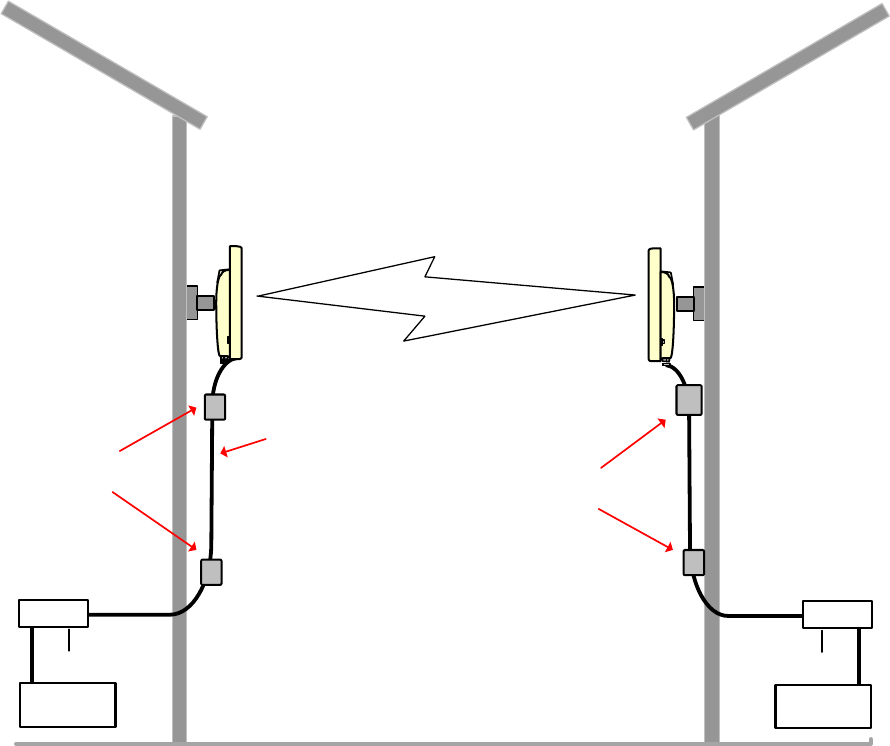
Chapter 1: Product description
Overview of the PMP/PTP 450 platform
Page 1-11
Typical deployment
The 450 platform is an “all outdoor” solution consisting of a wireless bridge across sites. Each site
installation consists of an Integrated or Connectorized outdoor unit (ODU) and a power supply
(PSU) (see Figure 1). The ODU provides the following interfaces:
Ethernet port: This provides proprietary power over Ethernet and connection to the
management and/or data networks.
Figure 1 PMP/PTP 450 platform typical bridge deployment
Building 1
ODU
AC supply
PSU
Network
equipment
Building 2
ODU
PSU
Network
equipment
AC supply
Power over Ethernet
interface Lightning
protection units
Lightning
protection units
Chapter 1: Product description
Overview of the PMP/PTP 450 platform
Page 1-12
Point-to-Multipoint
The PMP 450 platform Series consists of Access Point (AP) and Subscriber Module (SM) ODU. The
radio link operates on a single frequency channel in each direction using Time Division Duplex
(TDD).
Applications for the PMP Series include:
High throughput enterprise applications
nLOS video surveillance in metro areas
Urban area network extension
Network extension into areas with foliage
Point-to-Point (Backhaul)
The PTP 450 platform Series consists of two BH (Backhaul) ODUs. The customer can decide, via
software configuration, if this unit is a BHM (Backhaul Master) or a BHS (Backhaul Slave). The
radio link operates on a single frequency channel using Time Division Duplex (TDD).
Applications for the PTP Series include:
Enterprise Access
nLOS video surveillance
Leased line replacements and backup solutions
Network extension
Chapter 1: Product description
Overview of the PMP/PTP 450 platform
Page 1-13
Product variants
The PMP 450 platform Series is available in the following product variants:
The ODU is supplied in the following regional variants:
o FCC, intended for deployment in the USA
o EU, intended for deployment in countries of the European Union or other countries
following ETSI regulations
o Rest of the World (RoW), intended for deployment in countries other than USA and EU
countries.
o IC, intended for deployment in Canada
A ruggedized ODU Subscriber Module designed to meet IP-66 and IP-67 standards to
withstand harsh environments for 3 GHz band
An integrated Dish ODU Subscriber Module in a new, rugged and high gain design for 5 GHz
band
An indoor power supply module providing Power-over-Ethernet (PoE) supply to ODU
(AP/SM/BH)
Antennas and antenna cabling: Connectorized ODUs require external antennas connected
using RF cable
Ethernet cabling: All configurations require a copper Ethernet Cat5e connection from the ODU
(Ethernet port) to the PoE
Lightning protection unit (LPU): LPUs are installed in the ports copper drop cables to provide
transient voltage surge suppression
Surge Suppression: The Gigabit Surge Suppressor provides a path to ground (Protective Earth)
that protects connected radio equipment from near-miss lightning strikes.
Ground cables: ODU, LPUs and outdoor copper Ethernet cables are bonded to the site
grounding system using ground cables.
For more information about these components, including interfaces, specifications and Cambium
part numbers, refer to Chapter 2: System hardware.
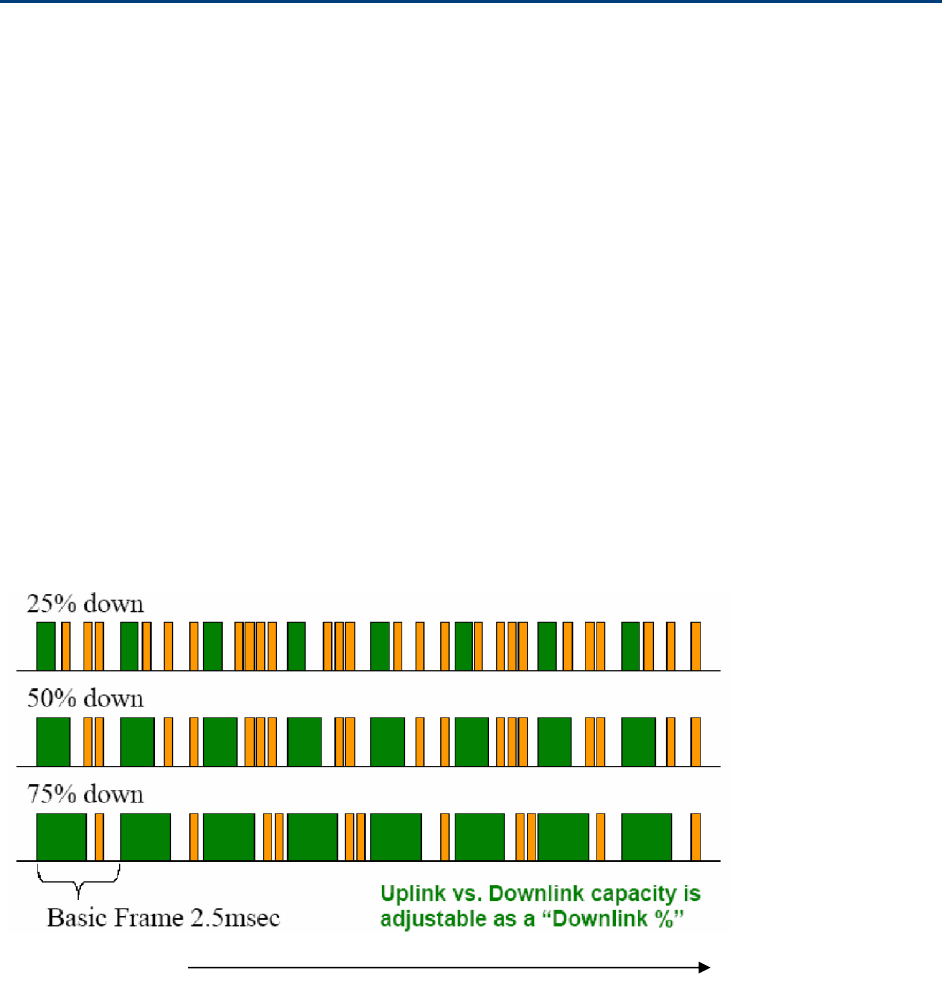
Chapter 1: Product description
Wireless operation
Page 1-14
Wireless operation
This section describes how the PMP/PTP 450 platform wireless link is operated, including
modulation modes, power control and security.
Time division duplexing
The system uses Time Division Duplexing (TDD) – one channel alternately transmits and receives
rather than using one channel for transmitting and a second channel for receiving. To accomplish
TDD, the AP/BHM must provide sync to its SM/BHS. Furthermore, collocated APs/BHMs must be
synced together – an unsynchronized AP/BHM that transmits during the receive cycle of a
collocated AP/BHM can prevent a second AP/BHM from being able to decode the signals from its
APs/BHSs. In addition, across a geographical area, APs/BHMs that can “hear” each other benefit
from using a common sync to further reduce self-interference within the network.
Modules use TDD on a common frequency to divide frames for uplink (orange) and downlink
(green) usage, as shown in the figure below.
For more information on synchronization configuration options, see GPS synchronization on page
2-34.
Figure 2 TDD frame division
Time

Chapter 1: Product description
Wireless operation
Page 1-15
TDD frame parameters
The TDD burst duration varies depending on the following:
Channel Bandwidth
Cyclic Prefix
Frame Period
Frame configuration - Downlink Data
Link operation – Dynamic Rate Adaptation
OFDM and channel bandwidth
The PMP/PTP 450 platform Series transmits using Orthogonal Frequency Division Multiplexing
(OFDM). This wideband signal consists of many equally spaced sub-carriers. Although each sub
carrier is modulated at a low rate using conventional modulation schemes, the resultant data rate
from the sub-carriers is high. OFDM works exceptionally over a Non-Line-of-Sight (NLoS) channel.
The channel bandwidth of the OFDM signal is configurable to one of the following values: 5, 7, 10,
15, 20 and 30 MHz. Higher bandwidths provide greater link capacity at the expense of using more
bandwidth. Systems configured for a narrower channel bandwidth provide better receiver
sensitivity and can also be an appropriate choice in deployments where the amount of free
spectrum is limited.
Note
The channel bandwidth must be configured to the same value at both ends of the link.
Not all channel bandwidths are available in all regulatory bands.
Cyclic Prefix
OFDM technology uses a cyclic prefix, where a portion of the end of a symbol (slot) is repeated at
the beginning of the symbol (slot) to allow multi-pathing to settle before receiving the desired
data. A 1/16 cyclic prefix means that for every 16 bits of throughput data transmitted, an additional
bit is used. For your convenience, the 450 and 450i products have been locked to a 1/16 CP.
Frame Period
The frame period or frame duration is the time between the beginning of a frame and the end of
the frame. The PMP/PTP 450 platform Series supports two frame periods: 2.5 ms and 5 ms.
The 5ms frame period configuration provides higher throughput as a result of reduced frame
overhead during transmission. In turn, the 2.5 ms frame period configuration affords reduced
latency in the system, half of that introduced by the 5 ms frame configuration.

Chapter 1: Product description
Wireless operation
Page 1-16
Frame configuration - Downlink Data
The percentage of frame assigned to transport downlink data. The downlink data specifies the
percentage of the aggregate throughput for the downlink (frames transmitted from the AP/BHM to
the subscriber). The configurable range is 15 to 85 percent.
Link operation – Dynamic Rate Adapt
PMP/PTP 450 platform Series products offer eight levels or speeds of operation – 2X MIMO-B and
1X MIMO-A (QPSK), 4X MIMO-B and 2X MIMO-A (16-QAM), 6x MIMO-B and 3X MIMO-A (64-QAM)
and 8X MIMO-B and 4X MIMO-A (265-QAM). If received power is less due to distance between the
AP/BHM and the SM/BHS or due to obstructions, or if interference affects the RF environment, the
system automatically and dynamically adjusts the links to the best operation level.
The system chooses its modulation rate dynamically, based on an internal ARQ (Automatic Repeat
reQuest) error control method. With ARQ, every data slot of every frame sent over the air (except
downlink broadcast) is expected to be acknowledged by the receiver, and if acknowledgement is
not received, the data is resent. The sending unit monitors these re-sends and adjusts the
modulation rate accordingly. It is normal to have links that change levels of operation as the RF
environment changes. Furthermore, the uplink or downlink portions of TDD duty cycle operate
independently; normal operation can have a downlink running at 6x while the uplink RF
environment only supports 2x.
The various modulation levels used by the PMP/PTP 450 platform are shown in Table 9.
Table 9 Modulation levels
Rate
MIMO-B
MIMO-A
QPSK
2X MIMO-B
1X MIMO-A
16-QAM
4X MIMO-B
2X MIMO-A
64-QAM
6X MIMO-B
3X MIMO-A
256-QAM
8X MIMO-B
4X MIMO-A
Note
MIMO-A achieves half the throughput of MIMO-B but adds a combining diversity (gain)
which enhances the link budget or availability.
Chapter 1: Product description
Wireless operation
Page 1-17
MIMO
Multiple-Input Multiple-Output (MIMO) techniques provide protection against fading and increase
the probability that the receiver decodes a usable signal. When the effects of MIMO are combined
with those of OFDM techniques and a high link budget, there is a high probability of a robust
connection over a non-line-of-sight path.
The sub-features that comprises the MIMO techniques utilized in the PMP/PTP 450 platform
product are:
Matrix A: This technique enables the 450 platform radio to use a scheme that optimizes
coverage by transmitting the same data over
both antennas. This redundancy improves the
signal to noise ratio at the receiver making it more
robust, at the cost of throughput.
Matrix B: This technique provides for the ability to double the throughput of a radio
transmission under proper RF conditions. Different data streams are transmitted
simultaneously on two different antennas.
Encryption
The Cambium 450 platform Series supports optional encryption for data transmitted over the
wireless link. The PTP 450 platform Series supports the following forms of encryption for security
of the wireless link:
DES (Data Encryption Standard): An over-the-air link encryption option that uses secret 56-bit
keys and 8 parity bits. DES performs a series of bit permutations, substitutions, and
recombination operations on blocks of data. DES encryption does not affect the performance
or throughput of the system.
AES (Advanced Encryption Standard): An over-the-air link encryption option that uses the
Rijndael algorithm and 128-bit keys and 256-bit key size to establish a higher level of security
than DES. AES products are certified as compliant with the Federal Information Processing
Standards (FIPS 197) in the U.S.A.
The default setting on an AP is "Disabled".

Chapter 1: Product description
System management
Page 1-18
System management
This section introduces the PMP/PTP 450 platform management system, including the web
interface, installation, configuration, alerts and upgrades.
Management agent
PMP/PTP 450 platform equipment is managed through an embedded management agent.
Management workstations, network management systems or PCs can be connected to this agent
using the module’s Ethernet port or over-the air (SM/BHS)
The management agent supports the following interfaces:
Hypertext transfer protocol (HTTP)
Hypertext transfer protocol secure (HTTPS)
RADIUS authentication
Simple network management protocol (SNMP) – v2c and v3
Network time protocol (NTP)
System logging (Syslog)
Wireless Manager (WM) software
Canopy Network Updater Tool (CNUT) software
Web server
The PMP/PTP 450 platform management agent contains a web server. The web server supports
access via the HTTP/HTTPS interface.
Web-based management offers a convenient way to manage the PMP/PTP 450 platform equipment
from a locally connected computer or from a network management workstation connected
through a management network, without requiring any special management software. The web
and SNMP are the interfaces supported for installation of 450 platform equipment and for the
majority of configuration management tasks.
Chapter 1: Product description
System management
Page 1-19
Web pages
The web-based management interfaces provide comprehensive web-based fault, configuration,
performance and security management functions organized into the following groups:
Access Point or Backhaul Master:
Home
Configuration
Statistics
Tools
Logs
Accounts
Quick Start
Copyright
Subscriber Module or Backhaul Slave
Home
Configuration
Statistics
Tools
Logs
Accounts
PDA
Copyright
Identity-based user accounts
When identity-based user accounts are configured, a security officer can define from one to
four user accounts, each of which may have one of the four possible roles:
ADMINISTRATOR, who has full read and write permissions. This is the level of the root and
admin users, as well as any other administrator accounts that one of them creates.
INSTALLER, who has permissions identical to those of ADMINISTRATOR except that the
installer cannot add or delete users or change the password of any other user.
TECHNICIAN, who has permissions to modify basic radio parameters and view informational
web pages
GUEST, who has no write permissions and only a limited view of General Status tab
Admin, Installer and Tech accounts can be configured as READ-ONLY. This will allow the
account to only see the items.
See Managing module access by passwords for detailed information on account permissions.

Chapter 1: Product description
System management
Page 1-20
Remote Authentication Dial-in User Service (RADIUS)
The PMP 450 platform system includes support for RADIUS (Remote Authentication Dial In User
Service) protocol functionality including:
Authentication: Allows only known SMs onto the network (blocking “rogue” SMs), and can be
configured to ensure SMs are connecting to a known network (preventing SMs from
connecting to “rogue” APs). RADIUS authentication is used for SMs, but not used for APs.
SM Configuration: Configures authenticated SMs with MIR (Maximum Information Rate), High
Priority, and VLAN (Virtual LAN) parameters from the RADIUS server when a SM registers to
an AP.
SM Accounting provides support for RADIUS accounting messages for usage-based billing.
This accounting includes indications for subscriber session establishment, subscriber session
disconnection, and bandwidth usage per session for each SM that connects to the AP.
Centralized AP and SM user name and password management: Allows AP and SM usernames
and access levels (Administrator, Installer, Technician and Read-Only) to be centrally
administered in the RADIUS server instead of on each radio and tracks access events
(logon/logoff) for each username on the RADIUS server. This accounting does not track and
report specific configuration actions performed on radios or pull statistics such as bit counts
from the radios. Such functions require an Element Management System (EMS) such as
Cambium Wireless Manager. This accounting is not the ability to perform accounting functions
on the subscriber/end user/customer account.
Framed-IP-Address: Operators may use a RADIUS server to assign management IP addressing
to SM modules.
SNMP
The management agent supports fault and performance management by means of an SNMP
interface. The management agent is compatible with SNMP v2c and SNMP v3 using Management
Information Base (MIB) files which are available for download from the Cambium Networks
Support website:
https://support.cambiumnetworks.com/files/ptp450
https://support.cambiumnetworks.com/files/pmp450
Network Time Protocol (NTP)
The clock supplies accurate date and time information to the system. It can be set to run with or
without a connection to a network time server (NTP). It can be configured to display local time by
setting the time zone and daylight saving in the Time web page.
If an NTP server connection is available, the clock can be set to synchronize with the server time at
regular intervals. PMP/PTP 450 platform devices may receive NTP data from a CMM4 module or an
NTP server configured in the system’s management network.

Chapter 1: Product description
System management
Page 1-21
The Time Zone option is configurable on the AP’s/BHM’s Time Configuration page, and may be
used to offset the received NTP time to match the operator’s local time zone. When set on the
AP/BHM, the offset is set for the entire sector (AP/BHSs is notified of the current Time Zone upon
initial registration). If a Time Zone change is applied, the AP/BHSs are notified of the change in a
best effort fashion, meaning some AP/BHSs may not pick up the change until the next re-
registration. Time Zone changes are noted in the Event Log.
An AP/BHM which is receiving NTP date and time information from an NTP server or from a GPS
synchronization source may be used as an NTP server. Any client which has IP connectivity to the
BHM may request NTP date and time information from the AP/BHM. No additional configuration
(other than the AP/BHM receiving valid NTP data) is required to use the AP/BHM as an NTP server.
Wireless Manager (WM)
Cambium Networks Wireless Manager 4.0 is recommended for managing PMP/PTP 450 platform
networks. You can achieve better uptime through better visibility of your network with the
Cambium Wireless Manager. This network management software tool offers breakthrough map-
based visualization capabilities using embedded Google maps, and combined with advanced
configuration, provisioning, alerting and reporting features you can control your entire outdoor
wireless network including Point-to-Multipoint and Point-to-Point solutions as well as other SNMP
enabled devices. With its powerful user interface you can not only be able to control your
network's access, distribution and backhaul layers, but can also have visibility to WLAN sites and
be able to quickly launch indoor network management systems. Some key features of Wireless
Manager are:
Template-Based Configuration: With Wireless Manager's user-defined templates you can
accelerate the process for the configuration of the devices you add to your network resulting in
quicker and easier deployments. The template-based functionality provides an automated way
to configure large numbers of network devices with just a few mouse clicks, and can be
scheduled to occur at any time via Wireless Manager's Task Scheduler.
Ultralight Thin Client: With the growing mobile workforce it is important to have access to the
status of your network at any time. With Wireless Manager you can view the status and
performance of your entire wireless network via a compact web interface accessible by your
smart phone.
Map-Based Visualization: Wireless Manager overlays sophisticated real-time information about
your network elements onto building layouts and dynamic Google maps. Visuals can be scaled
to view an entire city or building or a specific area, floor or link.
High Availability Architecture Support: Wireless Manager offers a high availability option,
providing a highly reliable and redundant network management solution that ensures you
always have management access to your network.
High Scalability: The enhanced Wireless Manager offers you server scalability with support for
up to 10,000 nodes as well as support for distributed server architecture.
Cambium’s Wireless Manager 4.0 available for download at:
http://www.cambiumnetworks.com/support/management-tools/wireless-manager/

Chapter 1: Product description
System management
Page 1-22
Canopy Network Updater Tool (CNUT)
CNUT (Canopy Network Updater Tool) is the stand-alone software update tool for 450 platform
Series products. The CNUT 4.9.12 or greater should be used for 450 platform radios.
The Canopy Network Updater Tool has the following features:
Automatically discovers all network elements
HTTP and HTTPS
Executes UDP command that initiates and terminates the Auto-update mode within APs/BHMs.
This command is both secure and convenient:
o For security, the AP/BHM accepts this command from only the IP address that specified in
the Configuration page of ODU.
o For convenience, Network Updater automatically sets this Configuration parameter in the
AP/BHM to the IP address of the Network Updater server when the server performs any of
the update commands.
Allows you to choose among updating:
o Entire network.
o Only elements that you select.
o Only network branches that you select.
Provides a Script Engine that you can use with any script which:
o The user can define.
o Cambium supplies.
CNUT is available at:
http://www.cambiumnetworks.com/support/management-tools/cnut/
Radio recovery mode
The 450 platform recovery mode provides a means to recover from serious configuration errors
including lost or forgotten passwords and unknown IP addresses.
The recovery procedure for PMP/PTP 450i series and PMP/PTP 450 series differs due to difference
in hardwares. This procedure for PMP/PTP 450i is known as Radio Recovery Console and for
PMP/PTP 450 is known as Default mode (or Default/Override Plug).
Radio Recovery Console – PMP/PTP 450i Series
The Radio Recovery Console mode supports:
Restoring factory default IP address 169.254.1.1 and password
Boot with factory default Canopy system software settings
Load previously installed SW images
See Radio Recovery Console– PMP/PTP 450i on page 9-61.
Chapter 1: Product description
System management
Page 1-23
Default Mode (or Default Plug) – PMP/PTP 450 Series
A default plug is available to provide access to a module whose password and/or IP address have
been forgotten.
This plug allows the PMP/PTP 450 to be accessed using IP address 169.254.1.1 and no password.
During the override session, you can assign any new IP address and set either or both user
passwords (display-only and/or full access) as well as make other parameter changes.
See Default Mode (or Default/Override Plug) - PMP/PTP 450 on page 9-63.

Page 2-1
Chapter 2: System hardware
This chapter describes the hardware components of a PMP/PTP 450 platform link.
The following topics are described in this chapter:
System Components on page 2-2 describes system components of PTP and PMP including its
accessories
Cabling and lightning protection on page 2-22 describes various cable and lightning protection
Antennas and antenna cabling on page 2-31 describes supported antennas and its accessories
GPS synchronization on page 2-34 describes UGPS and CMM4.
Ordering the components on page 2-43 specifies Cambium part numbers for PMP/PTP 450
platform components

Chapter 2: System hardware
System Components
Page 2-2
System Components
Point-to-Multipoint (PMP)
The PMP radio is a transceiver device. It is a connectorized or radiated outdoor unit containing all
the radio, networking, and surge suppression electronics. It can be purchased as:
Access Point Module (AP)
Subscriber Module (SM)
PMP 450 platform Integrated or Connectorized ODU
The PMP 450m and PMP 450i and PMP 450 ODUs are supplied in Integrated or Connectorized
configurations.
See Table 2 PMP 450m Series hardware configurations on page 1-3
See Table 4 PMP/PTP 450i Series hardware configurations on page 1-6
See Table 6 PMP/PTP 450 Series hardware configurations on page 1-9
Product variants
Table 10 PMP 450m variants
Variant
Region
Antenna
Frequency
Range
Channel
Bandwidth
Max Tx
Power
5 GHz
PMP 450m AP
FCC
90° integrated
sector
5150 – 5925
MHz
20 MHz
24 dBm
RoW
EU
DES only
IC

Chapter 2: System hardware
System Components
Page 2-3
Table 11 PMP 450i variants
Variant
Region
Antenna
Frequency
Range
Channel
Bandwidth
Max Tx
Power
900 MHz PMP
450i AP
FCC
Connectorized
902 - 928 MHz
5, 7, 10, 20 MHz
25 dBm
5 GHz
PMP 450i AP
FCC
Connectorized
4900 – 5925
MHz
5, 10, 15, 20, 30
MHz
27 dBm
Integrated 16 dBi
90 degree
RoW
Connectorized
Integrated 23 dBi
Canada
Connectorized
Integrated 23 dBi
RoW DES
Connectorized
Integrated 23 dBi
5 GHz
PMP 450i SM
FCC
Connectorized
4900 – 5925
MHz
5, 10, 15, 20, 30
MHz
27 dBm
Integrated 23 dBi
RoW
Connectorized
Integrated 23 dBi
Canada
Connectorized
Integrated 23 dBi
RoW DES
Connectorized
Integrated 23 dBi
Note
The Transmit power is limited based on regional setting.

Chapter 2: System hardware
System Components
Page 2-4
Table 12 PMP 450 variants
Variant
Region
Antenna
Frequency
Range
Channel
Bandwidth
Max Tx
Power
900 MHz PMP
450 SM
FCC
Connectorized
902 - 928 MHz
5, 7, 10, 20 MHz
25 dBm
2.4 GHz PMP
450 AP
FCC ISM
Connectorized
2400 – 2483.5
MHz
5, 10, 15, 20, 30
MHz
22 dBm
Integrated 18 dBi
2.4 GHz PMP
450 SM
FCC ISM
Connectorized
2400 – 2483.5
MHz
5, 10, 15, 20, 30
MHz
22 dBm
Integrated 7 dBi
3.5 GHz PMP
450 AP
FCC ISM
Connectorized
3300 – 3600
MHz
5, 7, 10, 15, 20,
30 MHz
25 dBm
Integrated 16 dBi
3.5 GHz PMP
450 SM
FCC ISM
Connectorized
3300 – 3600
MHz
5, 7, 10, 15, 20,
30 MHz
25 dBm
Integrated 8 dBi
Integrated 19 dBi
3.65 GHz PMP
450 AP
FCC ISM
Connectorized
3500 – 3850
MHz
5, 7, 10, 15, 20,
30 MHz
25 dBm
Integrated 16 dBi
3.65 GHz PMP
450 SM
FCC ISM
Connectorized
3500 – 3850
MHz
5, 7, 10, 15, 20,
30 MHz
25 dBm
Integrated 8 dBi
Integrated 19 dBi
5.4/5.8 GHz
PMP 450 AP
FCC
Connectorized
5470 – 5875
MHz
10, 20 MHz (5,
15 and 30 MHz
not available in
DFS regions)
22 dBm
Integrated 17 dBi
RoW
Connectorized
Integrated 17 dBi
Canada
Connectorized
Integrated 17 dBi
RoW DES
Connectorized
Integrated 23 dBi
5.4/5.8 GHz
PMP 450 SM
FCC, ROW,
Canada,
RoW DES
Connectorized
5470 – 5875
MHz
10, 20 MHz (5,
15 and 30 MHz
not available in
DFS regions)
22 dBm
Integrated 9 dBi
Integrated 25 dBi

Chapter 2: System hardware
System Components
Page 2-5
Note
The Transmit power is limited based on regional setting.
Backhaul (PTP)
The Backhaul radio is a transceiver device. It is a connectorized or integrated outdoor unit
containing all the radio, networking, and surge suppression electronics. It can be configured as:
Backhaul Master (BHM)
Backhaul Slave (BHS)
PTP 450 platform Integrated or Connectorized ODU
See Table 4 PMP/PTP 450i Series hardware configurations on page 1-6
See Table 6 PMP/PTP 450 Series hardware configurations on page 1-9
Product variants
Table 13 PTP 450i variants
Variant
Region
Antenna
Frequency
Range
Channel
Bandwid
th
Max Tx
Power
Notes
5 GHz
PTP 450i
FCC
Connectorized
4900 – 5925
MHz
5, 10, 15,
20, 30
MHz
27 dBm
Transmit power
limited based
on regional
setting
Integrated 23 dBi
RoW
Connectorized
Integrated 23 dBi
Canada
Connectorized
Integrated 23 dBi
RoW
DES
Connectorized
Integrated 23 dBi
900 MHz
PTP 450i
FCC
Connectorized
902 - 928
MHz
5, 7, 10,
20 MHz
25 dBm

Chapter 2: System hardware
System Components
Page 2-6
Table 14 PTP 450 variants
Variant
Region
Antenna
Frequency
Range
Channel
Bandwidth
Max Tx
Power
3.5 GHz PTP
450 BH
ROW
Connectorized
3300 – 3600
MHz
5, 7, 10, 15,
20, 30 MHz
25 dBm
Integrated 16 dBi
Integrated 19 dBi
3.65 GHz PTP
450 BH
ROW
Connectorized
3500 – 3850
MHz
5, 7, 10, 15,
20, 30 MHz
25 dBm
Integrated 16 dBi
Integrated 19 dBi
5.4/5.8 GHZ
PTP 450 BH
FCC
Connectorized
5470 – 5875
MHz
5, 10, 15, 20,
30 MHz
22 dBm
Integrated 17 dBi
5 GHz
PTP 450 BH
FCC
Connectorized
4900 – 5875
MHz
5, 10, 15, 20,
30 MHz
22 dBm
Integrated 23 dBi
RoW
Connectorized
Integrated 23 dBi
Canada
Connectorized
Integrated 23 dBi
RoW DES
Connectorized
Integrated 23 dBi
Note
The Transmit power is limited based on regional setting.
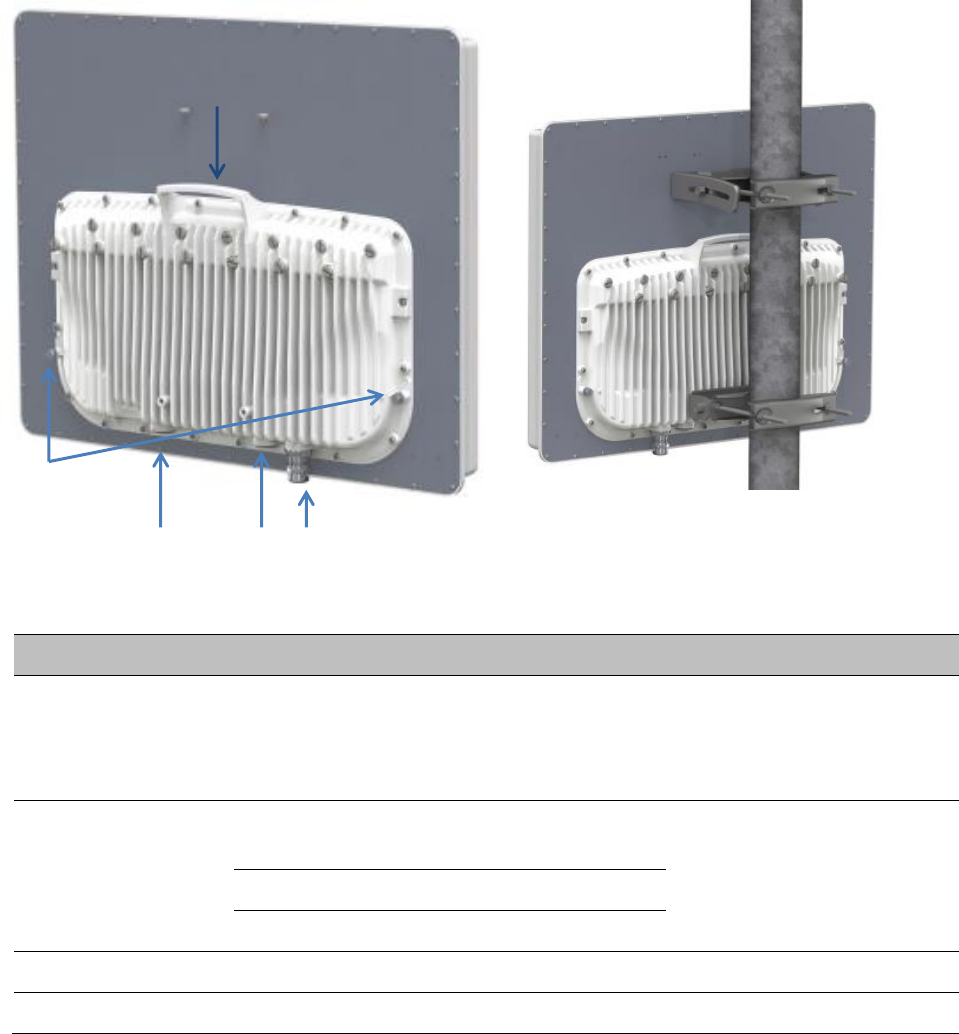
Chapter 2: System hardware
System Components
Page 2-7
PMP/PTP 450 platform interfaces
PMP 450m interfaces – AP
The 450m AP interfaces is illustrated below.
Figure 5 PMP 450m interfaces
Table 15 PMP 450m AP interface descriptions and cabling
Interface
Function
Cabling
PSU/Ethernet
Power-over-Ethernet, Ethernet
communications (management and data),
CMM sync-over-power synchronization
input
RJ45 Cable
See Table 76 on page 5-11
Aux/Sync
GPS synchronization input and output,
UGPS power output
RJ 45 Cable
See Table 77 on page 5-11
Audio tones
Data
SFP
Data
Ground Lugs
For grounding the unit
10 AWG copper wire
Ground
Lugs
Carabiner clip
PSU/Ethernet
SFP
AUX
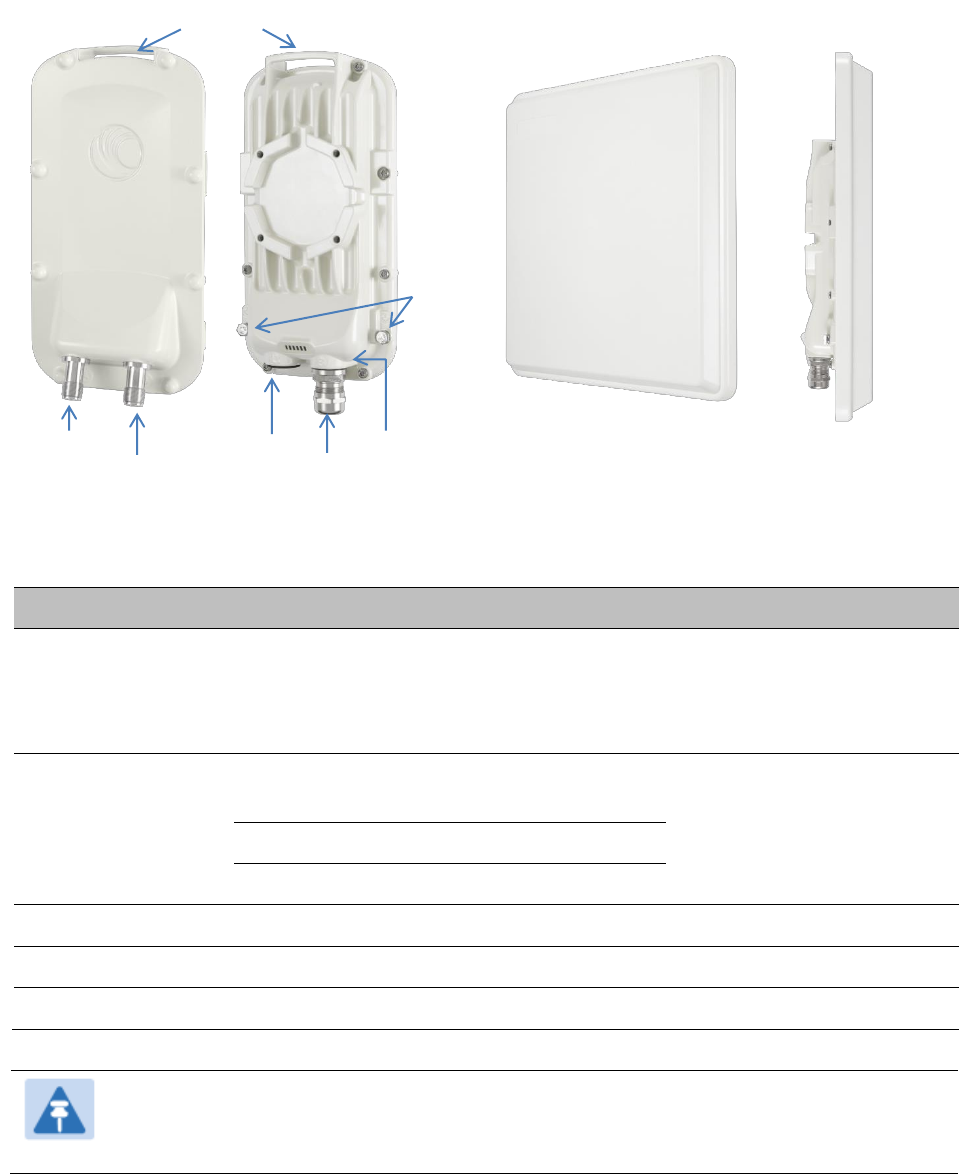
Chapter 2: System hardware
System Components
Page 2-8
PMP/PTP 450i interfaces – AP/SM/BH
The AP/SM/BH interfaces are illustrated below.
Figure 5 PMP/PTP 450i interfaces
Table 16 AP/SM/BH interface descriptions and cabling
Interface
Function
Cabling
PSU/Ethernet
Power-over-Ethernet, Ethernet
communications (management and data),
CMM sync-over-power synchronization
input
RJ45 Cable
See Table 76 on page 5-11
Aux/Sync
GPS synchronization input and output,
UGPS power output
RJ 45 Cable
See Table 77 on page 5-11
Audio tones
Data
RF Port A
Vertical RF connection to antenna
50 ohm RF cable, N-type
RF Port B
Horizontal RF connection to antenna
50 ohm RF cable, N-type
Ground Lugs
For grounding the unit
10 AWG copper wire
Note
If the Aux port will be used, a second ethernet Gland will need to be ordered (Part
Number: N000065L033A).
RF port A
RF port B
Carabiner clip
Aux
Ground
Lug
ENET
Gland
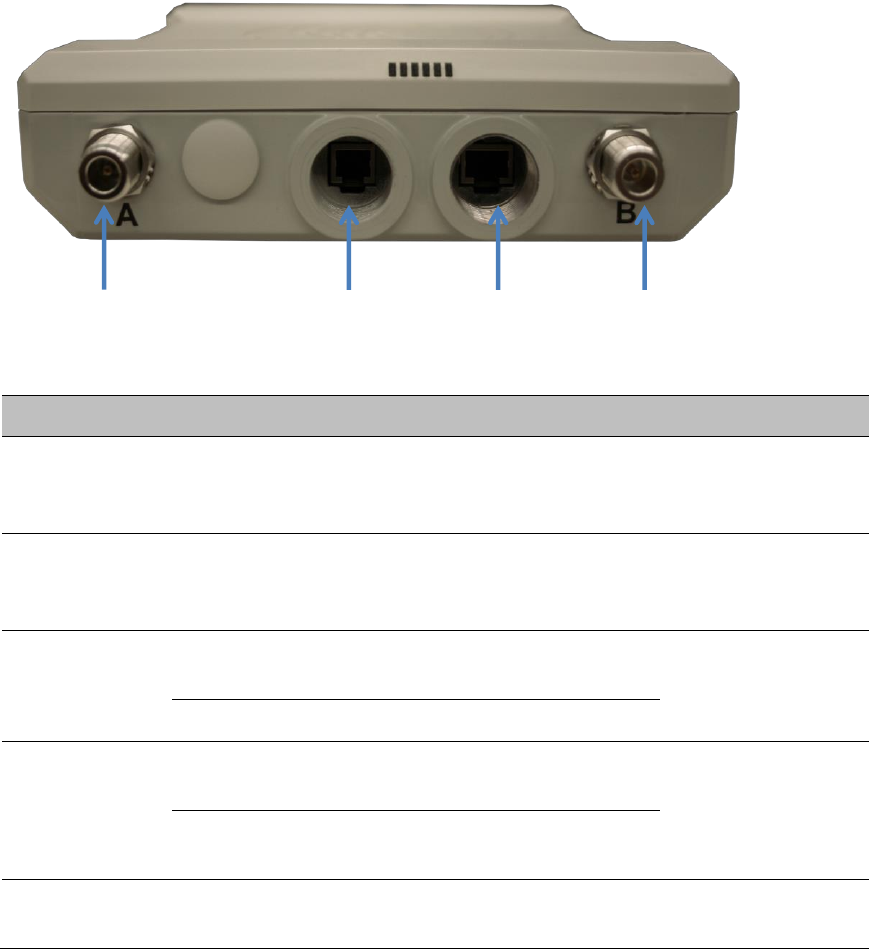
Chapter 2: System hardware
System Components
Page 2-9
PMP/PTP 450 interfaces - AP
The PMP 450 AP interfaces are illustrated below.
Figure 3 PMP/PTP 450 interfaces - AP
Table 17 AP interface descriptions and cabling – 2.4 GHz, 5 GHz
Interface
Function
Cabling
PSU/Ethernet
Power-over-Ethernet, Ethernet
communications (management and
data)
RJ45 Cable
Sync/Default
GPS synchronization signaling,
provides power to UGPS module.
Default plug port.
RJ11 cable, default
plug.
RF Port A
2.4 GHz
-45 degree RF connection to AP
antenna
50 ohm RF cable,
N-type
5 GHz
Vertical RF connection to AP antenna
RF Port B
2.4 GHz
+45 degree RF connection to AP
antenna
50 ohm RF cable,
N-type
5 GHz
Horizontal RF connection to AP
antenna
Ground Lugs
For grounding the unit
10 AWG copper
wire
RF Port A
Sync/Default
Ethernet
RF port B
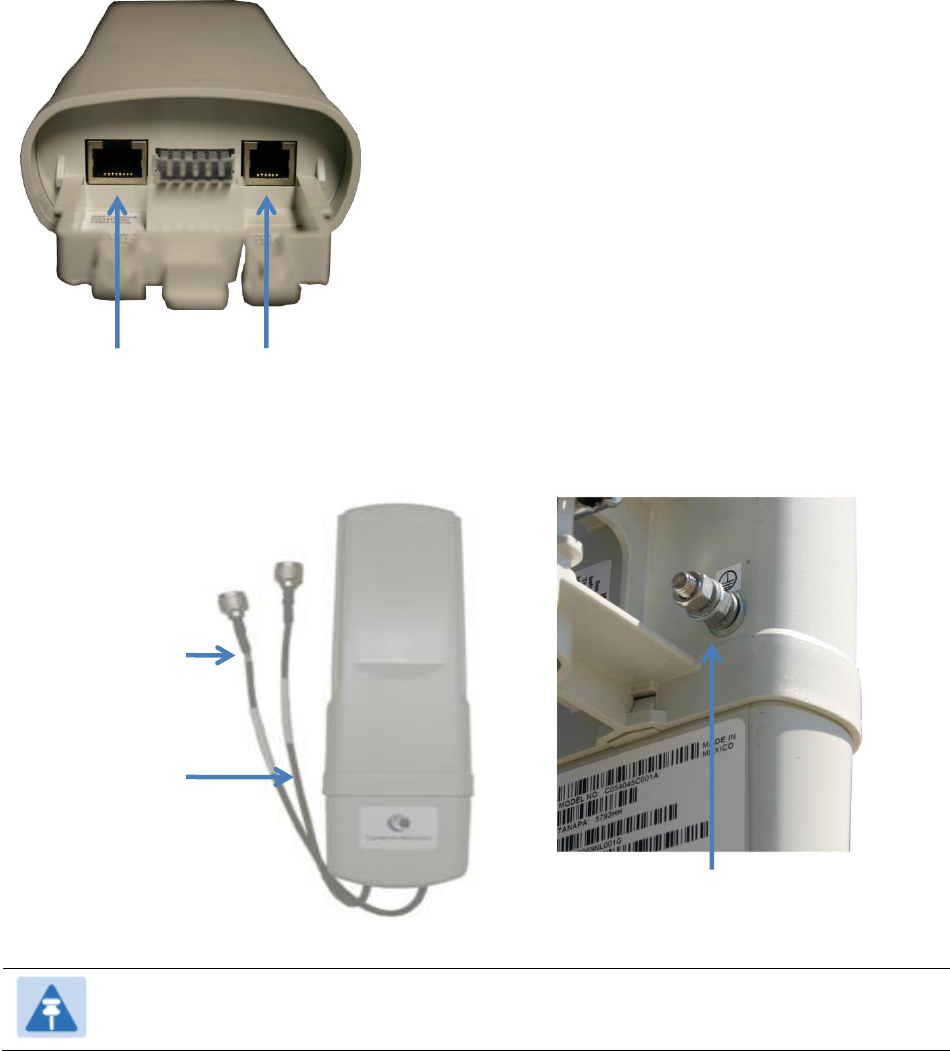
Chapter 2: System hardware
System Components
Page 2-10
PMP/PTP 450 interfaces – SM/BH
The PMP 450 SM/BH interfaces are illustrated below.
Figure 4 PMP/PTP 450 interfaces – SM/BH
Figure 5 PMP/PTP 450 interfaces – SM/BH Connectorized
Note
As per UL guidelines, the Ground Lug on the radiated SM is not required.
Ethernet
Sync/Default
External antenna
cable path A
(labeled “A”)
Ground (connectorized models)
External antenna
cable path B
(labeled “B”)

Chapter 2: System hardware
System Components
Page 2-11
Figure 6 PMP 450d SM - Integrated Dish
Figure 7 PMP 450 Series – 3 GHz Integrated SM
Figure 8 PTP 450 Series – BHM/BHS
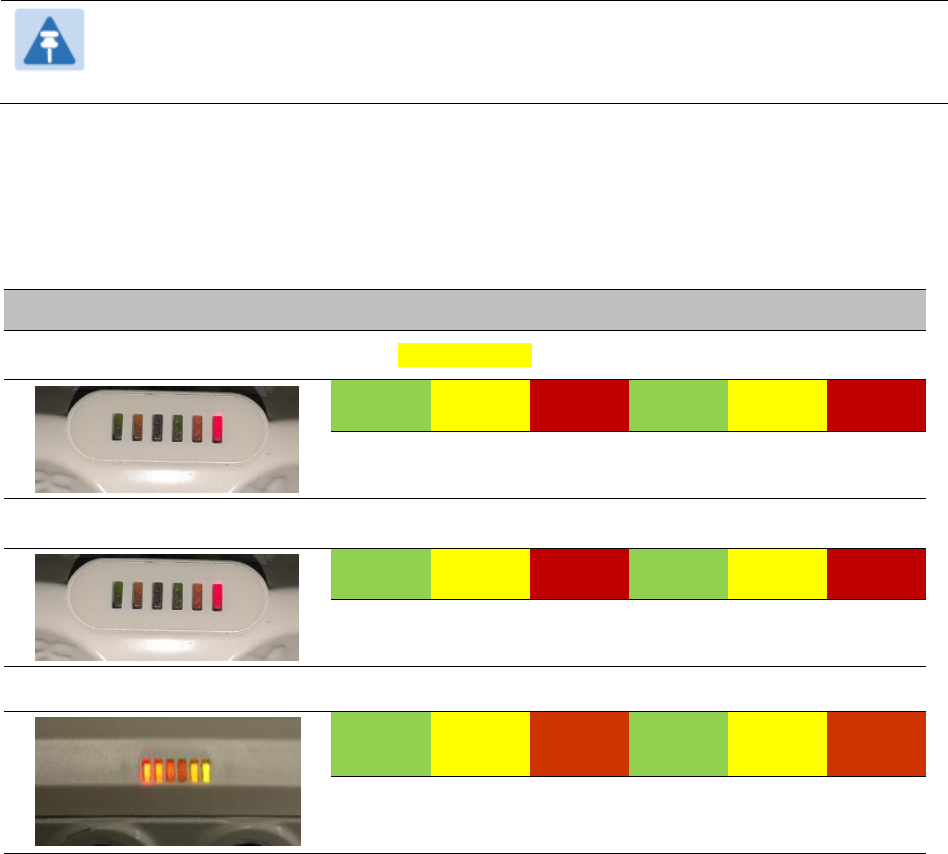
Chapter 2: System hardware
System Components
Page 2-12
Diagnostic LEDs
The diagnostic LEDs of PMP/PTP 450 platform Series are as shown below.
Note
The LED color helps distinguish the position of LED. The LED color does not indicate
any status.
AP/BHM LEDs
The diagnostic LEDs report the information about the status of the AP/BHM.
Figure 9 AP/BHM diagnostic LEDs, viewed from unit front
ODU LED Display
LED Labels
PMP 450m AP
LNK/5
ACT/4
GPS/3
SES/2
SYN/1
PWR
PMP 450i AP/BHM
LNK/5
ACT/4
GPS/3
SES/2
SYN/1
PWR
PMP 450 AP/BHM
LNK/5
ACT/4
GPS/3
SES/2
SYN/1
PWR

Chapter 2: System hardware
System Components
Page 2-13
Table 18 AP/BHM LED descriptions
LED
Color when active
Status information
provided
Notes
PWR
Red
DC power
Always lit after 10-20 seconds of power
on.
SYN/1
Yellow
Presence of sync
-
SES/2
Green
Unused
-
GPS/3
Red
Pulse of sync
Lit when the AP/BHM is getting a sync
pulse from a GPS source goes along
with SYN/1
ACT/4
Yellow
Presence of data
activity on the
Ethernet link
Flashes during data transfer. Frequency
of flash is not a diagnostic indication.
LNK/5
For PMP/PTP 450i
and 450m
Red/ Green/Orange
(bi-colored for
10/100/1000)
Ethernet link
Ethernet link
Continuously lit when link is present.
10Base-T : Red
100Base-T : Green
1000Base-T : Orange
For PMP/PTP 450
Green
Continuously lit when link is present.
SM/BHS LEDs
The SM/BHS LEDs provide different status of radio based on the operating modes. A SM/BHS in
“operating” mode registers and passes traffic normally. A SM/BHS in “aiming” mode does not
register or pass the traffic, but displays (via LED panel) the strength of received radio signals
(based on radio channel selected via Tools -> Alignment).

Chapter 2: System hardware
System Components
Page 2-14
Figure 10 AP/BH diagnostic LEDs, viewed from unit front
ODU LED Display
LED Labels
PMP 450i SM/BHS
LNK/5
ACT/4
GPS/3
SES/2
SYN/1
PWR
PMP 450 SM/BHS
LNK/5
ACT/4
GPS/3
SES/2
SYN/1
PWR
Table 19 SM/BHS LED descriptions
Status information provided
LED
Color when
active
SM / BHS in
“Operating”Mode
SM / BHS in
“Aiming” Mode
Notes
PWR
Red
DC power
Always lit after 10-20
seconds of power on.
SYN/1
Yellow
Presence of sync
These five LEDs
act as a bar graph
to indicate the
relative quality of
alignment. As
power level
improves during
alignment, more
of these LEDs are
lit.
Lit when SM/BHS is in sync
with an AP/BHM.
SES/2
Green
Session Indicator
Lit when SM/BHS is in
session.
GPS/3
Red
Unused
On - high interference.
Blinking - medium
interference.
Off - low interference.
ACT/4
Yellow
Presence of data
activity
on the Ethernet link
Flashes during data transfer.
Frequency of flash is not a
diagnostic indication.
LNK/5
For PMP/PTP
450i and
450m
Red/ Green/
Orange
(bi-colored for
10/100/1000)
Ethernet link
Continuously lit when link is
present.
10Base-T : Red
100Base-T : Green
1000Base-T : Orange
For PMP/PTP
450
Green
Ethernet link
Continuously lit when link is
present.

Chapter 2: System hardware
System Components
Page 2-15
Operating Mode
Scanning: If the SM/BHS is not registered to AP/BHM, then these three LEDs cycle on and off
from left to right (SYN/1, SES/2 and GPS/3).
Ethernet Link: The LNK/5 LED lit continuously when link is present.
Data Transfer: The ACT/4 LED lit on the presence of data activity on the Ethernet link.
Aiming Mode
The 5 LEDs (SYN/1, SES/2, GPS/3, ACT/4 and LNK/5) are turned into a 5-position bar graph. The
more LEDs that are lit, the better the received power the module is seeing. The colors of the LEDS
have no particular meaning other than to assist is distinguishing one position from the next.
Power supply options
The PMP 450m and PMP/PTP 450i/450 are powered over its Main Ethernet cable using Power Over
Ethernet (POE). The power injector is connected to the ODU and network terminating equipment
using Cat5e cable with RJ45 connectors.
Power supply – PMP 450m AP
The PMP 450m AP supports powering from AC+DC Enhanced Power Injector.
Table 20 PSU part numbers for PMP 450m AP
Cambium description
Cambium part number
AC+DC Enhanced Power Injector
C000065L002B
Power supply – PMP/PTP 450i
The PMP/PTP 450i supports powering from the following powering sources:
Power Suppy, 60 W, 56 V with Gbps support
AC+DC Enhanced Power Injector
Power over Ethernet midspan, 60 W, -48 VDC Input
CMM4 with external 56 V power supply
CMM4 to 450i cable (Dongle)
IEEE802.3at power injector

Chapter 2: System hardware
System Components
Page 2-16
Note
The 900 MHz SM is based off the 450 platform, please see Power supply –
PMP/PTP 450 on page 2-19.
Warning
Always use an appropriately rated and approved AC supply cord-set in
accordance with the regulations of the country of use.
Warning
The PMP 450 Ruggedized High Gain Integrated Subscriber Module (Cambium
part numbers C035045C014A and C036045C014A), while encapsulated in a 450i-
type enclosure, contains 450 circuitry which must be powered via
30VDC. Powering these SMs with a 56 VDC will damage the device.
Please refer to Ethernet standards and cable lengths on Page 2-24 for details on maximum cable
lengths between power injector and PMP/PTP 450i.
Table 21 PSU part numbers for PMP/PTP 450i
Cambium description
Cambium part number
Power supply, 60 W, 56 V with Gbps support
N000065L001B
AC+DC Enhanced Power Injector
C000065L002B
Power over Ethernet midspan, 60 W, -48 VDC Input
N000000L036A
Line Cord, Fig 8 – US
N000065L003A
Line Cord, Fig 8 – UK
N000065L004A
Line Cord, Fig 8 – EU
N000065L005A
Power supply, 30 W, 56 V – Gbps support
N000000L034A
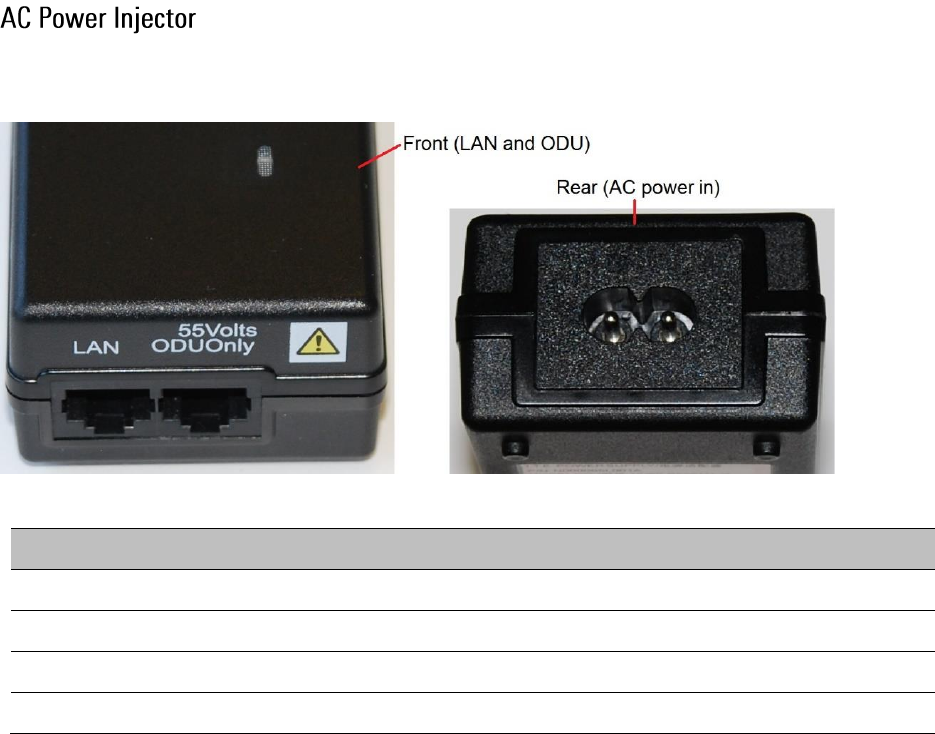
Chapter 2: System hardware
System Components
Page 2-17
The AC Power Injector interfaces are shown in Figure 11 and described in Table 22.
Figure 11 AC Power Injector interfaces
Table 22 AC Power Injector interface functions
Interface
Function
AC power in
AC power input (main supply)
ODU
RJ45 socket for connecting Cat5e cable to ODU
LAN
RJ45 socket for connecting Cat5e cable to network
Power (green) LED
Power supply detection

Chapter 2: System hardware
System Components
Page 2-18
The AC+DC Enhanced Power Injector interfaces are shown in Figure 12 and described in Table 23.
Figure 12 AC+DC Enhanced Power Injector interfaces
Table 23 AC+DC Enhanced Power Injector interface functions
Interface
Function
100-240V 47-63Hz 1.5A
AC power input (main supply)
DC In
Alternative DC power supply input
DC Out
DC power output to a second PSU (for power supply redundancy) or
to a NIDU
ODU
RJ45 socket for connecting Cat5e cable to ODU
LAN
RJ45 socket for connecting Cat5e cable to network
Power (green) LED
Power supply detection
Ethernet (yellow) LED
Ethernet traffic detection

Chapter 2: System hardware
System Components
Page 2-19
The DC Power Injector interfaces are shown in Figure 13 and described in Table 24.
Figure 13 -48 V DC Power Injector interfaces
Table 24 -48V DC Power Injector interfaces
Interface
Function
DC input
36 to 60V, 2A
RJ 45 Sockets
Two (Data In and Data & Power Out)
LEDs
Two (AC and Port)
Power supply – PMP/PTP 450
The PMP/PTP 450 support powering from the following powering sources:
Gigabit Enet Capable Power Supply - 30VDC, 15W
Power Supply,120W 30VDC AT 60C 100-240VAC EL5
Warning
The PMP 450 Ruggedized High Gain Integrated Subscriber Module (Cambium part
numbers C035045C014A and C036045C014A), while encapsulated in a 450i-type
enclosure, contains 450 circuitry which must be powered via 30VDC. Powering these
SMs with a 56 VDC will damage the device.

Chapter 2: System hardware
System Components
Page 2-20
Table 25 PSU part numbers for PMP/PTP 450
Cambium description
Cambium part number
Gigabit Enet Capable Power Supply - 30VDC, 15W
N000900L001A
Cable, UL Power Supply Cord Set, US
N000900L007A
Cable, UL Power Supply Cord Set, EU
N000900L008A
Cable, UL Power Supply Cord Set, UK
N000900L009A
Cable, UL Power Supply Cord Set, Brazil
N000900L010A
The Gigabit Enet Capable power supply interfaces are described in Table 26. This power supply
requires procurement of an AC line cord that connects the outlet of the same (using IEC-60320
Type 5 connector). A list of available power supply cord options from Cambium Networks are
givne in Table 25.
Table 26 –Gigabit Enet Capable power supply
Interface
Function
AC Input
90-264 VAC, 0.5A rms @120VAC/ 0.25A rms @240VAC, 47 to 63 Hz
DC Output
30.0 Vdc +/-5%, 15W, 500 mA max
RJ 45 Sockets
Two (Data In and Data & Power Out)
LEDs
Green, :LED Intensity determined by Level 5 efficiency
Figure 14 Gigabit Enet Capable power supply

Chapter 2: System hardware
System Components
Page 2-21
ODU mounting brackets & accessories
The list of supported brackets is provided in Table 27.
The "Tilt bracket assembly" is the recommended bracket for the AP, SM or BH integrated units.
The "Mounting Bracket (Connectorized)" can be used where a low profile and ease of assembly
of Connectorized AP, SM or BH is required.
The "Mounting Bracket (Integrated)" provide a wider range of adjustment for AP, SM and BH
integrated devices.
Table 27 Accessories part numbers
Cambium description
Cambium part number
Mounting brackets
Tilt Bracket Assembly
N000045L002A
Mounting Bracket (Integrated)
N000065L031A
Mounting Bracket (Connectorized)
N000065L032A
Miscellaneous
Ethernet cable adapter for CMM4 (Dongle)
N000045L001A
RJ-45 Gland Spare – PG16 style (QTY 10)
N000065L033A
Blanking Plug Pack (Qty 10)
N000065L036A
Lightning protection
The PMP/PTP 450i Series supports the lightning protection units listed in Table 28.
The LPU offers the highest level of protection and is the recommended device. Where low cost
deployment is essential, for example for SM in residential application, the Gigabit Surge
Suppressor may be used instead.
Table 28 Lightning protection part numbers
Cambium description
Cambium part number
LPU and Grounding Kit (1 kit per ODU)
C000065L007A
Surge Suppressor (30 VDC)
600SSH
Gigabit Surge Suppressor (56 VDC)
C000000L033A

Chapter 2: System hardware
Cabling and lightning protection
Page 2-22
Cabling and lightning protection
ODU interfaces – PMP 450m AP
These interfaces are described in Table 30.
Figure 15 ODU rear interfaces
Table 29 ODU rear interfaces
Port name
Connector
Interface
Description
PSU (Main)
RJ45
PoE input
Power over Ethernet (PoE).
10/100/1000BASE-T
Ethernet
Data
Aux
RJ45
10/100/100BASE-T Ethernet
Data
PoE output
Standard IEEE802.3at PoE.
Sync input/output
Connection and powering of UGPS
Sync input
SFP
RJ45
10/100/100BASE-T Ethernet
Data
Ground Lugs
10 AWG copper wire
For grounding the unit
LED
Aux
PSU (Main)
Ground Lug
Ground Lug
SFP
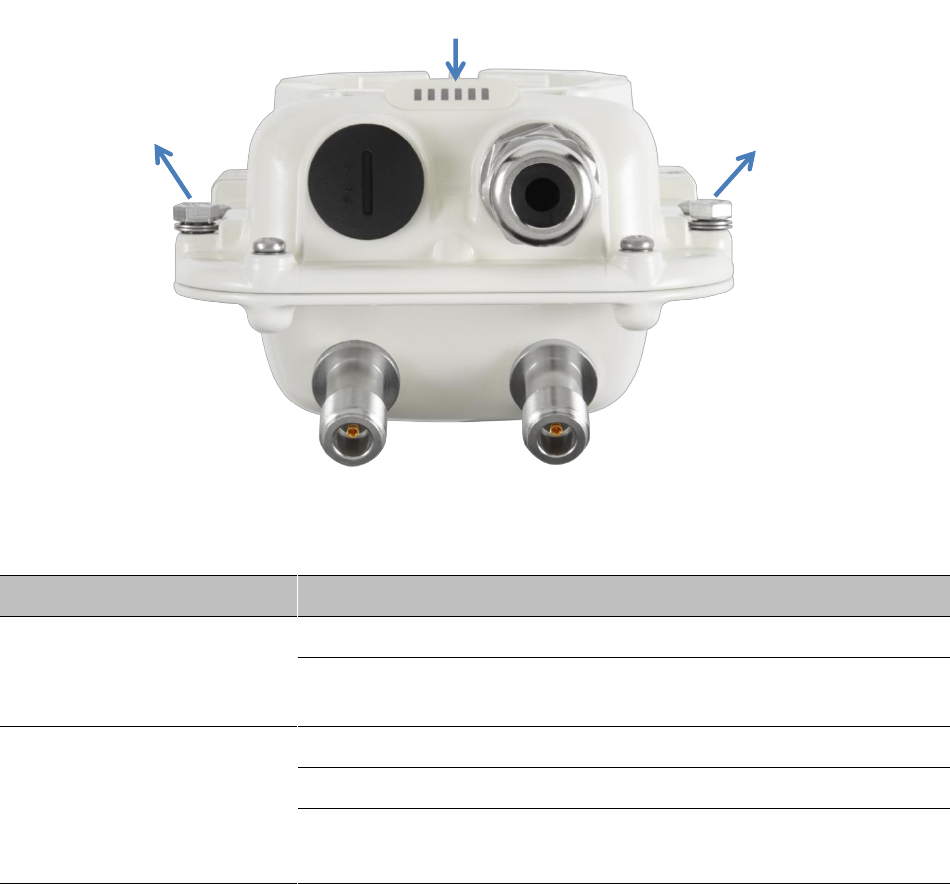
Chapter 2: System hardware
Cabling and lightning protection
Page 2-23
ODU interfaces – PMP/PTP 450i
The Ethernet and Sync/AUX ports are on the rear of the integrated and connectorized ODUs
(Figure 16). These interfaces are described in Table 30.
Figure 16 ODU rear interfaces
Table 30 ODU rear interfaces
Port name
Connector
Interface
Description
Main PSU
RJ45
PoE input
Power over Ethernet (PoE).
10/100/1000BASE-T
Ethernet
Data
Sync/AUX
RJ45
10/100/100BASE-T Ethernet
Data (see Note below)
PoE output
Standard IEEE802.3at PoE.
Sync input/output
Connection and powering of UGPS
Sync input
The front of the connectorized ODU (Figure 17 Connectorized ODU antenna interfaces) provides N
type female connectors for RF cable interfaces to antennas with ports A and B for vertical and
horizontal polarization respectively.
LED
Aux
Main
Ground Lug
Ground Lug
RF port B
RF port A
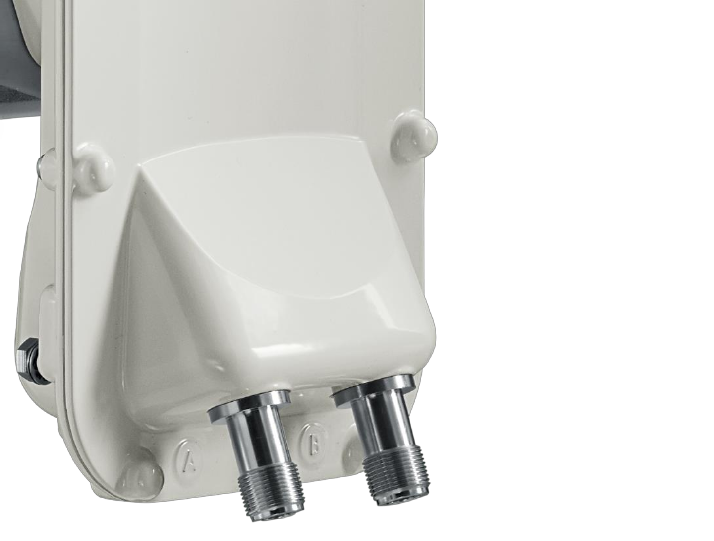
Chapter 2: System hardware
Cabling and lightning protection
Page 2-24
Figure 17 Connectorized ODU antenna interfaces
Ethernet standards and cable lengths
All configurations require a copper Ethernet connection from the ODU (Ethernet port) to the PoE.
Table 31 specifies, for each type of PSU and configuration, the maximum permitted PSU drop
cable length.

Chapter 2: System hardware
Cabling and lightning protection
Page 2-25
Table 31 PSU drop cable length restrictions
System configuration
Maximum cable length (m/ft)
Power supply
PoE powered device
on AUX/SYNC port
(see Note below)
From power supply
to ODU
From ODU to PoE
device on AUX/SYNC
port (see Note below)
Power supply (30W)
None
100 m
N/A
IEEE 802.3at Type 2
100 m in total
AC Power Injector (60W)
None
100 m
N/A
IEEE 802.3at Type 2
100 m in total
AC+DC enhanced Power
Injector (90W)
None
100 m
N/A
IEEE 802.3at Type 2
100 m in total
-48 V DC power injector
None
100 m
N/A
IEEE 802.3at Type 2
100 m in total
CMM4 with 56 V supply
None
100 m
N/A
IEEE 802.3at Type 2
Not supported
IEEE802.3at compliant
supply
None
100 m
N/A
IEEE 802.3at Type 2
Not supported
Note
The Ethernet connectivity for CMM4 requires the part “Ethernet cable adapter for
CMM4 – N000045L001A”.
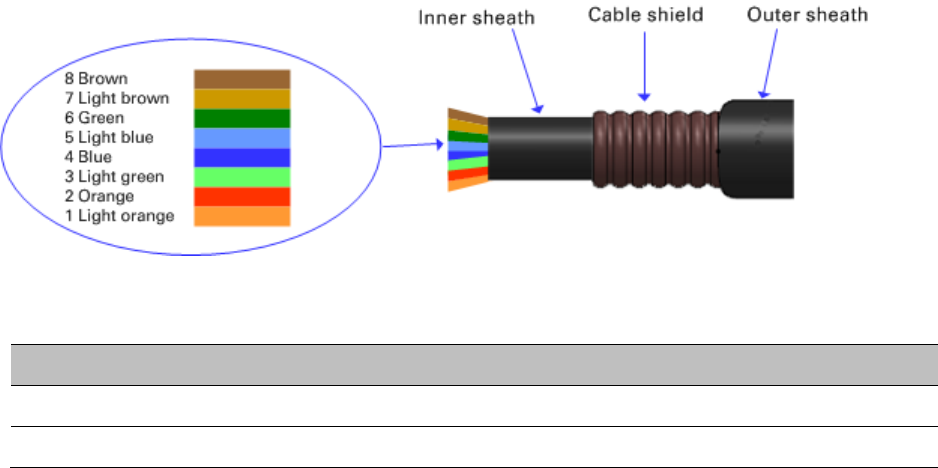
Chapter 2: System hardware
Cabling and lightning protection
Page 2-26
Outdoor copper Cat5e Ethernet cable
Outdoor Cat5e cable is used for all connections that terminate outside the building. For example,
connections between the ODU, surge suppressors (if installed), UGPS receivers (if installed) and
the power supply injector. This is known as a “drop cable” (Figure 18).
The following practices are essential to the reliability and longevity of cabled connections:
Use only shielded cables and connectors to resist interference and corrosion.
For vertical runs, provide cable support and strain relief.
Include a 2 ft (0.6 m) service loop on each end of the cable to allow for thermal expansion and
contraction and to facilitate terminating the cable again when needed.
Include a drip loop to shed water so that most of the water does not reach the connector at the
device.
Properly crimp all connectors.
Use dielectric grease on all connectors to resist corrosion.
Order Superior Essex type BBDGe cable from Cambium Networks (Table 32). Other lengths of this
cable are available from Superior Essex.
Figure 18 Outdoor drop cable
Table 32 Drop cable part numbers
Cambium description
Cambium part number
1000 ft Reel Outdoor Copper Clad CAT5E
WB3175
328 ft (100 m) Reel Outdoor Copper Clad CAT5E
WB3176

Chapter 2: System hardware
Cabling and lightning protection
Page 2-27
Main Ethernet port
The PoE cable pinout diagram for Main port is given below.
Table 33 Main port PoE cable pinout
RJ45 pin
Interface
Ethernet
description
PoE input
description
1
1000 BaseT
Ethernet with
PoE In
+TxRx0
+Ve or -Ve
2
–TxRx0
3
+TxRx1
+Ve or –Ve
6
–TxRx1
5
–TxRx2
+Ve or –Ve
4
+TxRx2
7
+TxRx3
+Ve or –Ve
8
–TxRx3
Note
The PoE input on the Main port accepts any polarity as long as there is at least one pair
at +Ve and at least one at –Ve.
Aux port
Table 34 Aux port PoE cable pinout
RJ45 pin
Interface
Signal description
PoE output
description
1
100 BaseT
Ethernet with
PoE Out (see
note below)
+TxRx0
-Ve
2
–TxRx0
3
+TxRx1
+Ve
6
–TxRx1
5
GPS and
alignment tone
GPS power out, Alignment
tone out, GPS data out
N/A
4
GPS data in
7
GPS 0v
8
GPS Sync in
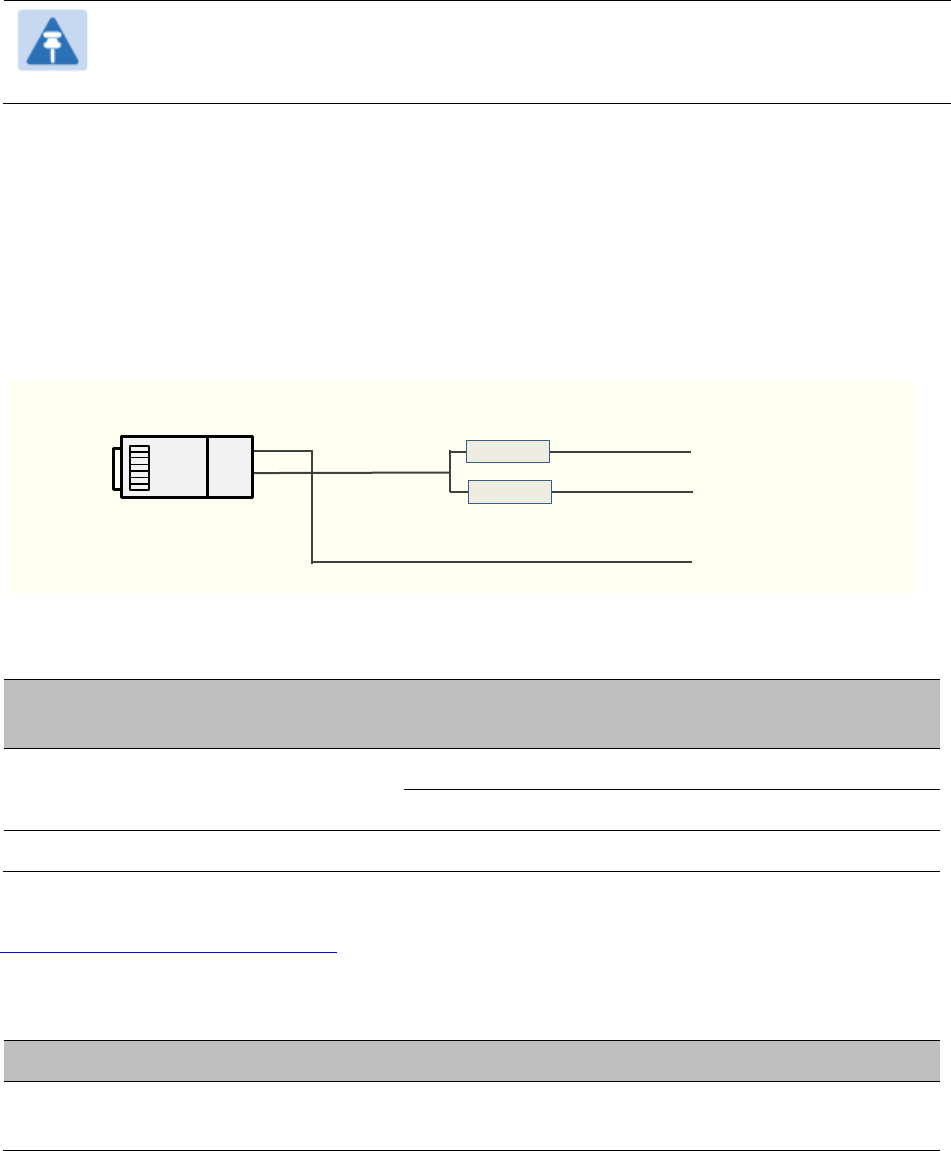
Chapter 2: System hardware
Cabling and lightning protection
Page 2-28
Note
Only alignment and sync functionalities are supported on the Aux port in current
release 14.1.1.
Aux port to alignment tone headset wiring
A standard 32 ohms stereo headset can be connected to the AUX port to use the audio alignment
tool. The diagram of the adapter is provided in Figure 19. The recommended values for both
resistors are 220 ohm, 0.25W. Different resistor value can be used to optimize the level of the audio
signal depending on the headset characteristics and the level of ambient noise
Figure 19 Alignment Tone Cable
Table 35 Aux port PoE cable pinout
RJ45 pin
(AUX port)
Signal description
Serial component
Jack socket
(to jack plug of headset)
5
Alignment tone out
220 ohms resistor
Ring
220 ohm resistor
Tip
7
GPS 0v
None
Sleeve
Alternatively, a readymade headset adapter can be ordered from Best-Tronics
(http://btpa.com/Cambium-Products/) with the following part number:
Table 36 Alignment tone adapter third party product details
Reference
Product description
BT-1277
Headset alignment cable for the Cambium Networks PMP450i and
PTP450i product lines
220 Ω
220 Ω
Resistors
Pin 7
Pin 4
Left / tip
Right / ring
Sleeve /Common
#8
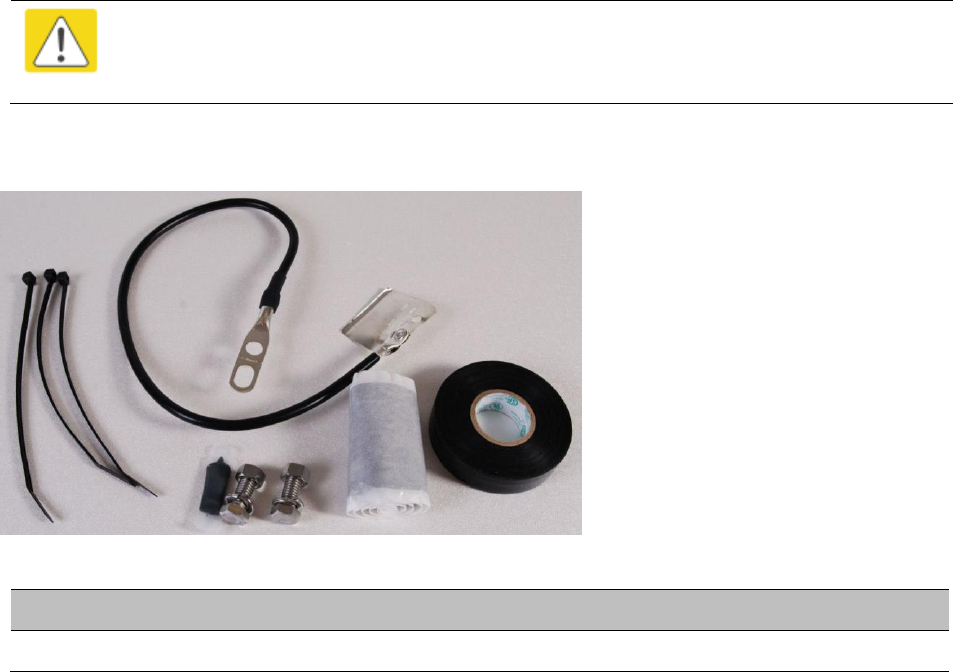
Chapter 2: System hardware
Cabling and lightning protection
Page 2-29
Cable grounding kit
Copper drop cable shields must be bonded to the grounding system in order to prevent lightning-
strike arcing (resulting in fire risk and damage to equipment).
One grounding kit (Figure 20) is required for each grounding point on the PSU. Order cable
grounding kits from Cambium Networks (Table 37).
Caution
To provide adequate protection, all grounding cables must be a minimum size of 10
mm2 csa (8AWG), preferably 16 mm2 csa (6AWG), or 25 mm2 csa (4AWG).
Figure 20 Cable grounding kit
Table 37 Cable grounding kit part numbers
Cambium description
Cambium part number
Cable Grounding Kits For 1/4" And 3/8" Cable
01010419001
Lightning protection unit (LPU) and grounding kit
PMP/PTP 450i LPUs provide transient voltage surge suppression for ODU installations. Each PSU
requires two LPUs, one near the ODU and the other near the linked device, usually at the building
entry point (Table 38).

Chapter 2: System hardware
Cabling and lightning protection
Page 2-30
Table 38 LPU and grounding kit contents
Lightning protection units (LPUs)
LPU grounding point nuts and washers
ODU to top LPU drop cable (600 mm)
EMC strain relief cable glands
U-bolts, nuts and washers for mounting LPUs
ODU to top LPU ground cable (M6-M6)
Bottom LPU ground cable (M6-M10)
ODU to ground cable (M6-M10
One LPU and grounding kit (Table 38) is required for the PSU drop cable connection to the ODU. If
the ODU is to be connected to an auxiliary device, one additional LPU and grounding kit is
required for the Aux drop cable. Order the kits from Cambium Networks (Table 39).
Table 39 LPU and grounding kit part number
Cambium description
Cambium part number
PMP/PTP 450i LPU and Grounding Kit (One Kit Per End)
C000065L007

Chapter 2: System hardware
Antennas and antenna cabling
Page 2-31
Antennas and antenna cabling
Antenna requirements
Each connectorized ODU requires one external antenna (normally dual-polar).
For connectorized units operating in the USA or Canada 900 MHz, 4.9 GHz, 5.1 GHz, 5.2 GHz, 5.4
GHz or 5.8 GHz bands, choose external antennas which are recommended by Cambium Networks.
Do not install any other antennas.
Supported external AP antennas
The recommended AP external antennas are listed in Table 40.
Table 40 List of AP external antennas
Cambium description
Cambium part number
900 MHz 13 dBi 65 degree Sector Antenna (Dual Slant)
N009045D001A
5 GHz Horizontal and Vertical Polarization Antenna for 90 Degree
Sector
85009324001
5 GHz Horizontal and Vertical Polarization Antenna for 60 Degree
Sector
85009325001
Note
LINKPlanner, Cambium Networks planning tool, contains an up-to-date, exhaustive
list of antennas that can be used with Cambium Products.
Supported external BH/SM antenna
The recommended PTP 450i BH or PMP 450/450i SM external antenna is listed in Table 41.
Table 41 PTP 450i BH or PMP 450/450i SM external antenna
Cambium description
Cambium part number
900 MHz 12 dBi gain directional antenna (Dual Slant)
N009045D003A

Chapter 2: System hardware
Antennas and antenna cabling
Page 2-32
RF cable and connectors
RF cable of generic type LMR-400 is required for connecting the ODU to the antenna. N type male
connectors are required for connecting the RF cables to the connectorized ODU. Two connectors
are required per ODU. Use weatherproof connectors, preferably ones that are supplied with
adhesive lined heat shrink sleeves that are fitted over the interface between the cable and
connector. Order CNT-400 RF cable and N type male connectors from Cambium Networks (Table
42).
Table 42 RF cable and connector part numbers
Cambium description
Cambium part number
50 Ohm Braided Coaxial Cable - 75 meter
30010194001
50 Ohm Braided Coaxial Cable - 500 meter
30010195001
RF Connector, N, Male, Straight for CNT-400 Cable
09010091001
Antenna accessories
Connectorized ODUs require the following additional components:
Cable grounding kits: Order one cable grounding kit for each grounding point on the antenna
cables. Refer to Lightning protection unit (LPU) and grounding kit on 2-29
Self-amalgamating and PVC tape: Order these items to weatherproof the RF connectors
Lightning arrestors: When the connectorized ODU is mounted indoors, lightning arrestors (not
LPUs) are required for protecting the antenna RF cables at building entry. One arrestor is
required per antenna cable. One example of a compatible lightning arrestor is the Polyphaser
LSXL-ME or LSXL (not supplied by Cambium Networks).
RJ45 connectors and spare glands
RJ45 connectors are required for plugging Cat5e cables into ODUs, LPUs, PoEs and other devices.
Order RJ45 connectors and crimp tool from Cambium Networks (Table 43).
The ODU is supplied with one environmental sealing gland for the drop cable. The cable clamping
range for gland is 5 mm to 9 mm.
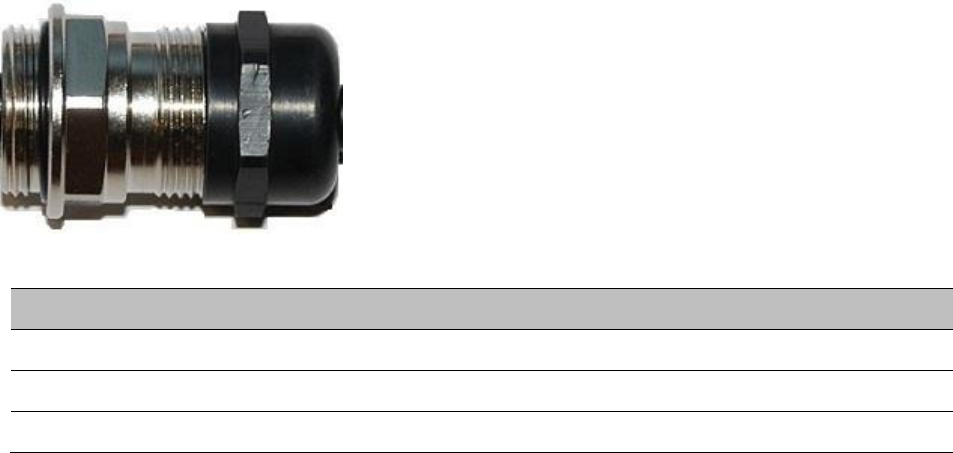
Chapter 2: System hardware
Antennas and antenna cabling
Page 2-33
Figure 21 Cable gland (part number #N000065L033)
Table 43 RJ45 connector and spare gland part numbers
Cambium description
Cambium part number
Tyco/AMP, Mod Plug RJ45, 100 pack
WB3177
Tyco/AMP Crimp Tool
WB3211
RJ-45 Spare Grounding Gland - PG16 size (Qty. 10)
N000065L033

Chapter 2: System hardware
GPS synchronization
Page 2-34
GPS synchronization
GPS synchronization description
Cambium offers GPS synchronization to limit the network’s own self-interference. The Cluster
Management CMM provides Global Positioning System (GPS) synchronization to the Access Point
(AP) and all associated Subscriber Modules (SM). Network operators have a choice of UGPS and
CMM solutions to select the option that works best for the environment.
Universal GPS (uGPS)
The uGPS provides network synchronization for smaller networks where a CMM may not be cost
effective. The uGPS provides synchronization for one or two modules so that even remote areas at
the edge of the network can operate with synchronization for improved performance. The uGPS
works with all Cambium PMP radios. The uGPS has a small footprint and is easy to deploy.
Figure 22 uGPS
Note
PMP 450 and 450i APs can power up a uGPS via the Aux/Timing port.
CMM5
The Cluster Management Module (CMM) 5 supports following features:
12 + 24 port versions.
DC input.
Midspan or rack mount.
SFP ports
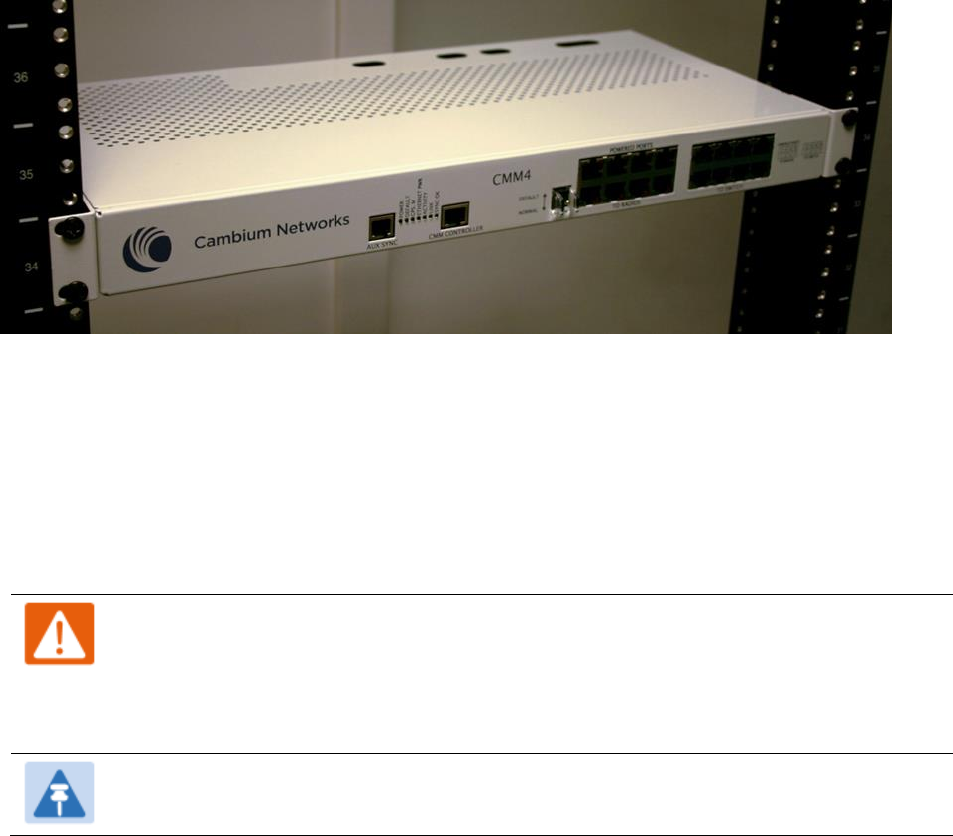
Chapter 2: System hardware
GPS synchronization
Page 2-35
CMM4 (Rack
Mount)
The Cluster Management Module (CMM) is the heart of the Cambium system’s synchronization
capability, which allows network operators to reuse frequencies and add capacity while ensuring
consistency in the quality of service to customers.
For operators who prefer indoor CMM mounting, Cambium offers the Rack-Mounted Cluster
Management Module 4. The unit is designed to be mounted onto a standard 19-inch
telecommunications rack and to allow the Cambium CMM4 to be co-located with other
telecommunications equipment.
Figure 23 CMM4 (Rack Mount)
The CMM4 has two DC power inputs, one 29 V and one 56V. It can be used to power and
synchronize both 29V legacy products such as the PMP 450 and 56V products such as the PMP 450i
simultaneously.
If the 29V legacy products are connected to the CMM4, a 29V power supply needs to be connected.
If PMP/PTP 450/450i are connected to the CMM4, a 56V power supply needs to be connected.. The
CMM4 supports having two of the 56V and two of the 24V supplies for redundancy.
Warning
PMP 450i requires different wiring between the CMM4 and device. If a PMP450 is
replaced by a PMP 450i and the existing drop cable needs to be re-used, the adapter
"CMM4 56V power adapter, #N000045L001A" must be used between the CMM4 and
the existing drop cable.
Note
If only a 56V supply is used, it can not power up 29V radios.
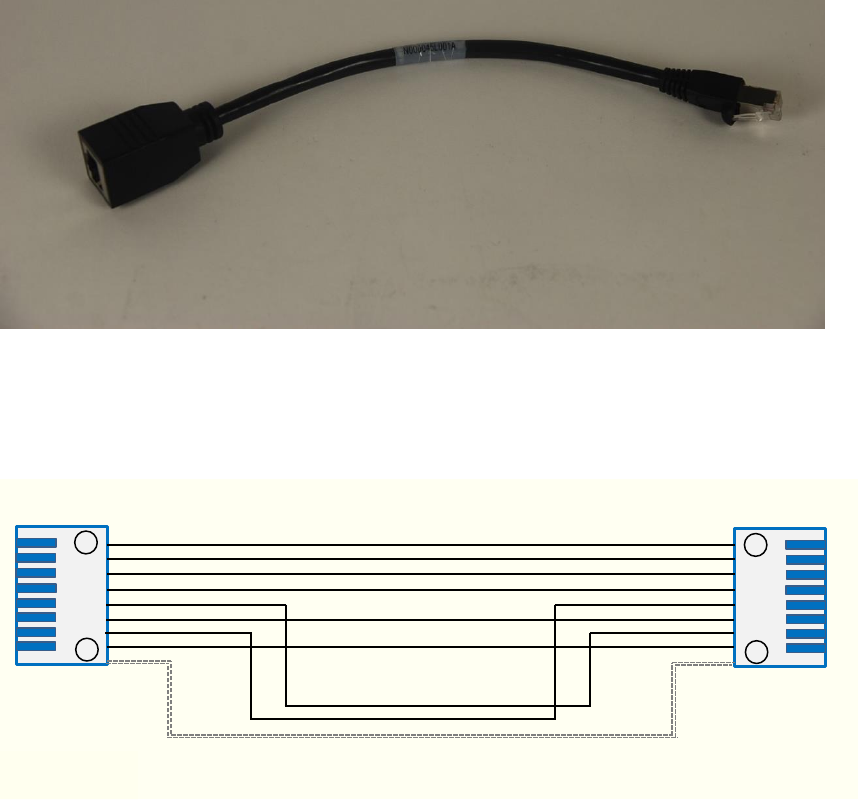
Chapter 2: System hardware
GPS synchronization
Page 2-36
Figure 24 CMM4 56V power adapter (dongle)
CMM4 56V power adapter cable pinout
Figure 25 CMM4 power adapter cabling diagram
1
8
1
8
J1
J2
RJ45 Plug
RJ45 Jack
5
7
5
7
Shield

Chapter 2: System hardware
GPS synchronization
Page 2-37
Table 44 CMM4 power adapter cable pinout
Plug J1 pin
Jack J2 pin
1
1
2
2
3
3
4
4
5
7
6
6
7
5
8
8
Screen
Screen
Note
Pins 5 and 7 are flipped.
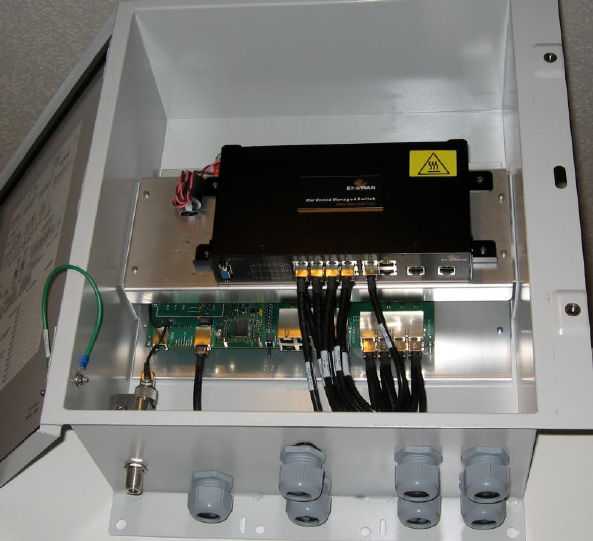
Chapter 2: System hardware
GPS synchronization
Page 2-38
CMM4
(Cabinet
with
switch)
Designed to deliver consistent and reliable wireless broadband service, the PMP/PTP system
gracefully scales to support large deployments. The cluster management module is the heart of
the system’s synchronization capability which allows network operators to re-use frequencies and
add capacity while ensuring consistency in the quality of service to customers. As a result,
subscribers can experience carrier-grade service even at the outer edge of the network.
Figure 26 CMM4 (Cabinet with switch)
CMM4
(Cabinet
without
switch)
This CMM includes all of the functionality listed above but there is no switch. This provides the
network operator the flexibility to use the switch of their choice with the power and
synchronization capabilities of the CMM4.
CMM3/CMMmicro
The CMM3 or CMMmicro (Cluster Management Module micro) provides power, GPS timing, and
networking connections for an AP cluster. The CMM3 is configurable through a web interface.
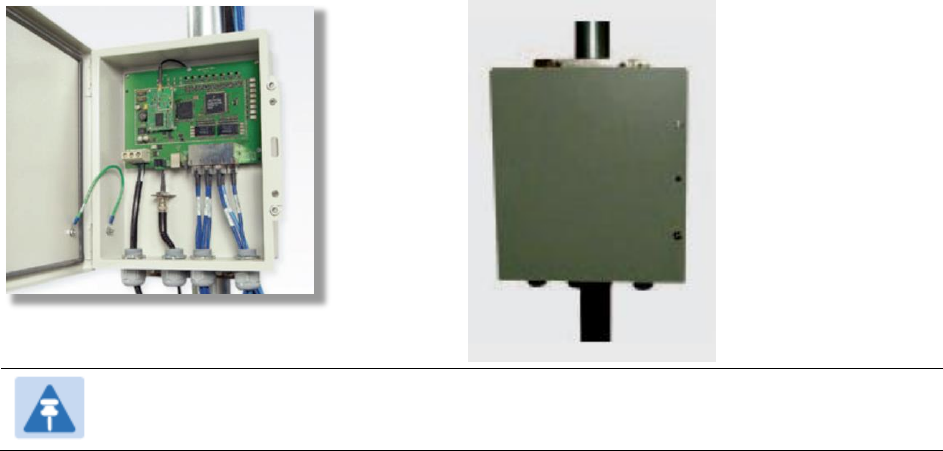
Chapter 2: System hardware
GPS synchronization
Page 2-39
The CMM3 contains an 8-port managed switch that supports Power over Ethernet (PoE – this is
cambium PoE, not the standard PoE) on each port and connects any combination of APs, BHMs,
BHSs, or Ethernet feed. The Cambium fixed wireless broadband IP networks PoE differs from IEEE
Standard 803.3af PoE, and the two should not be intermixed. The CMM3 can auto-negotiate speed
to match inputs that are either 100Base-TX or 10Base-T, and either full duplex or half duplex,
where the connected device is set to auto-negotiate. Alternatively, these parameters are settable.
A CMM3 requires only one cable, terminating in an RJ-45 connector, for each connected module to
distribute
Ethernet signaling.
power to as many as 8 co-located modules—APs, BHMs, or BHSs. Through a browser interface
to the managed switch, ports can be powered or not.
sync to APs and BHMs. The CMM3 receives 1-pulse per second timing information from Global
Positioning System (GPS) satellites through an antenna (included) and passes the timing pulse
embedded in the 24-V power to the connected modules.
GPS status information is available at the CMM3, however
CMM3 provides time and date information to BHMs and APs if both the CMMmicro is
operating on CMMmicro Release 2.1 or later and the AP/BHM is operating on System Release
4.2 or later. See Configuring time settings on Page 7-87.
CMM3 does not provide time and date information to BHMs and APs if either the CMM3 is
operating on a release earlier than CMMmicro Release 2.1 or the AP/BHM is operating on a
release earlier than System Release 4.2.
A CMM3/CMMicro is shown in Figure 27 and Figure 28.
Figure 27 CMM3
Figure 28 Pole mounted CMM3
Note
A CMM3 can not be used to power up a 450i radio.

Chapter 2: System hardware
Installing a GPS receiver
Page 2-40
Installing a GPS receiver
To install a GPS receiver as the timing reference source, use the following procedures:
Mounting the GPS receiver on page 2-41
Cabling the GPS Antenna on page 2-42
Installing and connecting the GPS LPU on page 2-42
Caution
Prior to power-up of equipment, ensure that all cables are connected to the correct
interfaces of the CMM4 unit and the UGPS receiver module. Failure to do so may
result in damage to the equipment.
GPS receiver location
Mount the GPS receiver at a location that meets the following requirements:
It must be possible to protect the installation as described in Grounding and lightning
protection on page 3-8.
It must have an un-interrupted view of at least half of the southern (resp. northern) sky in the
northern (resp. southern) hemisphere. For a receiver mounted on a wall there must be no
other significant obstructions in the view of the sky.
It must be mounted at least 1 m (3 ft), preferably 2 m (6 ft), away from other GPS receiving
equipment.
It must not be sited in the field of radiation of co-located radio communications equipment and
should be positioned at a distance of at least 3 m (10 ft) away.
Mount the UGPS receiver on the wall of the equipment building if there is a suitable location on
the wall that can meet these requirements.
Mounting the GPS receiver module on the equipment building
If mounting the GPS receiver on the equipment building (Figure 33), select a position on the wall
that meets the following requirements:
It must be below the roof height of the equipment building or below the height of any roof-
mounted equipment (such as air conditioning plant).
It must be below the lightning air terminals.
It must not project more than 600mm (24 inches) from the wall of the building.
If these requirements cannot all be met, then the module must be mounted on a metal tower or
mast.
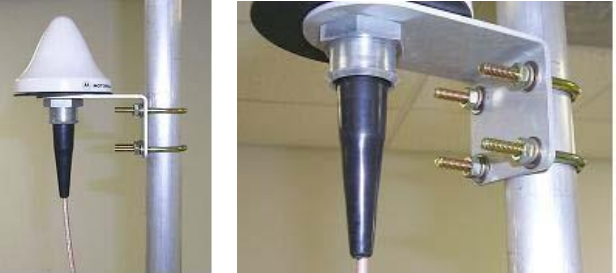
Chapter 2: System hardware
Installing a GPS receiver
Page 2-41
Mounting the GPS receiver module on a metal tower or mast
If mounting the GPS receiver module on a metal tower or mast (Figure 34), select a position that
meets the following requirements:
It must not be mounted any higher than is necessary to receive an adequate signal from four
GPS satellites.
It must be protected by a nearby lightning air terminal that projects farther out from the tower
than the GPS receiver module.
Mounting the GPS receiver
Mount the UGPS receiver (following manufacturer’s instructions) upon either an external wall
(Figure 33) or a metal tower or mast (Figure 34).
Figure 29 GPS antenna mounting

Chapter 2: System hardware
Installing a GPS receiver
Page 2-42
Procedure 1 Mounting the GPS receiver
1
Ensure that the mounting position
has an unobstructed view of the sky to 20º above the horizon.
is not the highest object at the site. (The GPS antenna does not need to be
particularly high on a site, which would give it more exposure to lightning. It just
needs to have an unobstructed view of the sky.)
is not further than 100 feet (30.4 meters) of cable from the CMM.
2
Select a pole that has an outside diameter of 1.25 to 1.5 inches (3 to 4 cm) to which
the GPS antenna bracket can be mounted.
3
Place the U-bolts (provided) around the pole as shown in Figure 28..
4
Slide the GPS antenna bracket onto the U-bolts.
5
Slide the ring washers (provided) onto the U-bolts.
6
Slide the lock washers (provided) onto the U-bolts.
7
Use the nuts (provided) to securely fasten the bracket to the U-bolts.
Please refer to the PMP Synchronization Solutions User Guide located on the Cambium website
(http://www.cambiumnetworks.com/resources/pmp-synchronization-solutions ).
Cabling the GPS Antenna
Connect the GPS coax cable to the female N-connector on the GPS antenna. Please refer to the
PMP Synchronization Solutions User Guide located on the Cambium website
(http://www.cambiumnetworks.com/resources/pmp-synchronization-solutions ).
Installing and connecting the GPS LPU
Install and ground the GPS drop cable LPU at the building (or cabinet) entry point, as described in
Install the bottom LPU on page 6-19.

Chapter 2: System hardware
Ordering the components
Page 2-43
Ordering the components
This section describes how to select components for PMP 450m, PMP/PTP 450i and PMP/PTP 450
Greenfield network or 450m/450i network migration. It specifies Cambium part numbers for
PMP/PTP 450 platform components.
Order PMP 450m, PMP/PTP 450i and PMP/PTP 450 Series products from Cambium Networks.
PMP 450m
Table 45 PMP 450m ODU part numbers
Cambium description
Cambium part number
PMP 450m AP (Access Point)
5 GHz PMP 450m Integrated Access Point, 90 Degree (ROW)
C050045A101A
5 GHz PMP 450m Integrated Access Point, 90 Degree (FCC)
C050045A102A
5 GHz PMP 450m Integrated Access Point, 90 Degree (EU)
C050045A103A
5 GHz PMP 450m Integrated Access Point, 90 Degree (DES Only)
C050045A104A
5 GHz PMP 450m Integrated Access Point, 90 Degree (IC)
C050045A105A
PMP 450i
Table 46 PMP 450i ODU part numbers
Cambium description
Cambium part number
PMP 450i AP (Access Point)
900 MHz PMP 450i Connectorized Access Point
C009045A001A
5 GHz PMP 450i Connectorized Access Point (RoW)
C050045A001A
5 GHz PMP 450i Connectorized Access Point (FCC)
C050045A002A
5 GHz PMP 450i Connectorized Access Point (EU)
C050045A003A
5 GHz PMP 450i Connectorized Access Point (DES Only)
C050045A004A
5 GHz PMP 450i Connectorized Access Point (IC)
C050045A015A
5 GHz PMP 450i AP, Integrated 90°sector antenna (RoW)
C050045A005A
5 GHz PMP 450i AP, Integrated 90°sector antenna (FCC)
C050045A006A
5 GHz PMP 450i Integrated Access Point, 90 degree (EU)
C050045A007A

Chapter 2: System hardware
Ordering the components
Page 2-44
Cambium description
Cambium part number
5 GHz PMP 450i AP, Integrated 90°sector antenna (DES only)
C050045A008A
5 GHz PMP 450i AP, Integrated 90°sector antenna (IC)
C050045A016A
PMP 450i SM (Subscriber Module)
5 GHz PMP 450i Connectorized Subscriber Module
C050045C001A
5 GHz PMP 450i SM, Integrated High Gain Antenna
C050045C002A
Note
The 450i SM does not have license keys.
PTP 450i
Table 47 PTP 450i ODU part numbers
Cambium description
Cambium part number
5 GHz PTP 450i END, Connectorized (RoW)
C050045B001A
5 GHz PTP 450i END, Integrated High Gain Antenna (RoW)
C050045B002A
5 GHz PTP 450i END, Connectorized (FCC)
C050045B003A
5 GHz PTP 450i END, Connectorized (EU)
C050045B005A
5 GHz PTP 450i END, Connectorized (DES only)
C050045B007A
5 GHz PTP 450i END, Connectorized (IC)
C050045B015A
5 GHz PTP 450i END, Integrated High Gain Antenna (FCC)
C050045B004A
5 GHz PTP 450i END, Integrated High Gain Antenna (EU)
C050045B006A
5 GHz PTP 450i END, Integrated High Gain Antenna (DES only)
C050045B008A
5 GHz PTP 450i END, Integrated High Gain Antenna (IC)
C050045B016A
Ethernet cable adapter for CMM4
N000045L001A
PMP 450
Table 48 PMP 450 ODU part numbers
Cambium description
Cambium part number
PMP 450 AP (Access Point)
2.4 GHz PMP 450 Connectorized Access Point
C024045A001A

Chapter 2: System hardware
Ordering the components
Page 2-45
Cambium description
Cambium part number
2.4 GHz PMP 450 Connectorized Access Point (DES)
C024045A003A
3.5 GHz PMP 450 Connectorized Access Point
C035045A001A
3.5 GHz PMP 450 Connectorized Access Point (DES)
C035045A003A
3.6 GHz PMP 450 Connectorized Access Point
C036045A001A
3.6 GHz PMP 450 Connectorized Access Point (DES)
C036045A003A
5 GHz PMP 450 Connectorized Access Point
C054045A001A
5 GHz PMP 450 Connectorized Access Point (US only)
C054045A002A
5 GHz PMP 450 Connectorized Access Point (DES)
C054045A003A
PMP 450 AP Lite
2.4 GHz PMP 450 Connectorized Access Point - Lite
C024045A011A
3.3-3.6 GHz PMP 450 Connectorized Access Point - Lite
C035045A011A
3.55-3.8 GHz PMP 450 Connectorized Access Point - Lite
C036045A011A
5 GHz PMP 450 Connectorized Access Point - Lite
C054045A011A
5 GHz PMP 450 Connectorized Access Point (FCC) - Lite
C054045A012A
PMP 450 SM (Subscriber Module)
900 MHz PMP 450 Connectorized Subscriber Module
C009045C001A
2.4 GHz PMP 450 Subscriber Module, 4 Mbps
C024045C001A
2.4 GHz PMP 450 Subscriber Module, 10 Mbps
C024045C002A
2.4 GHz PMP 450 Subscriber Module, 20 Mbps
C024045C003A
2.4 GHz PMP 450 Subscriber Module, Uncapped
C024045C004A
2.4 GHz PMP 450 Connectorized Subscriber Module, 4 Mbps
C024045C005A
2.4 GHz PMP 450 Connectorized Subscriber Module, 10 Mbps
C024045C006A
2.4 GHz PMP 450 Connectorized Subscriber Module, 20 Mbps
C024045C007A
2.4 GHz PMP 450 Connectorized Subscriber Module, Uncapped
C024045C008A
3.5 GHz PMP 450 High Gain Directional Integrated Subscriber
C035045C014A
3.5 GHz PMP 450 Subscriber Module, 4 Mbps
C035045C001A
3.5 GHz PMP 450 Subscriber Module, 10 Mbps
C035045C002A
3.5 GHz PMP 450 Subscriber Module, 20 Mbps
C035045C003A
3.5 GHz PMP 450 Subscriber Module, Uncapped
C035045C004A
3.5 GHz PMP 450 Connectorized Subscriber Module, 4 Mbps
C035045C005A

Chapter 2: System hardware
Ordering the components
Page 2-46
Cambium description
Cambium part number
3.5 GHz PMP 450 Connectorized Subscriber Module, 10 Mbps
C035045C006A
3.5 GHz PMP 450 Connectorized Subscriber Module, 20 Mbps
C035045C007A
3.5 GHz PMP 450 Connectorized Subscriber Module, Uncapped
C035045C008A
3.6 GHz PMP 450 High Gain Directional Integrated Subscriber
C036045C014A
3.6 GHz PMP 450 Subscriber Module, 4 Mbps
C036045C001A
3.6 GHz PMP 450 Subscriber Module, 10 Mbps
C036045C002A
3.6 GHz PMP 450 Subscriber Module, 20 Mbps
C036045C003A
3.6 GHz PMP 450 Subscriber Module, Uncapped
C036045C004A
3.6 GHz PMP 450 Connectorized Subscriber Module, 4 Mbps
C036045C005A
3.6 GHz PMP 450 Connectorized Subscriber Module, 10 Mbps
C036045C006A
3.6 GHz PMP 450 Connectorized Subscriber Module, 20 Mbps
C036045C007A
3.6 GHz PMP 450 Connectorized Subscriber Module, Uncapped
C036045C008A
5 GHz PMP 450 Connectorized Subscriber Module, 4 Mbps
C054045C005A
5 GHz PMP 450 Connectorized Subscriber Module, 10 Mbps
C054045C006A
5 GHz PMP 450 Connectorized Subscriber Module, 20 Mbps
C054045C007A
5 GHz PMP 450 Connectorized Subscriber Module, Uncapped
C054045C008A
5 GHz PMP 450 Integrated Subscriber Module, 4 Mbps
C054045C001B
5 GHz PMP 450 Integrated Subscriber Module, 10 Mbps
C054045C002B
5 GHz PMP 450 Integrated Subscriber Module, 20 Mbps
C054045C003B
5 GHz PMP 450 Integrated Subscriber Module, Uncapped
C054045C004B
5 GHz PMP 450 Connectorized Subscriber Module, 4 Mbps
C054045C005B
5 GHz PMP 450 Connectorized Subscriber Module, 10 Mbps
C054045C006B
5 GHz PMP 450 Connectorized Subscriber Module, 20 Mbps
C054045C007B
5 GHz PMP 450 Connectorized Subscriber Module, Uncapped
C054045C008B
5 GHz PMP 450d Subscriber Module, 20 Mbps – 4-pack
C054045H013B
5 GHz PMP 450d Subscriber Module, Uncapped – 4-pack
C054045H014B

Chapter 2: System hardware
Ordering the components
Page 2-47
PTP 450
Table 49 PTP 450 ODU part numbers
Cambium description
Cambium part number
PTP 450 3.5 GHz END – Integrated
C035045B001A
PTP 450 3.5 GHz END – Connectorized
C035045B002A
PTP 450 3.5 GHz END – Integrated – DES Only
C035045B003A
PTP 450 3.5 GHz END – Connectorized – DES Only
C035045B004A
PTP 450 3.65 GHz END – Integrated
C036045B001A
PTP 450 3.65 GHz END – Connectorized
C036045B002A
PTP 450 3.65 GHz END – Integrated – DES Only
C036045B003A
PTP 450 3.65 GHz END – Connectorized – DES Only
C036045B004A
PTP 450 5 GHz END – Integrated (ROW)
C054045B001A
PTP 450 5 GHz END – Connectorized (ROW)
C054045B002A
PTP 450 5 GHz END – Integrated (ROW) – DES Only
C054045B003A
PTP 450 5 GHz END – Connectorized (ROW) – DES Only
C054045B004A
PTP 450 5 GHz END – Integrated (FCC)
C054045B005A
PTP 450 5 GHz END – Connectorized (FCC)
C054045B006A
PMP/PTP 450/450i Accessories
Table 50 PMP/PTP 450/450i Accessories
Cambium description
Cambium part number
PMP 450 AP Antenna Options
900 MHz 65 degree Sector Antenna (Dual Slant)
N009045D001A
900 MHz 12 dBi gain directional antenna (Dual Slant)
N009045D003A
2.4 GHz Dual Slant Antenna for 60 Degree Sector
C024045D601A
3.5 GHz and 3.6 GHz Dual Slant Antenna for 90 Degree Sector
C030045D901A
5 GHz Antenna for 60 Degree Sector
85009325001
5 GHz Antenna for 90 Degree Sector
85009324001
N-type to N-type cable (16 inch length)
30009406002
Power supplies

Chapter 2: System hardware
Ordering the components
Page 2-48
Cambium description
Cambium part number
Power supply, 60 W, 56 V with Gbps support
N000065L001B
AC+DC Enhanced Power Injector
C000065L002B
Line Cord, Fig 8 – US
N000065L003A
Line Cord, Fig 8 – UK
N000065L004A
Line Cord, Fig 8 – EU
N000065L005A
Power over Ethernet midspan, 60 W, -48 VDC Input
N000000L036A
Power Supply, 30 W, 56 V – Gbps support
N000000L034A
Gigabit Enet Capable Power Supply - 30VDC, 15W
N000900L001A
Cable, UL Power Supply Cord Set, US
N000900L007A
Cable, UL Power Supply Cord Set, EU
N000900L008A
Cable, UL Power Supply Cord Set, UK
N000900L009A
AP Optional Equipment
CMM MICRO (Outdoor Enclosure) (450 only)
1070CKHH
CMM4 W/RUGGEDIZED Switch and GPS
1090CKHH
CMM4 NO Switch
1091HH
CMM4 Rack Mount Assembly
1092HH
Ethernet cable adapter for CMM4
N000045L001A
Universal GPS Module
1096H
RJ-45 Gland Spare – PG16 style (QTY 10)
N000065L033A
Blanking Plug Pack (Qty 10)
N000065L036A
SM Optional Equipment
Power Supply, 30 W, 56 V – Gbps support
N000000L034A
Gigabit Enet Capable Power Supply – 30 VDC, 15 W
N000900L001A
Cable, UL Power Supply Cord Set, US
N000900L007A
Cable, UL Power Supply Cord Set, EU
N000900L008A
Cable, UL Power Supply Cord Set, UK
N000900L009A
53CM Offset, Reflector Dish Kit, 4PK
HK2022A
Accessories
Surge Suppressor (30 VDC)
600SSH
Gigabit Surge Suppressor (56 VDC)
C000000L033A

Chapter 2: System hardware
Ordering the components
Page 2-49
Cambium description
Cambium part number
LPU and Grounding Kit (1 kit per ODU)
C000065L007A
50 Ohm Braided Coaxial Cable - 75 meter
30010194001
50 Ohm Braided Coaxial Cable - 500 meter
30010195001
RF Connector, N, Male, Straight for CNT-400 Cable
09010091001
Mounting brackets
Tilt Bracket Assembly
N000045L002A
Mounting Bracket (Integrated)
N000065L031A
Mounting Bracket (Connectorized)
N000065L032A
Upgrade Keys
PMP 450 4 To 10 Mbps Upgrade Key
C000045K002A
PMP 450 4 To 20 Mbps Upgrade Key
C000045K003A
PMP 450 4 To Uncapped Upgrade Key
C000045K004A
PMP 450 10 To 20 Mbps Upgrade Key
C000045K005A
PMP 450 10 To Uncapped MBPS Upgrade Key
C000045K006A
PMP 450 20 To Uncapped MBPS Upgrade Key
C000045K007A
PMP 450 Lite AP to Full AP Upgrade Key
C000045K008A
Extended Warranty
PMP 450 platform AP Extended Warranty, 1 Additional Year
SG00TS4009A
PMP 450 platform AP Extended Warranty, 2 Additional Years
SG00TS4017A
PMP 450 platform AP Extended Warranty, 4 Additional Years
SG00TS4025A
PMP 450 platform SM Extended Warranty, 1 Additional Year
SG00TS4010A
PMP 450 platform SM Extended Warranty, 2 Additional Years
SG00TS4018A
PMP 450 platform SM Extended Warranty, 4 Additional Years
SG00TS4026A

Page 3-1
Chapter 3: System planning
This chapter provides information to help the user to plan a PMP/PTP 450 platform link.
The following topics are described in this chapter:
Typical deployment on page 3-2 contains diagrams illustrating typical PMP/PTP 450 platform
site deployments.
Site planning on page 3-7 describes factors to be considered when planning the proposed link
end sites, including grounding, lightning protection and equipment location.
Radio Frequency planning on page 3-16 describes how to plan PMP/PTP 450 platform links to
conform to the regulatory restrictions that apply in the country of operation.
Link planning on page 3-21 describes factors to be taken into account when planning links,
such as range, path loss and throughput.
Planning for connectorized units on page 3-24 describes factors to be taken into account when
planning to use connectorized ODUs with external antennas in PMP/PTP 450 platform links.
Data network planning on page 3-26 describes factors to be considered when planning
PMP/PTP 450 platform data networks.
Network management planning on page 3-34 describes how to plan for PMP/PTP 450 platform
links to be managed remotely using SNMP.
Security planning on page 3-35 describes how to plan for PMP/PTP 450 platform links to
operate in secure mode.
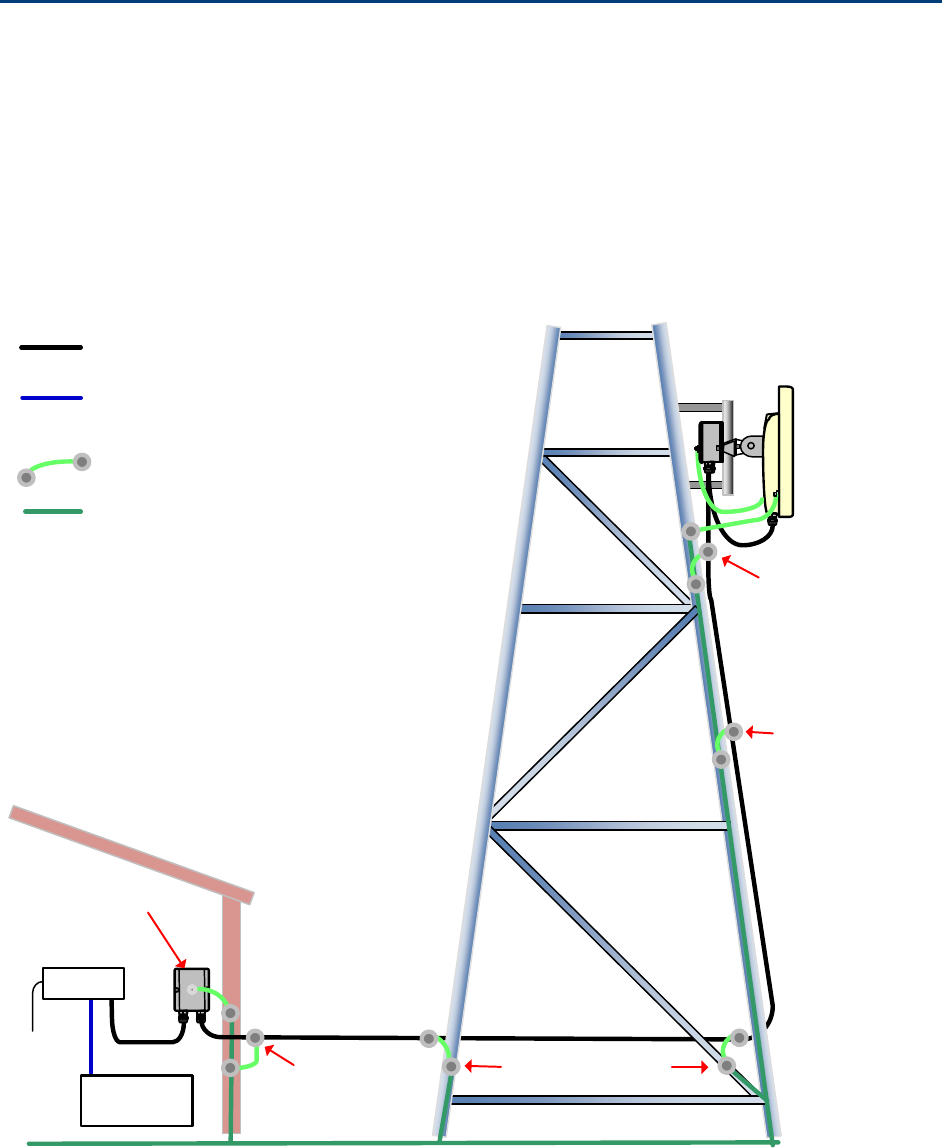
Chapter 3: System planning
Typical deployment
Page 3-2
Typical deployment
This section contains diagrams illustrating typical PMP/PTP 450 platform site deployments.
ODU with PoE interface to PSU
In the basic configuration, there is only one Ethernet interface, a copper Cat5e power over Ethernet
(POE) from the PSU to the ODU (PSU port), as shown in the following diagrams: mast or tower
installation (Figure 30 ), wall installation (Figure 31) and roof installation (Figure 32).
Figure 30 Mast or tower installation
ODU
AC
supply
PSU
Network
equipment
ODU ground cables
Power over Ethernet CAT5e cable (gel-filled,
shielded with copper-plated steel)
Network CAT5e cable
Site grounding system
Bottom LPU
First point of contact
between drop cable
and tower
Tower ground bar
Ground ring
Intermediate
ground cable(s)
as required
Building
entry
Equipment building
or cabinet
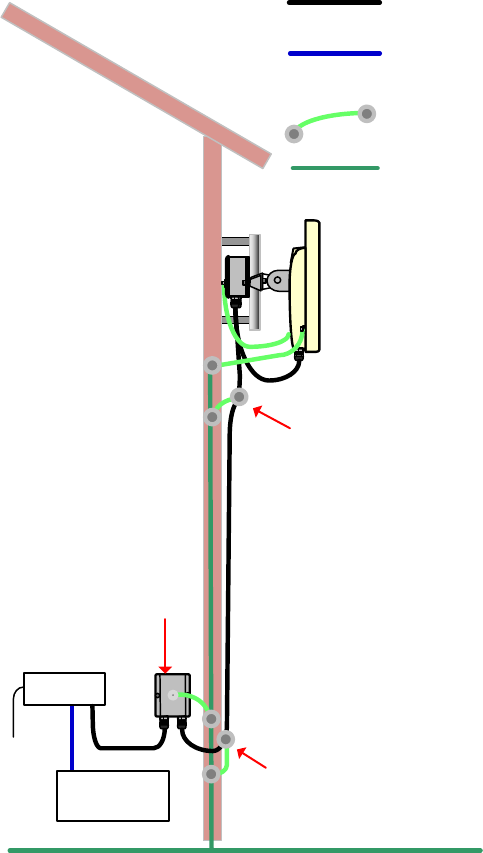
Chapter 3: System planning
Typical deployment
Page 3-3
Figure 31 Wall installation
ODU
PSU
Network
equipment
ODU ground cables
Site grounding system
Bottom LPU
Ground ring
First point of contact
between drop cable
and wall
Building entry
Power over Ethernet CAT5e cable (gel-
filled, shielded with copper-plated steel)
Network Cat5e cable
AC supply
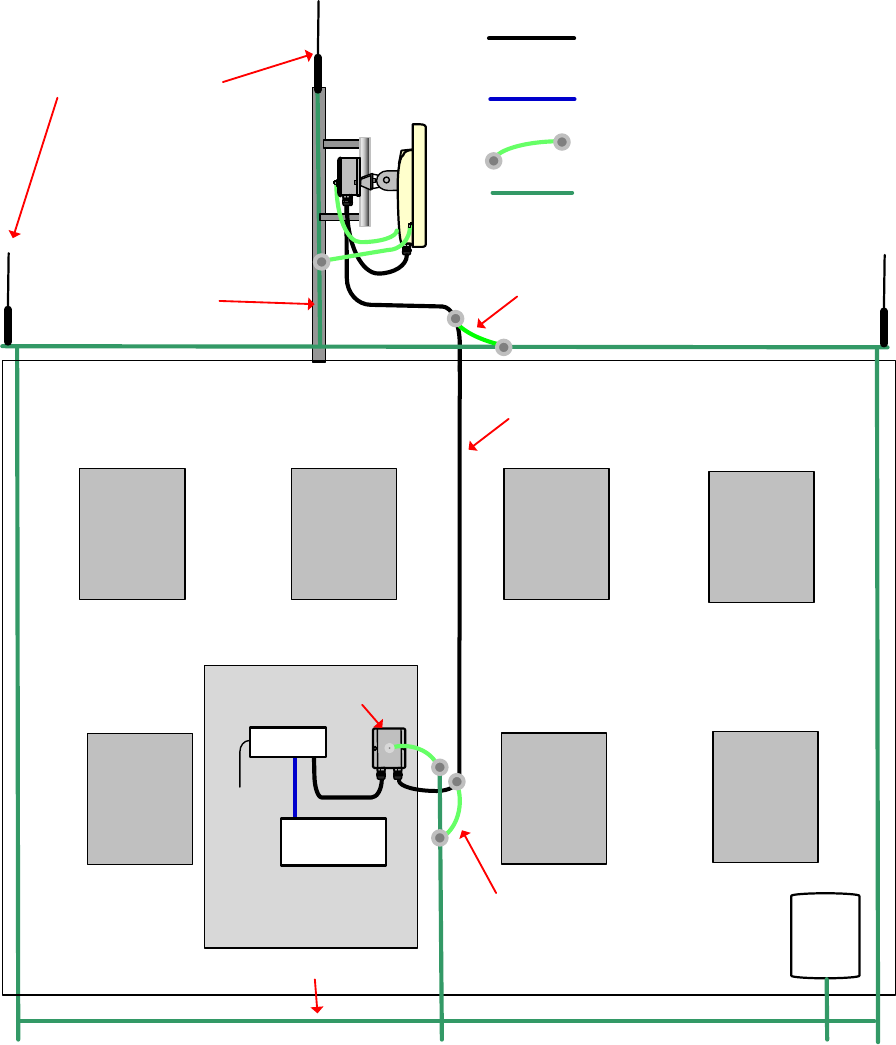
Chapter 3: System planning
Typical deployment
Page 3-4
Figure 32 Roof installation
Air terminals (finials)
Tower grounding
conductor
Building ground ring
AC
service
Equipment room
ODU
ODU ground cables
Network CAT5e cable
Site grounding system
AC
supply
PSU
Network
equipment
Bottom LPU
Building entry point
Drop cable inside building
Equipment room entry point
Power over Ethernet CAT5e cable
(gel-filled, shielded with copper-
plated steel)

Chapter 3: System planning
Typical deployment
Page 3-5
Figure 33 GPS receiver wall installation
PSU
Network
equipment
ODU/ GPSGround
cables
Site grounding system
Drop cable to top
LPU and ODU
Ground ring
Power over Ethernet
CAT5e cable (gel-filled,
shielded with copper-
plated steel)
Network Cat5e cable
AC supply
CMM 4
GPS receiver
AC+DC Power
Injector
First point of contact
between drop cable
and wall
Note
The CMM3 or CMM4 can be used for PMP/PTP 450 platform.

Chapter 3: System planning
Typical deployment
Page 3-6
Figure 34 GPS receiver tower or mast installation
ODU/GPS ground cables
Power over Ethernet CAT5e cable
(gel-filled, shielded with copper-
plated steel)
Network CAT5e cable
Site grounding system
Tower ground bar
Ground ring
Equipment building
or cabinet
PSU
Network
equipment
AC
supply
CMM 4
Power Injector Drop cable
to top LPU
and ODU
GPS receiver
First point of
contact between
drop cable and
tower
Intermediate
ground cable(s)
as required
Note
The CMM3 or CMM4 can be used for PMP/PTP 450 platform.

Chapter 3: System planning
Site planning
Page 3-7
Site planning
This section describes factors to be considered when choosing sites for PMP or PTP radios, power
supplies, CMM4 (if applicable) and UGPS (if applicable).
Site selection for PMP/PTP radios
When selecting a site for the ODU, consider the following factors:
Height and location to ensure that people are kept away from the antenna; see Calculated
distances and power compliance margins on page 4-24.
Height and location to achieve the best radio path.
Indoor location where power supply LED indicators accessible and cable length should not
exceed maximum recommended length; see Power supply site selection
Ability to meet the requirements specified in Grounding and lightning protection on page 3-8.
Aesthetics and planning permission issues.
Cable lengths; see ODU interfaces on page 2-23.
The effect of strong winds on the installation; see ODU wind loading on page 3-11.
Calculated distances and power compliance margin
The calculated minimum separation distances, recommended distances and resulting margins for
each frequency band and antenna combination. These are conservative distances that include
compliance margins. At these and greater separation distances, the power density from the RF
field is below generally accepted limits for the general population.
PMP/PTP 450 platform equipment adheres to all applicable EIRP limits for transmit power when
operating in MIMO mode. Separation distances and compliance margins include compensation for
both transmitters.

Chapter 3: System planning
Site planning
Page 3-8
Power supply site selection
When selecting a site for the ODU power supply, consider the following factors:
Indoor location with no possibility of condensation, flooding or high humidity.
Availability of a mains electricity supply.
Located in an environment where it is not likely to exceed its operational temperature rating,
allowing for natural convection cooling.
Accessibility for viewing status indicator LED and connecting Ethernet cables.
Cable lengths; see ODU interfaces on page 2-23.
Maximum cable lengths
When installing PMP/PTP 450i Series ODU, the maximum permitted length of the shielded copper
Ethernet interface cable is 330 feet (100m) from AP/BHM/SM/BHS to their associated power
supplies or CMM4.
Grounding and lightning protection
Warning
Electro-magnetic discharge (lightning) damage is not covered under warranty. The
recommendations in this guide, when followed correctly, give the user the best
protection from the harmful effects of EMD. However 100% protection is neither
implied nor possible.
Structures, equipment and people must be protected against power surges (typically caused by
lightning) by conducting the surge current to ground via a separate preferential solid path. The
actual degree of protection required depends on local conditions and applicable local regulations.
To adequately protect a PMP/PTP 450 platform installation, both ground bonding and transient
voltage surge suppression are required.
Full details of lightning protection methods and requirements can be found in the international
standards IEC 61024-1 and IEC 61312-1, the U.S. National Electric Code ANSI/NFPA No. 70-1984 or
section 54 of the Canadian Electric Code.
Warning
International and national standards take precedence over the requirements in this
guide.

Chapter 3: System planning
Site planning
Page 3-9
Lightning protection zones
Use the rolling sphere method (Figure 35) to determine where it is safe to mount equipment. An
imaginary sphere, typically 50 meters in radius, is rolled over the structure. Where the sphere rests
against the ground and a strike termination device (such as a finial or ground bar), all the space
under the sphere is considered to be in the zone of protection (Zone B). Similarly, where the
sphere rests on two finials, the space under the sphere is considered to be in the zone of
protection.
Figure 35 Rolling sphere method to determine the lightning protection zones
Zone A: In this zone a direct lightning strike is possible. Do not mount equipment in this zone.
Zone B: In this zone, direct EMD (lightning) effects are still possible, but mounting in this zone
significantly reduces the possibility of a direct strike. Mount equipment in this zone.
Warning
Never mount equipment in Zone A. Mounting in Zone A may put equipment,
structures and life at risk.
Chapter 3: System planning
Site planning
Page 3-10
Site grounding system
Confirm that the site has a correctly installed grounding system on a common ground ring with
access points for grounding PMP/PTP 450 platform equipment.
If the outdoor equipment is to be installed on the roof of a high building (Figure 32), confirm that
the following additional requirements are met:
A grounding conductor is installed around the roof perimeter to form the main roof perimeter
lightning protection ring.
Air terminals are installed along the length of the main roof perimeter lightning protection
ring, typically every 6.1m (20ft).
The main roof perimeter lightning protection ring contains at least two down conductors
connected to the grounding electrode system. The down conductors should be physically
separated from one another, as far as practical.
ODU and external antenna location
Find a location for the ODU (and external antenna for connectorized units) that meets the following
requirements:
The equipment is high enough to achieve the best radio path.
People can be kept a safe distance away from the equipment when it is radiating. The safe
separation distances are defined in Calculated distances and power compliance margins on
page 4-24.
The equipment is lower than the top of the supporting structure (tower, mast or building) or its
lightning air terminal.
If the ODU is connectorized, select a mounting position that gives it maximum protection from
the elements, but still allows easy access for connecting and weatherproofing the cables. To
minimize cable losses, select a position where the antenna cable lengths can be minimized. If
diverse or two external antennas are being deployed, it is not necessary to mount the ODU at
the midpoint of the antennas.
ODU ambient temperature limits
Select a location where the ODU can operate within safe ambient temperature limits. The
following points need to be considered while selecting a location for the ODU:
The ODU must be mounted in a Restricted Access Location (as defined in EN 60950-1) if the
operating ambient temperature may exceed 40°C, including solar radiation.
If the ambient temperature never exceeds 40°C, the temperature of the external metal case
parts of the ODU will not exceed the touch temperature limit of 70°C.
If the ambient temperature never exceeds 60°C, the temperature of the external metal case
parts of the ODU will not exceed the touch temperature limit of 90°C.

Chapter 3: System planning
Site planning
Page 3-11
Note
A restricted access location is defined (in EN 60950-1) as one where access may only
be gained by use of a tool or lock and key, or other means of security, and access is
controlled by the authority responsible for the location. Access must only be gained
by persons who have been instructed about the reasons for the restrictions applied to
the location and about any precautions that must be taken. Examples of permissible
restricted access locations are a lockable equipment room or a lockable cabinet.
ODU wind loading
Ensure that the ODU and the structure on which it is mounted are capable of withstanding the
prevalent wind speeds at a proposed PMP/PTP 450 platform site. Wind speed statistics are
available from national meteorological offices.
The ODU and its mouting bracket are capable of withstanding wind speeds of:
Up to 200 mph (322 kph) for PMP 450m – 5 GHz AP
Up to 200 mph (322 kph) for PMP/PTP 450i - 5 GHz all models
Up to 200 mph (322 kph) for PMP/PTP 450 - all models
Up to 200 mph (322 kph) for PMP 450 - Ruggedized
Up to 200 mph (322 kph) for PMP 450i - 900 MHz all models
Up to 90 mph (145 kph) for PMP 450d
Note
The 900 MHz Antennas are tested up to 100mph wind loading.
Wind blowing on the ODU will subject the mounting structure to significant lateral force. The
magnitude of the force depends on both wind strength and surface area of the ODU. Wind loading
is estimated using the following formulae:
Force (in kilogrammes) = 0.1045aV2
where:
o “a” is the surface area in square meters, and
o “V” is the wind speed in meters per second.
Force (in pounds) = 0.0042Av2
where:
o “A” is the surface area in square feet, and
o “v” is the wind speed in miles per hour.
Applying these formulae to the 450 platformat different wind speeds, the resulting wind loadings
are shown in below tables.
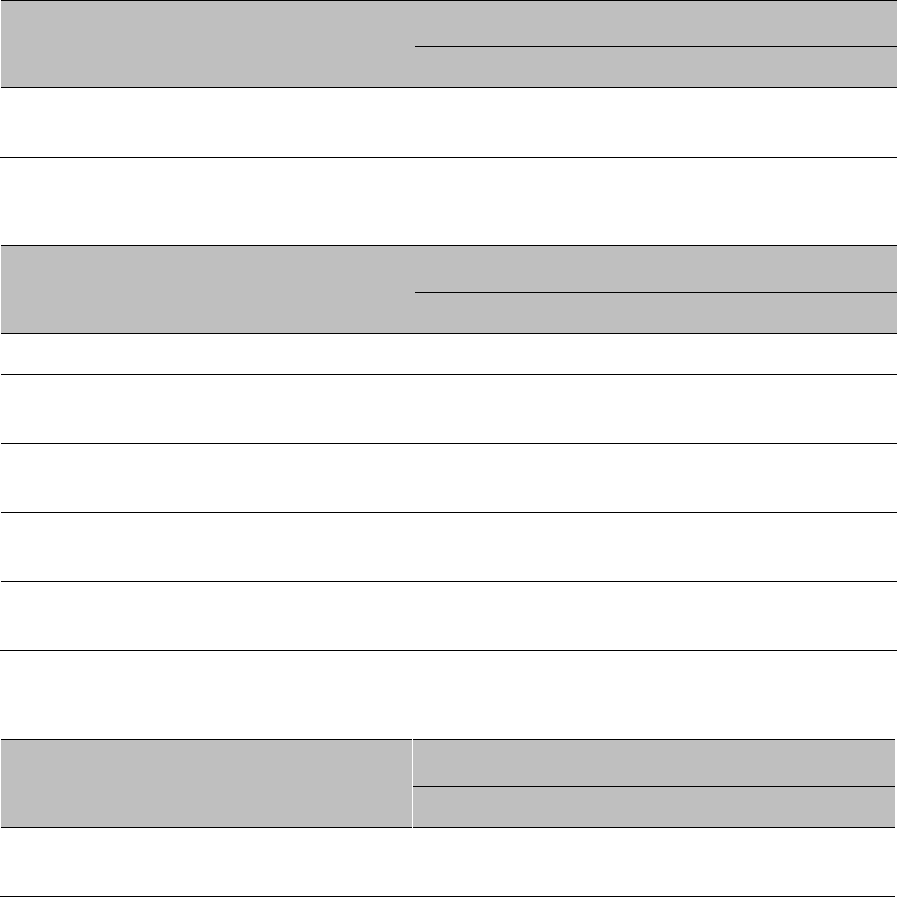
Chapter 3: System planning
Site planning
Page 3-12
Table 51 PMP 450m wind loading (Newton)
Type of ODU
Max surface area
(square meters)
Wind speed (kilometer per hour)
160
170
180
190
200
Integrated 90º sector
antenna
0.331
671
757
849
946
1048
Table 52 PMP/PTP 450i wind loading (Newton)
Type of ODU
Max surface area
(square meters)
Wind speed (kilometer per hour)
160
170
180
190
200
Connectorized
0.035
94
106
119
132
146
Directional antenna –
5.x GHz
0.093
249
281
315
351
389
Integrated 90º sector
antenna -5.x GHz
0.126
337
381
427
475
527
Directional Yagi
antenna - 900 MHz
0.025
67
76
85
94
105
External 65º sector
antenna – 900 MHz
0.253
677
764
857
954
1058
Table 53 PMP 450m wind loading (lb force)
Type of ODU
Max surface area
(square feet)
Wind speed (miles per hour)
100
105
110
115
120
Integrated 90º sector
antenna
3.565
150
165
181
198
216

Chapter 3: System planning
Site planning
Page 3-13
Table 54 PMP/PTP 450i wind loading (lb force)
Type of ODU
Max surface area
(square feet)
Wind speed (miles per hour)
100
105
110
115
120
Connectorized
0.377
16
17
19
21
23
Directional antenna –
5.x GHz
1.001
42
46
51
56
61
Integrated 90º sector
antenna -5.x GHz
1.356
57
63
69
75
82
Directional Yagi
antenna - 900 MHz
0.27
11
13
14
15
16
External 65º sector
antenna – 900 MHz
2.72
114
126
138
151
165
For a connectorized ODU, add the wind loading of the external antenna to that of the ODU. The
antenna manufacturer should be able to quote wind loading.
Table 55 PMP/PTP 450 wind loading (Newton)
Type of ODU
Max surface area
(square meters)
Wind speed (kilometer per hour)
160
170
180
190
200
External 60º sector
antenna – 2.4 GHz AP
0.27
722
815
914
1019
1129
External 60º sector
antenna – 5 GHz AP
0.066
177
199
223
249
276
External 90º sector
antenna – 5 GHz AP
0.083
222
251
281
313
347
SM
0.027
72
82
91
102
113
Integrated High-Gain,
Ruggedized
0.093
249
281
315
351
389
Integrated Dish
0.14
375
423
474
528
585

Chapter 3: System planning
Site planning
Page 3-14
Table 56 PMP/PTP 450 wind loading (lb force)
Type of ODU
Max surface area
(square feet)
Wind speed (miles per hour)
100
105
110
115
120
External 60º sector
antenna – 2.4 GHz
AP
2.9
122
134
147
161
175
External 60º sector
antenna – 5 GHz AP
0.71
29.8
33
37
39
43
External 90º sector
antenna – 5 GHz AP
0.89
37
41
45
49
54
SM
0.29
12
13
15
16
18
Integrated High-
Gain, Ruggedized
1
42
46
51
56
60
Integrated Dish
1.49
63
69
76
83
90
Drop cable grounding points
To estimate how many grounding kits are required for each drop cable, refer to the site installation
diagrams (Figure 30 , Figure 31 and Figure 32) and use the following criteria:
The drop cable shield must be grounded near the ODU at the first point of contact between the
drop cable and the mast, tower or building.
The drop cable shield must be grounded at the building entry point.
For mast or tower installations (Figure 30), use the following additional criteria:
The drop cable shield must be grounded at the bottom of the tower, near the vertical to
horizontal transition point. This ground cable must be bonded to the tower or tower ground
bus bar (TGB), if installed.
If the tower is greater than 61 m (200 ft) in height, the drop cable shield must be grounded at
the tower midpoint, and at additional points as necessary to reduce the distance between
ground cables to 61 m (200 ft) or less.
In high lightning-prone geographical areas, the drop cable shield must be grounded at spacing
between 15 to 22 m (50 to 75 ft). This is especially important on towers taller than 45 m (150 ft).
For roof installations (Figure 32), use the following additional criteria:
The drop cable shield must be bonded to the building grounding system at its top entry point
(usually on the roof).
The drop cable shield must be bonded to the building grounding system at the entry point to
the equipment room.
Chapter 3: System planning
Site planning
Page 3-15
Lightning Protection Unit(LPU) location
Find a location for the bottom LPU that meets the following requirements:
The bottom LPU can be connected to the drop cable from the ODU.
The bottom LPU is within 600 mm (24 in) of the point at which the drop cable enters the
building, enclosure or equipment room within a larger building.
The bottom LPU can be bonded to the grounding system.

Chapter 3: System planning
Radio Frequency planning
Page 3-16
Radio Frequency planning
This section describes how to plan PMP/PTP 450 platform links to conform to analysis of spectrum
and the regulatory restrictions that apply in the country of operation.
Regulatory limits
Many countries impose EIRP limits (Allowed EIRP) on products operating in the bands used by the
PMP/PTP 450 platform Series.
Refer to Equipment Disposal (Chapter 10: Reference Information) on page 10-37 to determine what
the maximum transmitted power and EIRP for PMP/PTP 450/450i Series that can be used in each of
countries and frequency band.
Caution
It is the responsibility of the user to ensure that the PMP/PTP product is operated in
accordance with local regulatory limits.
Note
Contact the applicable radio regulator to find out whether or not registration of the
PMP/PTP 450/450i link is required.
Conforming to the limits
Ensure the link is configured to conform to local regulatory requirements by configuring the PMP
450/450i AP or PTP 450/450iBHM for the correct country. In the following situations, this does not
prevent operation outside the regulations:
When using connectorized ODUs with external antennas, the regulations may require the
maximum transmit power to be reduced.
Available spectrum
The available spectrum for operation depends on the regulatory band. When configured
appropriately, the unit will only allow operation on those channels which are permitted by the
regulations.
Chapter 3: System planning
Radio Frequency planning
Page 3-17
Certain regulations have allocated certain channels as unavailable for use:
FCC has allocated part of the 5.1 & 5.2 GHz
ETSI has allocated part of the 5.4 GHz band to weather radar.
UK and some other European countries have allocated part of the 5.8 GHz band to Road
Transport and Traffic Telematics (RTTT) systems.
The number and identity of channels barred in a given regulatory band is dependent on the
channel bandwidth and channel raster selected.
Analyzing the RF Environment
An essential element in RF network planning is the analysis of spectrum usage and the strength of
the signals that occupy the spectrum. Regardless of how these parameters are measured and log
or chart the results (through the Spectrum Analyzer feature or by using a spectrum analyzer),
ensure measurements are performed:
At various times of day.
On various days of the week.
Periodically into the future.
As new RF neighbors move in or consumer devices proliferate in currently used spectrum, this
keeps the user aware of the dynamic possibilities for interference within the network.
Channel bandwidth
Select the required channel bandwidth for the link. The selection depends upon the regulatory
band selected.
The wider the channel bandwidth, the greater the capacity. As narrower channel bandwidths take
up less spectrum, selecting a narrow channel bandwidth may be a better choice when operating in
locations where the spectrum is very busy.
Both ends of the link must be configured to operate on the same channel bandwidth.
Anticipating Reflection of Radio Waves
In the signal path, any object that is larger than the wavelength of the signal can reflect the signal.
Such an object can even be the surface of the earth or of a river, bay or lake. The wavelength of the
signal is approximately
2 inches (or 5 cm) for 5.4 GHz and 5.8 GHz signals.
12 inches for 900 MHz signals
A reflected signal can arrive at the antenna of the receiver later than the non-reflected signal
arrives. These two or more signals cause the condition known as multipath. Multipath may
increase or decrease the signal level, resulting in overall attenuation that may be higher or lower
than that caused by the link distance. This is problematic at the margin of the link budget, where
the standard operating margin (fade margin) may be compromised.

Chapter 3: System planning
Radio Frequency planning
Page 3-18
Obstructions in the Fresnel Zone
The Fresnel (pronounced fre∙NEL) Zone is a three-dimensional volume around the line of sight of
an antenna transmission. Objects that penetrate this area can cause the received strength of the
transmitted signal to fade. Out-of-phase reflections and absorption of the signal result in signal
cancellation.
The foliage of trees and plants in the Fresnel Zone can cause signal loss. Seasonal density,
moisture content of the foliage, and other factors such as wind may change the amount of loss.
Plan to perform frequent and regular link tests if you must transmit through foliage.
Planning for co-location
The first step to avoid interference in wireless systems is to set all AP/BHMs to receive timing from
a synchronization source (Cluster Management Module, or Universal Global Positioning System).
This ensures that the modules are in sync and start transmitting at the same time each frame.
The second step to avoid interference is to configure parameters on all AP/BHMs of the same
frequency band in proximity such that they have compatible transmit/receive ratios (all stop
transmitting each frame before any start receiving). This avoids the problem of one AP/BHM
attempting to receive the signal from a distant SM/BHS while a nearby AP/BHM transmits, which
could overpower that signal.
The following parameters on the AP/BHM determine the transmit/receive ratio:
Downlink Data percentage
(reserved) Contention slots
If OFDM (PMP/PTP 450 platform, PMP/PTP 230) and FSK (PMP/PTP 1x0) APs/BHMs of the same
frequency band are in proximity, or if you want BHMs set to different parameters then you must
use the Frame Calculator to identify compatible settings for APs/BHMs.
The co-location is also supported for 900 MHz PMP 450i APs (OFDM) and PMP 100 APs (FSK).
The Frame Calculator is available on the web management interface Tools > Frame Calculator. To
use the Frame Calculator, type into the calculator various configurable parameter values for each
proximal AP/BHM and then record the resulting AP/BHM Receive Start value. Next vary the
Downlink Data percentage in each calculation and iterate until a calculated AP/BHM Receive Start
for all co-located AP/BHMs where the transmit end does not come before the receive start.
For more information on PMP/PTP 450 platform co-location, see
http://www.cambiumnetworks.com/solution-papers
Multiple OFDM Access Point Clusters
When deploying multiple AP clusters in a dense area, consider aligning the clusters as shown
below. However, this is only a recommendation. An installation may dictate a different pattern of
channel assignments.
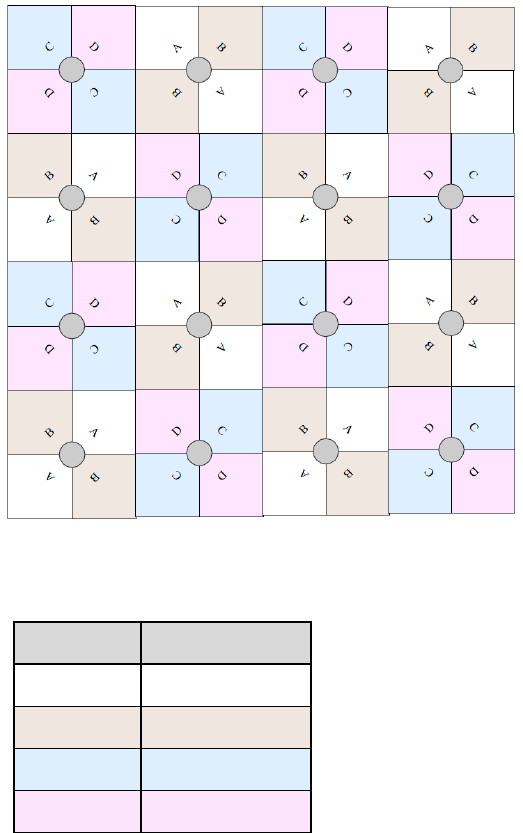
Chapter 3: System planning
Radio Frequency planning
Page 3-19
Figure 36 Example layout of 16 Access Point sectors (ABCD), 90 degree sectors
An example for assignment of frequency channels is provided in the following table.
Table 57 Example 5.8 GHz 4-channel assignment by access site
Symbol
Frequency
A
5.740 GHz
B
5.760 GHz
C
5.780 GHz
D
5.800 GHz
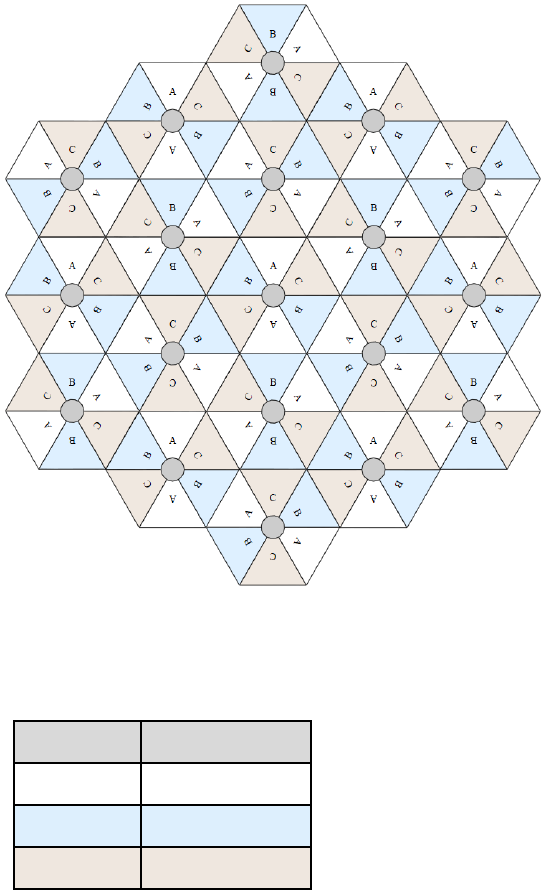
Chapter 3: System planning
Radio Frequency planning
Page 3-20
Figure 37 Example layout of 6 Access Point sectors (ABC), 60 degree sectors
An example for assignment of frequency channels and sector IDs is provided in the following
table.
Table 58 Example 5.8 GHz 3-channel assignment by access site
Symbol
Frequency
A
5.740 GHz
B
5.760 GHz
C
5.780 GHz

Chapter 3: System planning
Link planning
Page 3-21
Link planning
This section describes factors to be taken into account when planning links, such as range,
obstacles path loss and throughput. LINKPlanner is recommended.
Range and obstacles
Calculate the range of the link and identify any obstacles that may affect radio performance.
Perform a survey to identify all the obstructions (such as trees or buildings) in the path and to
assess the risk of interference. This information is necessary in order to achieve an accurate link
feasibility assessment.
The PMP/PTP 450 platform Series is designed to operate in Non-Line-of-Sight (NLoS) and Line-of-
Sight (LoS) environments. An NLOS environment is one in which there is no optical line-of-sight,
that is, there are obstructions between the antennas.
OFDM technology can often use multi-pathing to an advantage to overcome nLOS, especially in
cases where the Fresnel zone is only partially blocked by buildings, “urban canyons”, or foliage.
OFDM tends to help especially when obstacles are near the middle of the link, and less so when
the obstacles are very near the ODU.
However, attenuation through walls and trees is substantial for any use of the 5.4 GHz and 5.8 GHz
frequency bands. The lower frequency radio waves of 900 MHz radios provide greater penetration
through walls, trees and other obstacles, making it optimal for most non-line-of-sight applications.
Even with OFDM, these products are not expected to penetrate walls or extensive trees and
foliage.
Path loss
Path loss is the amount of attenuation the radio signal undergoes between the two ends of the
link. The path loss is the sum of the attenuation of the path if there were no obstacles in the way
(Free Space Path Loss), the attenuation caused by obstacles (Excess Path Loss) and a margin to
allow for possible fading of the radio signal (Fade Margin). The following calculation needs to be
performed to judge whether a particular link can be installed:
capabilityseasonalfadeexcessspacefree LLLLL
_
Where:
Is:
spacefree
L_
Free Space Path Loss (dB)
excess
L
Excess Path Loss (dB)
fade
L
Fade Margin Required (dB)
seasonal
L
Seasonal Fading (dB)

Chapter 3: System planning
Link planning
Page 3-22
capability
L
Equipment Capability (dB)
Calculating Link Loss
The link loss is the total attenuation of the wireless signal between two point-to-multipoint units.
The link loss calculation is presented below:
Link Loss (dB) = Transmit power of the remote wireless unit (dBm) − Tx Cable loss
(dB) − Received power at the local unit (dBm) – Rx cable loss (dB) +
Antenna gain at the remote unit (dBi) + Antenna gain at the local unit
(dBi)
Calculating Rx Signal Level
The determinants in Rx signal level are illustrated in Figure 38.
Figure 38 Determinants in Rx signal level
Rx signal level is calculated as follows:
Rx signal level dB = Tx power − Tx cable loss + Tx antenna gain
− free space path loss + Rx antenna gain − Rx cable loss
Note
This Rx signal level calculation presumes that a clear line of sight is established
between the transmitter and receiver and that no objects encroach in the Fresnel zone.
Chapter 3: System planning
Link planning
Page 3-23
Calculating Fade Margin
Free space path loss is a major determinant in Rx (received) signal level. Rx signal level, in turn, is
a major factor in the system operating margin (fade margin), which is calculated as follows:
System operating margin (fade margin) dB = Rx signal level dB − Rx sensitivity dB
Thus, fade margin is the difference between strength of the received signal and the strength that
the receiver requires for maintaining a reliable link. A higher fade margin is characteristic of a
more reliable link.
Adaptive modulation
Adaptive modulation ensures that the highest throughput that can be achieved instantaneously
will be obtained, taking account of propagation and interference. When the link has been installed,
web pages provide information about the link loss currently measured by the equipment, both
instantaneously and averaged. The averaged value will require maximum seasonal fading to be
added, and then the radio reliability of the link can be computed.
For details of the system throughput, link loss and maximum distance for each frequency band in
all modulation modes, see Link on page 10-34.

Chapter 3: System planning
Planning for connectorized units
Page 3-24
Planning for connectorized units
This section describes factors to be taken into account when planning to use connectorized ODUs
with external antennas in PMP/PTP 450 platform links.
When to install connectorized units
The majority of radio links can be successfully deployed with the integrated ODU. However the
integrated units may not be sufficient in some areas, for example:
Where the path is heavily obscured by dense woodland on an NLOS link.
Where long LOS links are required.
Where there are known to be high levels of interference.
In these areas, connectorized ODUs and external antennas should be used.
Choosing external antennas
When selecting external antennas, consider the following factors:
The required antenna gain.
Ease of mounting and alignment.
Use dual-polarization antenna (as the integrated antenna).
Note
Enter the antenna gain and cable loss into the Installation Wizard, if the country
selected has an EIRP limit, the corresponding maximum transmit power will be
calculated automatically by the unit.
Calculating RF cable length (5.8 GHz FCC only)
The 5.8 GHz band FCC approval for the product is based on tests with a cable loss between the
ODU and antenna of not less than 1.2 dB. If cable loss is below 1.2 dB with a 1.3 m (4 ft) diameter
external antenna, the connectorized PMP/PTP 450 platform may exceed the maximum radiated
spurious emissions allowed under FCC 5.8 GHz rules.
Cable loss depends mainly upon cable type and length. To meet or exceed the minimum loss of
1.2 dB, use cables of the type and length specified in Table 59 (source: Times Microwave). This
data excludes connector losses.

Chapter 3: System planning
Planning for connectorized units
Page 3-25
Table 59 RF cable lengths required to achieve 1.2 dB loss at 5.8 GHz
RF cable type
Minimum cable length
LMR100
0.6 m (1.9 ft)
LMR200
1.4 m (4.6 ft)
LMR300
2.2 m (7.3 ft)
LMR400
3.4 m (11.1 ft)
LMR600
5.0 m (16.5 ft)

Chapter 3: System planning
Data network planning
Page 3-26
Data network planning
This section describes factors to be considered when planning PMP/PTP 450 platform data
networks.
Understanding addresses
A basic understanding of Internet Protocol (IP) address and subnet mask concepts is required for
engineering your IP network.
IP address
The IP address is a 32-bit binary number that has four parts (octets). This set of four octets has two
segments, depending on the class of IP address. The first segment identifies the network. The
second identifies the hosts or devices on the network. The subnet mask marks a boundary
between these two sub-addresses.
Dynamic or static addressing
For any computer to communicate with a module, the computer must be configured to either
use DHCP (Dynamic Host Configuration Protocol). In this case, when not connected to the
network, the computer derives an IP address on the 169.254 network within two minutes.
have an assigned static IP address (for example, 169.254.1.5) on the 169.254 network.
Note
If an IP address that is set in the module is not the 169.254.x.x network address, then
the network operator must assign the computer a static IP address in the same subnet.
When a DHCP server is not found
To operate on a network, a computer requires an IP address, a subnet mask, and possibly a
gateway address. Either a DHCP server automatically assigns this configuration information to a
computer on a network or an operator must input these items.
When a computer is brought on line and a DHCP server is not accessible (such as when the server
is down or the computer is not plugged into the network), Microsoft and Apple operating systems
default to an IP address of 169.254.x.x and a subnet mask of 255.255.0.0 (169.254/16, where /16
indicates that the first 16 bits of the address range are identical among all members of the subnet).
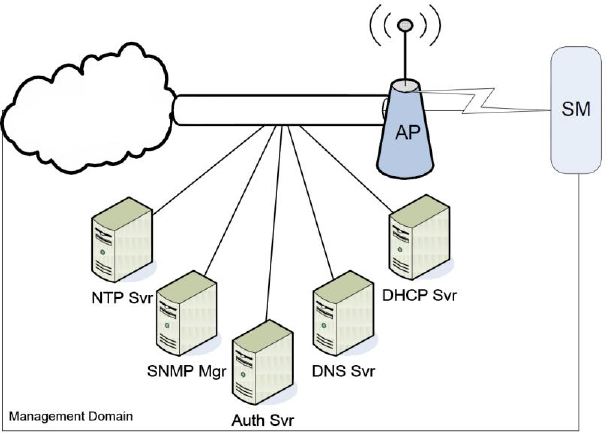
Chapter 3: System planning
Data network planning
Page 3-27
DNS Client
The DNS Client is used to resolve names of management servers within the operator’s
management domain (see Figure 39). This feature allows hostname configuration for NTP servers,
Authorization Servers, DHCP relay servers, and SNMP trap servers. Operators may choose to
either enter in the FQDN (Fully Qualified Domain Name) for the host name or to manually enter the
IP addresses of the servers.
Figure 39 Cambium networks management domain
Network Address Translation (NAT)
NAT, DHCP Server, DHCP Client and DMZ in SM
The system provides NAT (network address translation) for SMs in the following combinations of
NAT and DHCP (Dynamic Host Configuration Protocol):
NAT Disabled
NAT with DHCP Client (DHCP selected as the Connection Type of the WAN interface) and DHCP
Server
NAT with DHCP Client(DHCP selected as the Connection Type of the WAN interface)
NAT with DHCP Server
NAT without DHCP
NAT
NAT isolates devices connected to the Ethernet/wired side of a SM from being seen directly from
the wireless side of the SM. With NAT enabled, the SM has an IP address for transport traffic
(separate from its address for management), terminates transport traffic, and allows you to assign
a range of IP addresses to devices that are connected to the Ethernet/wired side of the SM.
Chapter 3: System planning
Data network planning
Page 3-28
In the Cambium system, NAT supports many protocols, including HTTP, ICMP (Internet Control
Message Protocols), and FTP (File Transfer Protocol). For virtual private network (VPN)
implementation, L2TP over IPSec (Level 2 Tunneling Protocol over IP Security) and PPTP (Point to
Point Tunneling Protocol) are supported.
DHCP
DHCP enables a device to be assigned a new IP address and TCP/IP parameters, including a default
gateway, whenever the device reboots. Thus DHCP reduces configuration time, conserves IP
addresses, and allows modules to be moved to a different network within the Cambium system.
In conjunction with the NAT features, each SM provides:
A DHCP server that assigns IP addresses to computers connected to the SM by Ethernet
protocol.
A DHCP client that receives an IP address for the SM from a network DHCP server.
DMZ
In conjunction with the NAT features, a DMZ (demilitarized zone) allows the assignment of one IP
address behind the SM for a device to logically exist outside the firewall and receive network
traffic. The first three octets of this IP address must be identical to the first three octets of the NAT
private IP address.
Developing an IP addressing scheme
Network elements are accessed through IP Version 4 (IPv4) addressing.
A proper IP addressing method is critical to the operation and security of a network.
Each module requires an IP address on the network. This IP address is for only management
purposes. For security, you must either:
Assign a non-routable IP address.
Assign a routable IP address only if a firewall is present to protect the module.
You assign an IP addresses to computers and network components by either static or dynamic IP
addressing. You will also assign the appropriate subnet mask and network gateway to each
module.
Address Resolution Protocol
As previously stated, the MAC address identifies a module in:
Communications between modules.
The data that modules store about each other.
Chapter 3: System planning
Data network planning
Page 3-29
The IP address is essential for data delivery through a router interface. Address Resolution
Protocol (ARP) correlates MAC addresses to IP addresses.
For communications to outside the network segment, ARP reads the network gateway address of
the router and translates it into the MAC address of the router. Then the communication is sent to
MAC address (physical network interface card) of the router.
For each router between the sending module and the destination, this sequence applies. The ARP
correlation is stored until the ARP cache times out.
Allocating subnets
The subnet mask is a 32-bit binary number that filters the IP address. Where a subnet mask
contains a bit set to 1, the corresponding bit in the IP address is part of the network address.
Example IP address and subnet mask
In Figure 40, the first 16 bits of the 32-bit IP address identify the network:
Figure 40 Example of IP address in Class B subnet
Octet 1
Octet 2
Octet 3
Octet 4
IP address 169.254.1.1
10101001
11111110
00000001
00000001
Subnet mask 255.255.0.0
11111111
11111111
00000000
00000000
In this example, the network address is 169.254 and 216 (65,536) hosts are addressable.
Selecting non-routable IP addresses
The factory default assignments for network elements are:
Unique MAC address
IP address of 169.254.1.1
Subnet mask of 255.255.0.0
Network gateway address of 169.254.0.0
For each radio and CMM4, assign an IP address that is both consistent with the IP addressing plan
for your network and cannot be accessed from the Internet. IP addresses within the following
ranges are not routable from the Internet, regardless of whether a firewall is configured:
10.0.0.0 – 10.255.255.255
172.16.0.0 – 172.31.255.255
192.168.0.0 – 192.168.255.255
Also, the subnet mask and network gateway for each CMM4 can be assigned.
Chapter 3: System planning
Data network planning
Page 3-30
Translation bridging
Optionally, the AP can be configured to change the source MAC address in every packet it receives
from its SMs to the MAC address of the SM/BHS that bridged the packet, before forwarding the
packet toward the public network. In this case:
Not more than 128 IP devices at any time are valid to send data to the AP from behind the SM.
SM populates the Translation Table tab of its Statistics web page, displaying the MAC address
and IP address of all the valid connected devices.
Each entry in the Translation Table is associated with the number of minutes that have elapsed
since the last packet transfer between the connected device and the SM.
If 128 are connected, and another attempts to connect:
o If no Translation Table entry is older than 255 minutes, the attempt is ignored.
o If an entry is older than 255 minutes, the oldest entry is removed and the attempt is
successful.
The Send Untranslated ARP parameter in the General tab of the Configuration page can be:
o Disabled, so that the AP overwrites the MAC address in ARP packets before forwarding
them.
o Enabled, so that the AP forwards ARP packets regardless of whether it has overwritten the
MAC address.
This is the Translation Bridging feature, which you can enable in the General page of the
Configuration web page in the AP. When this feature is disabled, the setting of the
Send Untranslated ARP parameter has no effect, because all packets are forwarded untranslated
(with the source MAC address intact). See Address Resolution Protocol on Page 3-28.
Engineering VLANs
The radios support VLAN functionality as defined in the 802.1Q (Virtual LANs) specification, except
for the following aspects of that specification:
Protocols:
o Generic Attribute Registration Protocol (GARP) GARV
o Spanning Tree Protocol (STP)
o Multiple Spanning Tree Protocol (MSTP)
o GARP Multicast Registration Protocol (GMRP)
Embedded source routing (ERIF) in the 802.1Q header
Multicast pruning
Flooding unknown unicast frames in the downlink
As an additional exception, the AP/BHM does not flood downward the unknown unicast frames to
the SM/BHS.
A VLAN configuration in Layer 2 establishes a logical group within the network. Each computer in
the VLAN, regardless of initial or eventual physical location, has access to the same data. For the
network operator, this provides flexibility in network segmentation, simpler management, and
enhanced security.

Chapter 3: System planning
Data network planning
Page 3-31
Special case VLAN numbers
This system handles special case VLAN numbers according to IEEE specifications:
Table 60 Special case VLAN IDs
VLAN Number
Purpose
Usage Constraint
0
These packets have 802.1p priority, but are
otherwise handled as untagged.
Must not be used as a
management VLAN.
1
Although not noted as special case by IEEE
specifications, these packets identify traffic
that was untagged upon ingress into the SM
and must remain untagged upon egress.
This policy is hard-coded in the AP.
Must not be used for
system VLAN traffic.
4095
This VLAN is reserved for internal use.
Must not be used at all.
SM membership in VLANs
With the supported VLAN functionality, the radios determine bridge forwarding on the basis of not
only the destination MAC address, but also the VLAN ID of the destination. This provides flexibility
in how SMs are used:
Each SM can be a member in its own VLAN.
Each SM can be in its own broadcast domain, such that only the radios that are members of
the VLAN can see broadcast and multicast traffic to and from the SM.
The network operator can define a work group of SMs, regardless of the AP(s) to which they
register.

Chapter 3: System planning
Data network planning
Page 3-32
PMP 450 platform modules provide the VLAN frame filters that are described in Table 61.
Table 61 VLAN filters in point-to-multipoint modules
Where VLAN is active,
if this parameter value
is selected …
then a frame is discarded if…
because of this VLAN
filter in the software:
entering the bridge/
NAT switch through…
Ethernet…
TCP/IP…
any combination of
VLAN
parameter settings
with a VID not in the
membership table
Ingress
any combination of
VLAN
parameter settings
with a VID not in
the
membership table
Local Ingress
Allow Frame Types:
Tagged Frames Only
with no 802.1Q tag
Only Tagged
Allow Frame Types:
Untagged Frames Only
with an 802.1Q tag,
regardless of VID
Only Untagged
Local SM Management:
Disable in the SM, or
All Local SM
Management:
Disable in the AP
with an 802.1Q tag
and a VID in the
membership table
Local SM Management
leaving the bridge/
NAT switch through…
Ethernet…
TCP/IP…
any combination of
VLAN
parameter settings
with a VID not in the
membership table
Egress
any combination of
VLAN
parameter settings
with a VID not in
the
membership table
Local Egress
Priority on VLANs (802.1p)
The radios can prioritize traffic based on the eight priorities described in the IEEE 802.1p
specification. When the high-priority channel is enabled on a SM, regardless of whether VLAN is
enabled on the AP for the sector, packets received with a priority of 4 through 7 in the 802.1p field
are forwarded onto the high-priority channel.

Chapter 3: System planning
Data network planning
Page 3-33
Operators may configure priority precedence as 802.1p Then Diffserv (Default) or Diffserv Then
802.1p. Since these priority precedence configurations are independent between the AP and SM,
this setting must be configured on both the AP and SM to ensure that the precedence is adhered to
by both sides of the link.
VLAN settings can also cause the module to convert received non-VLAN packets into VLAN
packets. In this case, the 802.1p priority in packets leaving the module is set to the priority
established by the DiffServ configuration.
If VLAN is enabled, immediately monitor traffic to ensure that the results are as desired. For
example, high-priority traffic may block low-priority.
Q-in-Q DVLAN (Double-VLAN) Tagging (802.1ad)
PMP and PTP modules can be configured with 802.1ad Q-in-Q DVLAN (Double-VLAN) tagging
which is a way for an operator to put an 802.1Q VLAN inside of an 802.1ad VLAN. A nested VLAN,
which is the original 802.1Q tag and a new second 802.1ad tag, allows for bridging of VLAN traffic
across a network and segregates the broadcast domains of 802.1Q VLANs. Q-in-Q can be used
with PPPoE and/or NAT.
The 802.1ad standard defines the S-VLAN as the Service Provider VLAN and the C-VLAN as the
customer VLAN. The radio software does 2 layer Q-in-Q whereby the C-VLAN is the 802.1Q tag and
the S-VLAN is the second layer Q tag as shown in Table 62.
Table 62 Q-in-Q Ethernet frame
Ethernet Header
S-VLAN EthType
0x88a8
C-VLAN EthType
0x8100
IP Data EthType 0x0800
The 802.1ad S-VLAN is the outer VLAN that is configurable on the Configuration > VLAN web page
of the AP/BHM. The Q-in-Q EtherType parameter is configured with a default EtherType of 0x88a8
in addition to four alternate EtherTypes that can be configured to aid in interoperability with
existing networks that use a different EtherType than the default.
The C-VLAN is the inner VLAN tag, which is the same as 802.1Q. As a top level concept, this
operates on the outermost tag at any given time, either “pushing” a tag on or “popping” a tag off.
This means packets will at most transition from an 802.1Q frame to an 801.ad frame (with a tag
“pushed” on) or an untagged 802.1 frame (with the tag “popped” off. Similarly, for an 802.1ad
frame, this can only transition from an 802.1ad frame to an 802.1Q frame (with the tag “popped”
off) since the radio software only supports 2 levels of tags.

Chapter 3: System planning
Network management planning
Page 3-34
Network management planning
This section describes how to plan for PMP/PTP 450 platform links to be managed remotely using
SNMP.
Planning for SNMP operation
Cambium modules provide the following SNMP traps for automatic notifications to the NMS:
coldStart, which signals that the SNMPv2c element is reinitializing itself and that its
configuration may have been altered.
warmStart, which signals that the SNMPv2c element is reinitializing such that its configuration
is unaltered.
authenticationFailure, which signals that the SNMPv2c element has received a protocol
message that is not properly authenticated (contingent on the snmpEnableAuthenTraps object
setting).
linkDown, as defined in RFC 1573
linkUp, as defined in RFC 1573
egpNeighborLoss, as defined in RFC 1213
whispGPSInSync, which signals a transition from not synchronized to synchronized.
whispGPSOutSync, which signals a transition from synchronized to not synchronized.
whispRegComplete, which signals registration completed.
whispRegLost, which signals registration lost.
whispRadarDetected, which signals that the one-minute scan has been completed, radar has
been detected and the radio will shut down.
whispRadarEnd, which signals that the one-minute scan has been completed, radar has not
been detected and the radio will resume normal operation.
Note
The proprietary MIBs are provided in the PMP/PTP 450 platform Series software
download files in the support website (see Contacting Cambium Networks on page 1).
Enabling SNMP
Enable the SNMP interface for use by configuring the following attributes in the SNMP
Configuration page:
SNMP State (default disabled)
SNMP Version (default SNMPv2c)
SNMP Port Number (default 161)

Chapter 3: System planning
Security planning
Page 3-35
Security planning
This section describes how to plan for PMP/PTP 450 platform links to operate in secure mode.
Managing module access by passwords
Filtering protocols and ports
Port Configuration
Isolating AP/BHM from the Internet
Ensure that the IP addresses of the AP/BHM in the network:
are not routable over the Internet.
do not share the subnet of the IP address of your user.
RFC 1918, Address Allocation for Private Subnets, reserves for private IP networks three blocks of
IP addresses that are not routable over the Internet:
/8 subnets have one reserved network, 10.0.0.0 to 10.255.255.255.
/16 subnets have 16 reserved networks, 172.16.0.0 to 172.31.255.255.
/24 subnets have 256 reserved networks, 192.168.0.0 to 192.168.255.255.
Encrypting radio transmissions
Cambium fixed wireless broadband IP systems employ the following form of encryption for
security of the wireless link:
DES (Data Encryption Standard): An over-the-air link encryption option that uses secret 56-bit
keys and 8 parity bits. DES performs a series of bit permutations, substitutions, and
recombination operations on blocks of data. DES encryption does not affect the performance
or throughput of the system.
AES (Advanced Encryption Standard): An over-the-air link encryption option that uses the
Rijndael algorithm and 128-bit keys to establish a higher level of security than DES. AES
products are certified as compliant with the Federal Information Processing Standards (FIPS
197) in the U.S.A.
The default encryption setting for 450 platform is "None".

Chapter 3: System planning
Security planning
Page 3-36
Planning for HTTPS operation
Before starting to configure HTTPS operation, ensure that the cryptographic material listed in
Table 63 is available.
Table 63 HTTPS security material
Item
Description
Quantity required
User Defined Security
Banner
The banner provides warnings and notices
to be read by the user before logging in to
the ODU. Use text that is appropriate to
the network security policy.
Normally one per link.
This depends upon
network policy.
Port numbers for HTTP,
HTTPS and Telnet
Port numbers allocated by the network.
As allocated by
network.
Planning for SNMPv3 operation
SNMP security mode
Decide how SNMPv3 security will be configured.
MIB-based security management uses standard SNMPv3 MIBs to configure the user-based
security model and the view-based access control model. This approach provides considerable
flexibility, allowing a network operator to tailor views and security levels appropriate for different
types of user. MIB-based security management may allow a network operator to take advantage of
built-in security management capabilities of existing network managers.
Web-based security management allows an operator to configure users, security levels, privacy
and authentication protocols, and passphrases using the PMP/PTP 450 platform web-based
management interface. The capabilities supported are somewhat less flexible than those
supported using the MIB-based security management, but will be sufficient in many applications.
Selection of web-based management for SNMPv3 security disables the MIB-based security
management. PMP/PTP 450 platform does not support concurrent use of MIB-based and web-
based management of SNMPv3 security.
Web-based management of SNMPv3 security
Initial configuration of SNMPv3 security is available only to HTTP or HTTPS user accounts with
security role of Security Officer.
Identify the format used for SNMP Engine ID. The following formats are available:
MAC address (default)
5 and 32 hex characters (the hex character input is driven by RFC 3411 recommendations on
the Engine ID)

Chapter 3: System planning
Security planning
Page 3-37
Identify the user names and security roles of initial SNMPv3 users. Two security roles are
available:
Read Only
System Administrator
Identify the security level for each of the security roles. Three security levels are available:
(a) No authentication, no privacy
(b) Authentication, no privacy
(c) Authentication, privacy
If authentication is required, identify the protocol. The authentication protocol available is MD5.
If privacy will be used, identify the protocol. The privacy protocol available is cbc-des.
Managing module access by passwords
From the factory, each module has a preconfigured administrator-level account in the name root,
which initially requires no associated password. When you upgrade a module:
An account is created in the name admin.
Both admin and root inherit the password that was previously used to access the module, if:
o Full Access password, if one was set.
o Display-Only Access password, if one was set and no Full Access password was set.
Caution
If you use Wireless Manager, do not delete the root account from any module. If you
use a NMS that communicates with modules through SNMP, do not delete the root
account from any module unless you first can confirm that the NMS does not rely on
the root account for access to the modules.
Each module supports four or fewer user accounts, regardless of account levels. The available
levels are
ADMINISTRATOR, who has full read and write permissions. This is the level of the root and
admin users, as well as any other administrator accounts that one of them creates.
INSTALLER, who has permissions identical to those of ADMINISTRATOR except that the
installer cannot add or delete users or change the password of any other user.
TECHNICIAN, who has permissions to modify basic radio parameters and view informational
web pages.
GUEST, who has no write permissions and only a limited view of General Status tab.
Admin, Installer and Tech accounts can be configured as READ-ONLY. This will allow the
account to only see the items.
The ability to view information of General Status tab can be controlled by the "Site Information
Viewable to Guest Users" under the SNMP tab.
Chapter 3: System planning
Security planning
Page 3-38
From the factory default state, configure passwords for both the root and admin account at the
ADMINISTRATOR permission level, using the Account > Change Users Password page. (If
configure only one of these, then the other will still require no password for access into it and thus
remain a security risk.) If you are intent on configuring only one of them, delete the admin account.
The root account is the only account that CNUT uses to update the module.
After a password has been set for any ADMINISTRATOR-level account, initial access to the module
GUI opens the view of GUEST level.
Planning for RADIUS operation
Configure RADIUS where remote authentication is required for users of the web-based interface.
Remote authentication has the following advantages:
Control of passwords can be centralized.
Management of user accounts can be more sophisticated. For example; users can be prompted
by a network manager to change passwords at regular intervals. As another example,
passwords can be checked for inclusion of dictionary words and phrases.
Passwords can be updated without reconfiguring multiple network elements.
User accounts can be disabled without reconfiguring multiple network elements.
Remote authentication has one significant disadvantage in a wireless link product such as
PMP/PTP 450 platform. If the wireless link is down, a unit on the remote side of the broken link
may be prevented from contacting a RADIUS Server, with the result that users are unable to
access the web-based interface.
One useful strategy would be to combine RADIUS authentication for normal operation with a
single locally-authenticated user account for emergency use.
PMP 450 platform SM provides a choice of the following authentication methods:
EAP-MSCHAPv2
EAP-TTLS
Ensure that the authentication method selected in PMP/PTP 450 platform is supported by the
RADIUS server.
Filtering protocols and ports
Configure filters for specified protocols and ports from leaving the AP/BHM and SM/BHS and
entering the network. This protects the network from both intended and inadvertent packet loading
or probing by network users. By keeping the specified protocols or ports off the network, this
feature also provides a level of protection to users from each other.
Protocol and port filtering is set per AP/SM/BH. Except for filtering of SNMP ports, filtering occurs
as packets leave the AP/SM/BH.
For example, if SM is configured to filter SNMP, then SNMP packets are blocked from entering the
SM and, thereby, from interacting with the SNMP portion of the protocol stack on the SM.

Chapter 3: System planning
Security planning
Page 3-39
Port Filtering with NAT Enabled
Where NAT is enabled on the SM/BHS, the filtering can be enabled for only the user-defined ports.
The following are examples for situations where the configure port can be filtered where NAT is
enabled:
To block a subscriber from using FTP, you can filter Ports 20 and 21 (the FTP ports) for both the
TCP and UDP protocols.
To block a subscriber from access to SNMP, you can filter Ports 161 and 162 (the SNMP ports)
for both the TCP and UDP protocols.
Note
In only the SNMP case, filtering occurs before the packet interacts with the protocol
stack.
Protocol and Port Filtering with NAT Disabled
Where NAT is disabled on the SM/BHS, the filtering can be enabled for both protocols and the
three user-defined ports. Using the check boxes on the interface, it can be either:
Allow all protocols except those that user wish to block.
Block all protocols except those that user wish to allow.
Allow or block any of the following protocols:
PPPoE (Point to Point Protocol over Ethernet)
Any or all of the following IPv4 (Internet Protocol version 4) protocols:
Any or all of the following IPv4 (Internet Protocol version 4) protocols:
o SMB (Network Neighborhood)
o SNMP
o Bootp Client
o Bootp Server
o Up to 3 user-defined ports
o All other IPv4 traffic (see Figure 29)
Any or all of the following IPv6 (Internet Protocol version 6) protocols:
o SMB (Network Neighborhood)
o SNMP
o Bootp Client
o Bootp Server
o Up to 3 user-defined ports
o All other IPv6 traffic (see Figure 29)
Filter Direction – Upstream and Downstream
ARP (Address Resolution Protocol)
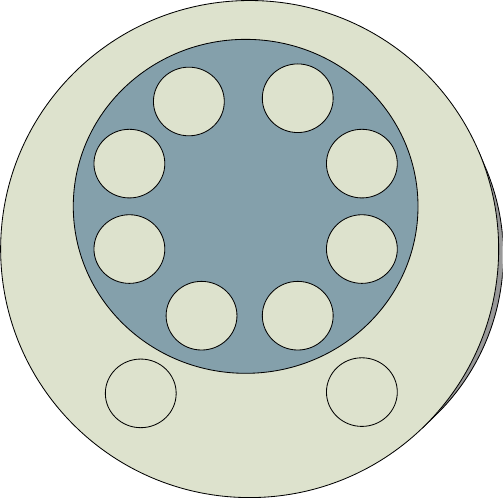
Chapter 3: System planning
Security planning
Page 3-40
Figure 41 Categorical protocol filtering
The following are example situations in which the protocol filtering is configured where NAT is
disabled:
If a subscriber is blocked from only PPPoE and SNMP, then the subscriber retains access to all
other protocols and all ports.
If PPPoE, IPv4, and Uplink Broadcast are blocked, and also check the All others selection, then
only Address Resolution Protocol is not filtered.
The ports filtered as a result of protocol selections in the Protocol Filtering tab of the SM/BHS are
listed in Table 64.
BootP
Client
BootP
Server
SNMP IPv4
Multica
st
User
Defined
Port 1 SMB
User
Defined
Port 3
User
Defined
Port 2
PPPoE ARP
All
Others
All
Other
IPv4

Chapter 3: System planning
Security planning
Page 3-41
Table 64 Ports filtered per protocol selections
Port Configuration
PMP/PTP 450 platform supports access to various communication protocols and only the ports
required for these protocols are available for access by external entities. Operators may change
the port numbers for these protocols via the radio GUI or SNMP.
Table 65 Device default port numbers
Port
Usage
Port Usage
Device
21
FTP
Listen Port
AP, SM
80
HTTP
Listen Port
AP, SM
443
HTTPS
Listen Port
AP, SM
161
SNMP port
Listen Port
AP, SM
162
SNMP trap port
Destination Port
AP, SM
514
Syslog Server port
Destination Port
AP, SM
1812
Standard RADIUS port
Destination Port
AP
1813
Standard RADIUS accounting port
Destination Port
AP, SM
Protocol Selected
Port Filtered (Blocked)
SMB
Destination Ports UDP : 137, 138, 139, 445, 3702 and 1900
Destination Ports TCP : 137, 138, 139, 445, 2869, 5357 and 5358
SNMP
Destination Ports TCP and UDP : 161 and 162
Bootp Client
Source Port 68 UDP
Bootp Server
Source Port 67 UDP
User Defined Port 1..3
User defined ports for filtering UDP and TCP
IPv4 Multicast
Block IPv4 packet types except other filters defined
IPv6 Multicast
Block IPv6 packet types except other filters defined
ARP
Filter all Ethernet packet type 806
Upstream
Applies packet filtering to traffic coming into the FEC interface
Downstream
Applies packet filtering to traffic destined to exit the FEC
interface
Chapter 3: System planning
Security planning
Page 3-42
Encrypting downlink broadcasts
An AP can be enabled to encrypt downlink broadcast packets such as the following:
ARP
NetBIOS
broadcast packets containing video data on UDP.
The encryption used is DES for a DES-configured module and AES for an AES-configured module.
Before the Encrypt Downlink Broadcast feature is enabled on the AP, air link security must be
enabled on the AP.
Isolating SMs in PMP
In an AP, SMs in the sector can be prevented from directly communicating with each other. In
CMM4, the connected APs can be prevented from directly communicating with each other, which
prevents SMs that are in different sectors of a cluster from communicating with each other.
In the AP, the SM Isolation parameter is available in the General tab of the Configuration web
page. Configure the SM Isolation feature by any of the following selections from drop-down menu:
Disable SM Isolation (the default selection). This allows full communication between SMs.
Enable Option 1 - Block SM destined packets from being forwarded. This prevents both
multicast/broadcast and unicast SM-to-SM communication.
Enable Option 2 - Forward SM destined packets upstream. This not only prevents
multicast/broadcast and unicast SM-to-SM communication but also sends the packets, which
otherwise may have been handled SM to SM, through the Ethernet port of the AP.
In the CMM and the CMM4, SM isolation treatment is the result of how to manage the port-based
VLAN feature of the embedded switch, where all traffic can be switched from any AP to a specified
uplink port. However, this is not packet level switching. It is not based on VLAN IDs.
Filtering management through Ethernet
Configure the SM to disallow any device that is connected to its Ethernet port from accessing the
IP address of the SM. If the Ethernet Access Control parameter is set to Enabled, then:
No attempt to access the SM management interface (by http, SNMP, ftp, or tftp) through
Ethernet is granted.
Any attempt to access the SM management interface over the air (by IP address, presuming
that LAN1 Network Interface Configuration, Network Accessibility is set to Public, or by link
from the Session Status or Remote Subscribers tab in the AP) is unaffected.
Chapter 3: System planning
Security planning
Page 3-43
Allowing management from only specified IP addresses
The Security sub-menu of the Configuration web page in the AP/BHM and SM/BHS includes the IP
Access Control parameter. Specify one, two, or three IP addresses that must be allowed to access
the management interface (by HTTP, SNMP, FTP or TFTP).
If the selection is:
IP Access Filtering Disabled, then management access is allowed from any IP address, even if
the Allowed Source IP 1 to 3 parameters are populated.
IP Access Filtering Enabled, and specify at least one address in the Allowed Source IP 1 to 3
parameter, then management access is limited to the specified address(es).
Configuring management IP by DHCP
The Configuration > IP web page of every radio contains a LAN1 Network Interface Configuration,
DHCP State parameter that, if enabled, causes the IP configuration (IP address, subnet mask, and
gateway IP address) to be obtained through DHCP instead of the values of those individual
parameters. The setting of this DHCP state parameter is also viewable, but is not settable, in the
Network Interface tab of the Home page.
In the SM/BHS, this parameter is settable
in the NAT tab of the Configuration web page, but only if NAT is enabled.
in the IP tab of the Configuration web page, but only if the Network Accessibility parameter in
the IP tab is set to Public.
DHCP option 81
The DHCP server can be used to register and update the pointer (PTR) and host (A) DNS resource
records on behalf of its DHCP-enabled clients.
The DHCP option 81 permits the client to provide its fully qualified domain name (FQDN) as well as
instructions to the DHCP server on how it would like the server to process DNS dynamic updates
(if any) on its behalf. The hostname is poplulated as SiteName.DomainName depending upon
following conditions:
If Sitename is default i.e. No Site Name , mac address will be used instead.
The SiteName should only be a-z | A-Z | 0-9 and period(.) and dash(-).
The domain name part should not start or end with dash (-).
The underscore or space in domain name part will be converted to dash(-), anything else apart
from valid characters will be skipped.
Chapter 3: System planning
Security planning
Page 3-44
Controlling PPPoE PADI Downlink Forwarding
The AP supports the control of forwarding of PPPoE PADI (PPPoE Active Discovery Initiation)
packets. This forwarding is configured on the AP GUI Configuration > Radio page by parameter
PPPoE PADI Downlink Forwarding. When set to “Enabled”, the AP allows downstream and
upstream transmission of PPPoE PADI packets. When set to “Disabled”, the AP does NOT allow
PPPoE PADI packets to be sent out of the AP RF interface (downstream) but will allow PPPoE PADI
packets to enter the RF interface (upstream) and exit the Ethernet interface.

Page 4-1
Chapter 4: Legal and regulatory information
This chapter provides end user license agreements and regulatory notifications.
Caution
Intentional or unintentional changes or modifications to the equipment must not be
made unless under the express consent of the party responsible for compliance. Any
such modifications could void the user’s authority to operate the equipment and will
void the manufacturer’s warranty.
Attention
Changements ou modifications Intentionnels ou non de l'équipement ne doivent pas
être entrepris sans l'autorisation de l’organisme responsable de la déclaration de
conformité. Ces modifications ou changements pourraient invalider le droit de
l'utilisateur à utiliser cet appareil et annuleraient la garantie du fabricant.
The following topics are described in this chapter:
Cambium Networks end user license agreement on page 4-2 contains the Cambium and third
party license agreements for the PMP/PTP 450 platform Series products.
Compliance with safety standards on page 4-22 lists the safety specifications against which the
PMP/PTP 450 platform has been tested and certified. It also describes how to keep RF exposure
within safe limits.
Compliance with radio regulations on page 4-31 describes how the PMP/PTP 450 platform
complies with the radio regulations that are in force in various countries, and contains
notifications made to regulatory bodies for the PMP/PTP 450 platform.

Chapter 4: Legal and regulatory information
Cambium Networks end user license agreement
Page 4-2
Cambium Networks end user license agreement
Definitions
In this Agreement, the word “Software” refers to the set of instructions for computers, in
executable form and in any media, (which may include diskette, CD-ROM, downloadable internet,
hardware, or firmware) licensed to you. The word “Documentation” refers to electronic or printed
manuals and accompanying instructional aids licensed to you. The word “Product” refers to
Cambium Networks’ fixed wireless broadband devices for which the Software and Documentation
is licensed for use.
Acceptance of this agreement
In connection with Cambium Networks’ delivery of certain proprietary software or products
containing embedded or pre-loaded proprietary software, or both, Cambium Networks is willing to
license this certain proprietary software and the accompanying documentation to you only on the
condition that you accept all the terms in this End User License Agreement (“Agreement”).
IF YOU DO NOT AGREE TO THE TERMS OF THIS AGREEMENT, DO NOT USE THE PRODUCT OR
INSTALL THE SOFTWARE. INSTEAD, YOU MAY, FOR A FULL REFUND, RETURN THIS PRODUCT
TO THE LOCATION WHERE YOU ACQUIRED IT OR PROVIDE WRITTEN VERIFICATION OF
DELETION OF ALL COPIES OF THE SOFTWARE. ANY USE OF THE SOFTWARE, INCLUDING BUT
NOT LIMITED TO USE ON THE PRODUCT, WILL CONSTITUTE YOUR ACCEPTANCE TO THE
TERMS OF THIS AGREEMENT.
Grant of license
Cambium Networks Limited (“Cambium”) grants you (“Licensee” or “you”) a personal,
nonexclusive, non-transferable license to use the Software and Documentation subject to the
Conditions of Use set forth in “Conditions of use” and the terms and conditions of this Agreement.
Any terms or conditions relating to the Software and Documentation appearing on the face or
reverse side of any purchase order, purchase order acknowledgment or other order document that
are different from, or in addition to, the terms of this Agreement will not be binding on the parties,
even if payment is accepted.
Chapter 4: Legal and regulatory information
Cambium Networks end user license agreement
Page 4-3
Conditions of use
Any use of the Software and Documentation outside of the conditions set forth in this Agreement
is strictly prohibited and will be deemed a breach of this Agreement.
1. Only you, your employees or agents may use the Software and Documentation. You will take all
necessary steps to insure that your employees and agents abide by the terms of this Agreement.
2. You will use the Software and Documentation (i) only for your internal business purposes; (ii)
only as described in the Software and Documentation; and (iii) in strict accordance with this
Agreement.
3. You may use the Software and Documentation, provided that the use is in conformance with the
terms set forth in this Agreement.
4. Portions of the Software and Documentation are protected by United States copyright laws,
international treaty provisions, and other applicable laws. Therefore, you must treat the Software
like any other copyrighted material (for example, a book or musical recording) except that you may
either: (i) make 1 copy of the transportable part of the Software (which typically is supplied on
diskette, CD-ROM, or downloadable internet), solely for back-up purposes; or (ii) copy the
transportable part of the Software to a PC hard disk, provided you keep the original solely for back-
up purposes. If the Documentation is in printed form, it may not be copied. If the Documentation
is in electronic form, you may print out 1 copy, which then may not be copied. With regard to the
copy made for backup or archival purposes, you agree to reproduce any Cambium Networks
copyright notice, and other proprietary legends appearing thereon. Such copyright notice(s) may
appear in any of several forms, including machine-readable form, and you agree to reproduce
such notice in each form in which it appears, to the extent it is physically possible to do so.
Unauthorized duplication of the Software or Documentation constitutes copyright infringement,
and in the United States is punishable in federal court by fine and imprisonment.
5. You will not transfer, directly or indirectly, any product, technical data or software to any
country for which the United States Government requires an export license or other governmental
approval without first obtaining such license or approval.
Chapter 4: Legal and regulatory information
Cambium Networks end user license agreement
Page 4-4
Title and restrictions
If you transfer possession of any copy of the Software and Documentation to another party outside
of the terms of this agreement, your license is automatically terminated. Title and copyrights to the
Software and Documentation and any copies made by you remain with Cambium Networks and its
licensors. You will not, and will not permit others to: (i) modify, translate, decompile, bootleg,
reverse engineer, disassemble, or extract the inner workings of the Software or Documentation,
(ii) copy the look-and-feel or functionality of the Software or Documentation; (iii) remove any
proprietary notices, marks, labels, or logos from the Software or Documentation; (iv) rent or
transfer all or some of the Software or Documentation to any other party without Cambium’s prior
written consent; or (v) utilize any computer software or hardware which is designed to defeat any
copy protection device, should the Software and Documentation be equipped with such a
protection device. If the Software and Documentation is provided on multiple types of media (such
as diskette, CD-ROM, downloadable internet), then you will only use the medium which best meets
your specific needs, and will not loan, rent, lease, or transfer the other media contained in the
package without Cambium’s written consent. Unauthorized copying of the Software or
Documentation, or failure to comply with any of the provisions of this Agreement, will result in
automatic termination of this license.
Confidentiality
You acknowledge that all Software and Documentation contain valuable proprietary information
and trade secrets and that unauthorized or improper use of the Software and Documentation will
result in irreparable harm to Cambium Networks for which monetary damages would be
inadequate and for which Cambium Networks will be entitled to immediate injunctive relief. If
applicable, you will limit access to the Software and Documentation to those of your employees
and agents who need to use the Software and Documentation for your internal business purposes,
and you will take appropriate action with those employees and agents to preserve the
confidentiality of the Software and Documentation, using the same degree of care to avoid
unauthorized or improper disclosure as you use for the protection of your own proprietary
software, but in no event less than reasonable care.
You have no obligation to preserve the confidentiality of any proprietary information that: (i) was
in the public domain at the time of disclosure; (ii) entered the public domain through no fault of
yours; (iii) was given to you free of any obligation to keep it confidential; (iv) is independently
developed by you; or (v) is disclosed as required by law provided that you notify Cambium
Networks prior to such disclosure and provide Cambium Networks with a reasonable opportunity
to respond.
Chapter 4: Legal and regulatory information
Cambium Networks end user license agreement
Page 4-5
Right to use Cambium’s name
Except as required in “Conditions of use”, you will not, during the term of this Agreement or
thereafter, use any trademark of Cambium Networks, or any word or symbol likely to be confused
with any Cambium Networks trademark, either alone or in any combination with another word or
words.
Transfer
The Software and Documentation may not be transferred to another party without the express
written consent of Cambium Networks, regardless of whether or not such transfer is accomplished
by physical or electronic means. Cambium’s consent may be withheld at its discretion and may be
conditioned upon transferee paying all applicable license fees and agreeing to be bound by this
Agreement.
Updates
During the first 12 months after purchase of a Product, or during the term of any executed
Maintenance and Support Agreement for the Product, you are entitled to receive Updates. An
“Update” means any code in any form which is a bug fix, patch, error correction, or minor
enhancement, but excludes any major feature added to the Software. Updates are available for
download at the support website.
Major features may be available from time to time for an additional license fee. If Cambium
Networks makes available to you major features and no other end user license agreement is
provided, then the terms of this Agreement will apply.
Maintenance
Except as provided above, Cambium Networks is not responsible for maintenance or field service
of the Software under this Agreement.
Chapter 4: Legal and regulatory information
Cambium Networks end user license agreement
Page 4-6
Disclaimer
CAMBIUM NETWORKS DISCLAIMS ALL WARRANTIES OF ANY KIND, WHETHER EXPRESS,
IMPLIED, STATUTORY, OR IN ANY COMMUNICATION WITH YOU. CAMBIUM NETWORKS
SPECIFICALLY DISCLAIMS ANY WARRANTY INCLUDING THE IMPLIED WARRANTIES OF
MERCHANTABILTY, NONINFRINGEMENT, OR FITNESS FOR A PARTICULAR PURPOSE. THE
SOFTWARE AND DOCUMENTATION ARE PROVIDED “AS IS.” CAMBIUM NETWORKS DOES NOT
WARRANT THAT THE SOFTWARE WILL MEET YOUR REQUIREMENTS, OR THAT THE OPERATION
OF THE SOFTWARE WILL BE UNINTERRUPTED OR ERROR FREE, OR THAT DEFECTS IN THE
SOFTWARE WILL BE CORRECTED. CAMBIUM NETWORKS MAKES NO WARRANTY WITH
RESPECT TO THE CORRECTNESS, ACCURACY, OR RELIABILITY OF THE SOFTWARE AND
DOCUMENTATION. Some jurisdictions do not allow the exclusion of implied warranties, so the
above exclusion may not apply to you.
Limitation of liability
IN NO EVENT SHALL CAMBIUM NETWORKS BE LIABLE TO YOU OR ANY OTHER PARTY FOR ANY
DIRECT, INDIRECT, GENERAL, SPECIAL, INCIDENTAL, CONSEQUENTIAL, EXEMPLARY OR OTHER
DAMAGE ARISING OUT OF THE USE OR INABILITY TO USE THE PRODUCT (INCLUDING,
WITHOUT LIMITATION, DAMAGES FOR LOSS OF BUSINESS PROFITS, BUSINESS
INTERRUPTION, LOSS OF BUSINESS INFORMATION OR ANY OTHER PECUNIARY LOSS, OR
FROM ANY BREACH OF WARRANTY, EVEN IF CAMBIUM NETWORKS HAS BEEN ADVISED OF
THE POSSIBILITY OF SUCH DAMAGES. (Some states do not allow the exclusion or limitation of
incidental or consequential damages, so the above exclusion or limitation may not apply to you.)
IN NO CASE SHALL CAMBIUM’S LIABILITY EXCEED THE AMOUNT YOU PAID FOR THE PRODUCT.
U.S. government
If you are acquiring the Product on behalf of any unit or agency of the U.S. Government, the
following applies. Use, duplication, or disclosure of the Software and Documentation is subject to
the restrictions set forth in subparagraphs (c) (1) and (2) of the Commercial Computer Software –
Restricted Rights clause at FAR 52.227-19 (JUNE 1987), if applicable, unless being provided to the
Department of Defense. If being provided to the Department of Defense, use, duplication, or
disclosure of the Products is subject to the restricted rights set forth in subparagraph (c) (1) (ii) of
the Rights in Technical Data and Computer Software clause at DFARS 252.227-7013 (OCT 1988), if
applicable. Software and Documentation may or may not include a Restricted Rights notice, or
other notice referring specifically to the terms and conditions of this Agreement. The terms and
conditions of this Agreement will each continue to apply, but only to the extent that such terms
and conditions are not inconsistent with the rights provided to you under the aforementioned
provisions of the FAR and DFARS, as applicable to the particular procuring agency and
procurement transaction.
Chapter 4: Legal and regulatory information
Cambium Networks end user license agreement
Page 4-7
Term of license
Your right to use the Software will continue in perpetuity unless terminated as follows. Your right
to use the Software will terminate immediately without notice upon a breach of this Agreement by
you. Within 30 days after termination of this Agreement, you will certify to Cambium Networks in
writing that through your best efforts, and to the best of your knowledge, the original and all
copies, in whole or in part, in any form, of the Software and all related material and
Documentation, have been destroyed, except that, with prior written consent from Cambium
Networks, you may retain one copy for archival or backup purposes. You may not sublicense,
assign or transfer the license or the Product, except as expressly provided in this Agreement. Any
attempt to otherwise sublicense, assign or transfer any of the rights, duties or obligations
hereunder is null and void.
Governing law
This Agreement is governed by the laws of the United States of America to the extent that they
apply and otherwise by the laws of the State of Illinois.
Assignment
This agreement may not be assigned by you without Cambium’s prior written consent.
Survival of provisions
The parties agree that where the context of any provision indicates an intent that it survives the
term of this Agreement, then it will survive.
Entire agreement
This agreement contains the parties’ entire agreement regarding your use of the Software and
may be amended only in writing signed by both parties, except that Cambium Networks may
modify this Agreement as necessary to comply with applicable laws.
Third party software
The software may contain one or more items of Third-Party Software supplied by other third-party
suppliers. The terms of this Agreement govern your use of any Third-Party Software UNLESS A
SEPARATE THIRD-PARTY SOFTWARE LICENSE IS INCLUDED, IN WHICH CASE YOUR USE OF THE
THIRD-PARTY SOFTWARE WILL THEN BE GOVERNED BY THE SEPARATE THIRD-PARTY LICENSE.
Chapter 4: Legal and regulatory information
Cambium Networks end user license agreement
Page 4-8
Net SNMP
Various copyrights apply to this package, listed in various separate parts below. Please make sure
that you read all the parts.
---- Part 1: CMU/UCD copyright notice: (BSD like) -----
Copyright 1989, 1991, 1992 by Carnegie Mellon University
Derivative Work - 1996, 1998-2000
Copyright 1996, 1998-2000 The Regents of the University of California
All Rights Reserved
Permission to use, copy, modify and distribute this software and its documentation for any
purpose and without fee is hereby granted, provided that the above copyright notice appears in all
copies and that both that copyright notice and this permission notice appear in supporting
documentation, and that the name of CMU and The Regents of the University of California not be
used in advertising or publicity pertaining to distribution of the software without specific written
permission.
CMU AND THE REGENTS OF THE UNIVERSITY OF CALIFORNIA DISCLAIM ALL WARRANTIES
WITH REGARD TO THIS SOFTWARE, INCLUDING ALL IMPLIED WARRANTIES OF
MERCHANTABILITY AND FITNESS. IN NO EVENT SHALL CMU OR THE REGENTS OF THE
UNIVERSITY OF CALIFORNIA BE LIABLE FOR ANY SPECIAL, INDIRECT OR CONSEQUENTIAL
DAMAGES OR ANY DAMAGES WHATSOEVER RESULTING FROM THE LOSS OF USE, DATA OR
PROFITS, WHETHER IN AN ACTION OF CONTRACT, NEGLIGENCE OR OTHER TORTIOUS ACTION,
ARISING OUT OF OR IN CONNECTION WITH THE USE OR PERFORMANCE OF THIS SOFTWARE.
---- Part 2: Networks Associates Technology, Inc copyright notice (BSD) -----
Copyright © 2001-2003, Networks Associates Technology, Inc
All rights reserved.
Redistribution and use in source and binary forms, with or without modification, are permitted
provided that the following conditions are met:
Redistributions of source code must retain the above copyright notice, this list of conditions
and the following disclaimer.
Redistributions in binary form must reproduce the above copyright notice, this list of
conditions and the following disclaimer in the documentation and/or other materials provided
with the distribution.
Neither the name of the Networks Associates Technology, Inc nor the names of its contributors
may be used to endorse or promote products derived from this software without specific prior
written permission.
Chapter 4: Legal and regulatory information
Cambium Networks end user license agreement
Page 4-9
THIS SOFTWARE IS PROVIDED BY THE COPYRIGHT HOLDERS AND CONTRIBUTORS “AS IS”
AND ANY EXPRESS OR IMPLIED WARRANTIES, INCLUDING, BUT NOT LIMITED TO, THE IMPLIED
WARRANTIES OF MERCHANTABILITY AND FITNESS FOR A PARTICULAR PURPOSE ARE
DISCLAIMED. IN NO EVENT SHALL THE COPYRIGHT HOLDERS OR CONTRIBUTORS BE LIABLE
FOR ANY DIRECT, INDIRECT, INCIDENTAL, SPECIAL, EXEMPLARY, OR CONSEQUENTIAL
DAMAGES (INCLUDING, BUT NOT LIMITED TO, PROCUREMENT OF SUBSTITUTE GOODS OR
SERVICES; LOSS OF USE, DATA, OR PROFITS; OR BUSINESS INTERRUPTION) HOWEVER
CAUSED AND ON ANY THEORY OF LIABILITY, WHETHER IN CONTRACT, STRICT LIABILITY, OR
TORT (INCLUDING NEGLIGENCE OR OTHERWISE) ARISING IN ANY WAY OUT OF THE USE OF
THIS SOFTWARE, EVEN IF ADVISED OF THE POSSIBILITY OF SUCH DAMAGE.
---- Part 3: Cambridge Broadband Ltd. copyright notice (BSD) -----
Portions of this code are copyright © 2001-2003, Cambridge Broadband Ltd.
All rights reserved.
Redistribution and use in source and binary forms, with or without modification, are permitted
provided that the following conditions are met:
Redistributions of source code must retain the above copyright notice, this list of conditions
and the following disclaimer.
Redistributions in binary form must reproduce the above copyright notice, this list of
conditions and the following disclaimer in the documentation and/or other materials provided
with the distribution.
The name of Cambridge Broadband Ltd. may not be used to endorse or promote products
derived from this software without specific prior written permission.
THIS SOFTWARE IS PROVIDED BY THE COPYRIGHT HOLDER “AS IS” AND ANY EXPRESS OR
IMPLIED WARRANTIES, INCLUDING, BUT NOT LIMITED TO, THE IMPLIED WARRANTIES OF
MERCHANTABILITY AND FITNESS FOR A PARTICULAR PURPOSE ARE DISCLAIMED. IN NO
EVENT SHALL THE COPYRIGHT HOLDER BE LIABLE FOR ANY DIRECT, INDIRECT, INCIDENTAL,
SPECIAL, EXEMPLARY, OR CONSEQUENTIAL DAMAGES (INCLUDING, BUT NOT LIMITED TO,
PROCUREMENT OF SUBSTITUTE GOODS OR SERVICES; LOSS OF USE, DATA, OR PROFITS; OR
BUSINESS INTERRUPTION) HOWEVER CAUSED AND ON ANY THEORY OF LIABILITY, WHETHER
IN CONTRACT, STRICT LIABILITY, OR TORT (INCLUDING NEGLIGENCE OR OTHERWISE) ARISING
IN ANY WAY OUT OF THE USE OF THIS SOFTWARE, EVEN IF ADVISED OF THE POSSIBILITY OF
SUCH DAMAGE.
---- Part 4: Sun Microsystems, Inc. copyright notice (BSD) -----
Copyright © 2003 Sun Microsystems, Inc., 4150 Network Circle, Santa Clara,
California 95054, U.S.A. All rights reserved.
Use is subject to license terms below.
This distribution may include materials developed by third parties.
Sun, Sun Microsystems, the Sun logo and Solaris are trademarks or registered trademarks of Sun
Microsystems, Inc. in the U.S. and other countries.
Redistribution and use in source and binary forms, with or without modification, are permitted
provided that the following conditions are met:
Chapter 4: Legal and regulatory information
Cambium Networks end user license agreement
Page 4-10
Redistributions of source code must retain the above copyright notice, this list of conditions
and the following disclaimer.
Redistributions in binary form must reproduce the above copyright notice, this list of
conditions and the following disclaimer in the documentation and/or other materials provided
with the distribution.
Neither the name of the Sun Microsystems, Inc. nor the names of its contributors may be used
to endorse or promote products derived from this software without specific prior written
permission.
THIS SOFTWARE IS PROVIDED BY THE COPYRIGHT HOLDERS AND CONTRIBUTORS “AS IS”
AND ANY EXPRESS OR IMPLIED WARRANTIES, INCLUDING, BUT NOT LIMITED TO, THE IMPLIED
WARRANTIES OF MERCHANTABILITY AND FITNESS FOR A PARTICULAR PURPOSE ARE
DISCLAIMED. IN NO EVENT SHALL THE COPYRIGHT HOLDERS OR CONTRIBUTORS BE LIABLE
FOR ANY DIRECT, INDIRECT, INCIDENTAL, SPECIAL, EXEMPLARY, OR CONSEQUENTIAL
DAMAGES (INCLUDING, BUT NOT LIMITED TO, PROCUREMENT OF SUBSTITUTE GOODS OR
SERVICES; LOSS OF USE, DATA, OR PROFITS; OR BUSINESS INTERRUPTION) HOWEVER
CAUSED AND ON ANY THEORY OF LIABILITY, WHETHER IN CONTRACT, STRICT LIABILITY, OR
TORT (INCLUDING NEGLIGENCE OR OTHERWISE) ARISING IN ANY WAY OUT OF THE USE OF
THIS SOFTWARE, EVEN IF ADVISED OF THE POSSIBILITY OF SUCH DAMAGE.
---- Part 5: Sparta, Inc copyright notice (BSD) -----
Copyright © 2003-2008, Sparta, Inc
All rights reserved.
Redistribution and use in source and binary forms, with or without modification, are permitted
provided that the following conditions are met:
Redistributions of source code must retain the above copyright notice, this list of conditions
and the following disclaimer.
Redistributions in binary form must reproduce the above copyright notice, this list of
conditions and the following disclaimer in the documentation and/or other materials provided
with the distribution.
Neither the name of Sparta, Inc nor the names of its contributors may be used to endorse or
promote products derived from this software without specific prior written permission.
THIS SOFTWARE IS PROVIDED BY THE COPYRIGHT HOLDERS AND CONTRIBUTORS “AS IS”
AND ANY EXPRESS OR IMPLIED WARRANTIES, INCLUDING, BUT NOT LIMITED TO, THE IMPLIED
WARRANTIES OF MERCHANTABILITY AND FITNESS FOR A PARTICULAR PURPOSE ARE
DISCLAIMED. IN NO EVENT SHALL THE COPYRIGHT HOLDERS OR CONTRIBUTORS BE LIABLE
FOR ANY DIRECT, INDIRECT, INCIDENTAL, SPECIAL, EXEMPLARY, OR CONSEQUENTIAL
DAMAGES (INCLUDING, BUT NOT LIMITED TO, PROCUREMENT OF SUBSTITUTE GOODS OR
SERVICES; LOSS OF USE, DATA, OR PROFITS; OR BUSINESS INTERRUPTION) HOWEVER
CAUSED AND ON ANY THEORY OF LIABILITY, WHETHER IN CONTRACT, STRICT LIABILITY, OR
TORT (INCLUDING NEGLIGENCE OR OTHERWISE) ARISING IN ANY WAY OUT OF THE USE OF
THIS SOFTWARE, EVEN IF ADVISED OF THE POSSIBILITY OF SUCH DAMAGE.
---- Part 6: Cisco/BUPTNIC copyright notice (BSD) -----
Copyright © 2004, Cisco, Inc and Information Network
Center of Beijing University of Posts and Telecommunications.
Chapter 4: Legal and regulatory information
Cambium Networks end user license agreement
Page 4-11
All rights reserved.
Redistribution and use in source and binary forms, with or without modification, are permitted
provided that the following conditions are met:
Redistributions of source code must retain the above copyright notice, this list of conditions
and the following disclaimer.
Redistributions in binary form must reproduce the above copyright notice, this list of
conditions and the following disclaimer in the documentation and/or other materials provided
with the distribution.
Neither the name of Cisco, Inc, Beijing University of Posts and Telecommunications, nor the
names of their contributors may be used to endorse or promote products derived from this
software without specific prior written permission.
THIS SOFTWARE IS PROVIDED BY THE COPYRIGHT HOLDERS AND CONTRIBUTORS “AS IS”
AND ANY EXPRESS OR IMPLIED WARRANTIES, INCLUDING, BUT NOT LIMITED TO, THE IMPLIED
WARRANTIES OF MERCHANTABILITY AND FITNESS FOR A PARTICULAR PURPOSE ARE
DISCLAIMED. IN NO EVENT SHALL THE COPYRIGHT HOLDERS OR CONTRIBUTORS BE LIABLE
FOR ANY DIRECT, INDIRECT, INCIDENTAL, SPECIAL, EXEMPLARY, OR CONSEQUENTIAL
DAMAGES (INCLUDING, BUT NOT LIMITED TO, PROCUREMENT OF SUBSTITUTE GOODS OR
SERVICES; LOSS OF USE, DATA, OR PROFITS; OR BUSINESS INTERRUPTION) HOWEVER
CAUSED AND ON ANY THEORY OF LIABILITY, WHETHER IN CONTRACT, STRICT LIABILITY, OR
TORT (INCLUDING NEGLIGENCE OR OTHERWISE) ARISING IN ANY WAY OUT OF THE USE OF
THIS SOFTWARE, EVEN IF ADVISED OF THE POSSIBILITY OF SUCH DAMAGE.
---- Part 7: Fabasoft R&D Software GmbH & Co KG copyright notice (BSD) -----
Copyright © Fabasoft R&D Software GmbH & Co KG, 2003
oss@fabasoft.com
Author: Bernhard Penz
Redistribution and use in source and binary forms, with or without modification, are permitted
provided that the following conditions are met:
Redistributions of source code must retain the above copyright notice, this list of conditions
and the following disclaimer.
Redistributions in binary form must reproduce the above copyright notice, this list of
conditions and the following disclaimer in the documentation and/or other materials provided
with the distribution.
The name of Fabasoft R&D Software GmbH & Co KG or any of its subsidiaries, brand or
product names may not be used to endorse or promote products derived from this software
without specific prior written permission.
Chapter 4: Legal and regulatory information
Cambium Networks end user license agreement
Page 4-12
THIS SOFTWARE IS PROVIDED BY THE COPYRIGHT HOLDER “AS IS” AND ANY EXPRESS OR
IMPLIED WARRANTIES, INCLUDING, BUT NOT LIMITED TO, THE IMPLIED WARRANTIES OF
MERCHANTABILITY AND FITNESS FOR A PARTICULAR PURPOSE ARE DISCLAIMED. IN NO
EVENT SHALL THE COPYRIGHT HOLDER BE LIABLE FOR ANY DIRECT, INDIRECT, INCIDENTAL,
SPECIAL, EXEMPLARY, OR CONSEQUENTIAL DAMAGES (INCLUDING, BUT NOT LIMITED TO,
PROCUREMENT OF SUBSTITUTE GOODS OR SERVICES; LOSS OF USE, DATA, OR PROFITS; OR
BUSINESS INTERRUPTION) HOWEVER CAUSED AND ON ANY THEORY OF LIABILITY, WHETHER
IN CONTRACT, STRICT LIABILITY, OR TORT (INCLUDING NEGLIGENCE OR OTHERWISE) ARISING
IN ANY WAY OUT OF THE USE OF THIS SOFTWARE, EVEN IF ADVISED OF THE POSSIBILITY OF
SUCH DAMAGE.
OpenSSL
Copyright (c) 1998-2008 The OpenSSL Project. All rights reserved.
Redistribution and use in source and binary forms, with or without modification, are permitted
provided that the following conditions are met:
1. Redistributions of source code must retain the above copyright notice, this list of conditions and
the following disclaimer.
2. Redistributions in binary form must reproduce the above copyright notice, this list of conditions
and the following disclaimer in the documentation and/or other materials provided with the
distribution.
3. All advertising materials mentioning features or use of this software must display the following
acknowledgment:
“This product includes software developed by the OpenSSL Project for use in the OpenSSL
Toolkit. (http://www.openssl.org/)”
4. The names “OpenSSL Toolkit” and “OpenSSL Project” must not be used to endorse or promote
products derived from this software without prior written permission. For written permission,
please contact openssl-core@openssl.org.
5. Products derived from this software may not be called “OpenSSL” nor may “OpenSSL” appear
in their names without prior written permission of the OpenSSL Project.
6. Redistributions of any form whatsoever must retain the following acknowledgment:
“This product includes software developed by the OpenSSL Project for use in the OpenSSL Toolkit
(http://www.openssl.org/)”
THIS SOFTWARE IS PROVIDED BY THE OpenSSL PROJECT “AS IS” AND ANY EXPRESSED OR
IMPLIED WARRANTIES, INCLUDING, BUT NOT LIMITED TO, THE IMPLIED WARRANTIES OF
MERCHANTABILITY AND FITNESS FOR A PARTICULAR PURPOSE ARE DISCLAIMED. IN NO
EVENT SHALL THE OpenSSL PROJECT OR ITS CONTRIBUTORS BE LIABLE FOR ANY DIRECT,
INDIRECT, INCIDENTAL, SPECIAL, EXEMPLARY, OR CONSEQUENTIAL DAMAGES (INCLUDING,
BUT NOT LIMITED TO, PROCUREMENT OF SUBSTITUTE GOODS OR SERVICES; LOSS OF USE,
DATA, OR PROFITS; OR BUSINESS INTERRUPTION) HOWEVER CAUSED AND ON ANY THEORY
OF LIABILITY, WHETHER IN CONTRACT, STRICT LIABILITY, OR TORT (INCLUDING NEGLIGENCE
OR OTHERWISE) ARISING IN ANY WAY OUT OF THE USE OF THIS SOFTWARE, EVEN IF ADVISED
OF THE POSSIBILITY OF SUCH DAMAGE.
Chapter 4: Legal and regulatory information
Cambium Networks end user license agreement
Page 4-13
This product includes cryptographic software written by Eric Young (eay@cryptsoft.com). This
product includes software written by Tim Hudson (tjh@cryptsoft.com).
Original SSLeay License
Copyright © 1995-1998 Eric Young (eay@cryptsoft.com)
All rights reserved.
This package is an SSL implementation written by Eric Young (eay@cryptsoft.com). The
implementation was written so as to conform with Netscapes SSL.
This library is free for commercial and non-commercial use as long as the following conditions are
adhered to. The following conditions apply to all code found in this distribution, be it the RC4,
RSA, lhash, DES, etc., code; not just the SSL code. The SSL documentation included with this
distribution is covered by the same copyright terms except that the holder is Tim Hudson
(tjh@cryptsoft.com).
Copyright remains Eric Young's, and as such any Copyright notices in the code are not to be
removed.
If this package is used in a product, Eric Young should be given attribution as the author of the
parts of the library used. This can be in the form of a textual message at program startup or in
documentation (online or textual) provided with the package.
Redistribution and use in source and binary forms, with or without modification, are permitted
provided that the following conditions are met:
1. Redistributions of source code must retain the copyright notice, this list of conditions and the
following disclaimer.
2. Redistributions in binary form must reproduce the above copyright notice, this list of conditions
and the following disclaimer in the documentation and/or other materials provided with the
distribution.
3. All advertising materials mentioning features or use of this software must display the following
acknowledgement:
“This product includes cryptographic software written by Eric Young (eay@cryptsoft.com)”
The word ‘cryptographic’ can be left out if the routines from the library being used are not
cryptographic related.
4. If you include any Windows specific code (or a derivative thereof) from the apps directory
(application code) you must include an acknowledgement:
“This product includes software written by Tim Hudson (tjh@cryptsoft.com)”
THIS SOFTWARE IS PROVIDED BY ERIC YOUNG “AS IS” AND ANY EXPRESS OR IMPLIED
WARRANTIES, INCLUDING, BUT NOT LIMITED TO, THE IMPLIED WARRANTIES OF
MERCHANTABILITY AND FITNESS FOR A PARTICULAR PURPOSE ARE DISCLAIMED. IN NO
EVENT SHALL THE AUTHOR OR CONTRIBUTORS BE LIABLE FOR ANY DIRECT, INDIRECT,
INCIDENTAL, SPECIAL, EXEMPLARY, OR CONSEQUENTIAL DAMAGES (INCLUDING, BUT NOT
LIMITED TO, PROCUREMENT OF SUBSTITUTE GOODS OR SERVICES; LOSS OF USE, DATA, OR
PROFITS; OR BUSINESS INTERRUPTION) HOWEVER CAUSED AND ON ANY THEORY OF
LIABILITY, WHETHER IN CONTRACT, STRICT LIABILITY, OR TORT (INCLUDING NEGLIGENCE OR
OTHERWISE) ARISING IN ANY WAY OUT OF THE USE OF THIS SOFTWARE, EVEN IF ADVISED OF
THE POSSIBILITY OF SUCH DAMAGE.

Chapter 4: Legal and regulatory information
Cambium Networks end user license agreement
Page 4-14
The license and distribution terms for any publically available version or derivative of this code
cannot be changed. i.e. this code cannot simply be copied and put under another distribution
license [including the GNU Public License.]
Zlib
Copyright © 1995-2005 Jean-loup Gailly and Mark Adler
This software is provided ‘as-is’, without any express or implied warranty. In no event will the
authors be held liable for any damages arising from the use of this software.
Permission is granted to anyone to use this software for any purpose, including commercial
applications, and to alter it and redistribute it freely, subject to the following restrictions:
1. The origin of this software must not be misrepresented; you must not claim that you wrote the
original software. If you use this software in a product, an acknowledgment in the product
documentation would be appreciated but is not required.
2. Altered source versions must be plainly marked as such, and must not be misrepresented as
being the original software.
3. This notice may not be removed or altered from any source distribution.
Jean-loup Gailly jloup@gzip.org
Mark Adler madler@alumni.caltech.edu
Libpng
libpng versions 1.2.6, August 15, 2004, through 1.2.35, February 14, 2009, are Copyright © 2004,
2006-2008 Glenn Randers-Pehrson, and are distributed according to the same disclaimer and
license as libpng-1.2.5 with the following individual added to the list of Contributing Authors
Cosmin Truta
libpng versions 1.0.7, July 1, 2000, through 1.2.5 - October 3, 2002, are Copyright © 2000-2002
Glenn Randers-Pehrson, and are distributed according to the same disclaimer and license as
libpng-1.0.6 with the following individuals added to the list of Contributing Authors
Simon-Pierre Cadieux
Eric S. Raymond
Gilles Vollant
and with the following additions to the disclaimer:
There is no warranty against interference with your enjoyment of the library or against
infringement. There is no warranty that our efforts or the library will fulfil any of your particular
purposes or needs. This library is provided with all faults, and the entire risk of satisfactory quality,
performance, accuracy, and effort is with the user.
libpng versions 0.97, January 1998, through 1.0.6, March 20, 2000, are Copyright © 1998, 1999
Glenn Randers-Pehrson, and are distributed according to the same disclaimer and license as
libpng-0.96, with the following individuals added to the list of Contributing Authors:
Tom Lane
Glenn Randers-Pehrson
Chapter 4: Legal and regulatory information
Cambium Networks end user license agreement
Page 4-15
Willem van Schaik
libpng versions 0.89, June 1996, through 0.96, May 1997, are Copyright © 1996, 1997 Andreas
Dilger
Distributed according to the same disclaimer and license as libpng-0.88, with the following
individuals added to the list of Contributing Authors:
John Bowler
Kevin Bracey
Sam Bushell
Magnus Holmgren
Greg Roelofs
Tom Tanner
libpng versions 0.5, May 1995, through 0.88, January 1996, are Copyright © 1995, 1996 Guy Eric
Schalnat, Group 42, Inc.
For the purposes of this copyright and license, “Contributing Authors” is defined as the following
set of individuals:
Andreas Dilger
Dave Martindale
Guy Eric Schalnat
Paul Schmidt
Tim Wegner
The PNG Reference Library is supplied “AS IS”. The Contributing Authors and Group 42, Inc.
disclaim all warranties, expressed or implied, including, without limitation, the warranties of
merchantability and of fitness for any purpose. The Contributing Authors and Group 42, Inc.
assume no liability for direct, indirect, incidental, special, exemplary, or consequential damages,
which may result from the use of the PNG Reference Library, even if advised of the possibility of
such damage.
Permission is hereby granted to use, copy, modify, and distribute this source code, or portions
hereof, for any purpose, without fee, subject to the following restrictions:
1. The origin of this source code must not be misrepresented.
2. Altered versions must be plainly marked as such and must not be misrepresented as being the
original source.
3. This Copyright notice may not be removed or altered from any source or altered source
distribution.
The Contributing Authors and Group 42, Inc. specifically permit, without fee, and encourage the
use of this source code as a component to supporting the PNG file format in commercial products.
If you use this source code in a product, acknowledgment is not required but would be
appreciated.
A “png_get_copyright” function is available, for convenient use in “about” boxes and the like:
printf("%s",png_get_copyright(NULL));
Also, the PNG logo (in PNG format, of course) is supplied in the files "pngbar.png" and "pngbar.jpg
(88x31) and "pngnow.png" (98x31).

Chapter 4: Legal and regulatory information
Cambium Networks end user license agreement
Page 4-16
Libpng is OSI Certified Open Source Software. OSI Certified Open Source is a certification mark of
the Open Source Initiative.
Glenn Randers-Pehrson
glennrp at users.sourceforge.net
February 14, 2009
Bzip2
This program, "bzip2", the associated library "libbzip2", and all documentation, are copyright (C)
1996-2007 Julian R Seward. All rights reserved.
Redistribution and use in source and binary forms, with or without modification, are permitted
provided that the following conditions are met:
1. Redistributions of source code must retain the above copyright notice, this list of conditions and
the following disclaimer.
2. The origin of this software must not be misrepresented; you must not claim that you wrote the
original software. If you use this software in a product, an acknowledgment in the product
documentation would be appreciated but is not required.
3. Altered source versions must be plainly marked as such, and must not be misrepresented as
being the original software.
4. The name of the author may not be used to endorse or promote products derived from this
software without specific prior written permission.
THIS SOFTWARE IS PROVIDED BY THE AUTHOR “AS IS” AND ANY EXPRESS OR IMPLIED
WARRANTIES, INCLUDING, BUT NOT LIMITED TO, THE IMPLIED WARRANTIES OF
MERCHANTABILITY AND FITNESS FOR A PARTICULAR PURPOSE ARE DISCLAIMED. IN NO
EVENT SHALL THE AUTHOR BE LIABLE FOR ANY DIRECT, INDIRECT, INCIDENTAL, SPECIAL,
EXEMPLARY, OR CONSEQUENTIAL DAMAGES (INCLUDING, BUT NOT LIMITED TO,
PROCUREMENT OF SUBSTITUTE GOODS OR SERVICES; LOSS OF USE, DATA, OR PROFITS; OR
BUSINESS INTERRUPTION) HOWEVER CAUSED AND ON ANY THEORY OF LIABILITY, WHETHER
IN CONTRACT, STRICT LIABILITY, OR TORT (INCLUDING NEGLIGENCE OR OTHERWISE) ARISING
IN ANY WAY OUT OF THE USE OF THIS SOFTWARE, EVEN IF ADVISED OF THE POSSIBILITY OF
SUCH DAMAGE.
Julian Seward, jseward@bzip.org
USB library functions
Atmel Corporation
2325 Orchard Parkway
San Jose, Ca 95131
Copyright (c) 2004 Atmel
Chapter 4: Legal and regulatory information
Cambium Networks end user license agreement
Page 4-17
Apache
Apache License
Version 2.0, January 2004
http://www.apache.org/licenses/
TERMS AND CONDITIONS FOR USE, REPRODUCTION, AND DISTRIBUTION
1. Definitions.
"License" shall mean the terms and conditions for use, reproduction,
and distribution as defined by Sections 1 through 9 of this document.
"Licensor" shall mean the copyright owner or entity authorized by
the copyright owner that is granting the License.
"Legal Entity" shall mean the union of the acting entity and all
other entities that control, are controlled by, or are under common
control with that entity. For the purposes of this definition,
"control" means (i) the power, direct or indirect, to cause the
direction or management of such entity, whether by contract or
otherwise, or (ii) ownership of fifty percent (50%) or more of the
outstanding shares, or (iii) beneficial ownership of such entity.
"You" (or "Your") shall mean an individual or Legal Entity
exercising permissions granted by this License.
"Source" form shall mean the preferred form for making modifications,
including but not limited to software source code, documentation
source, and configuration files.
"Object" form shall mean any form resulting from mechanical
transformation or translation of a Source form, including but
not limited to compiled object code, generated documentation,
and conversions to other media types.
"Work" shall mean the work of authorship, whether in Source or
Object form, made available under the License, as indicated by a
copyright notice that is included in or attached to the work
(an example is provided in the Appendix below).
"Derivative Works" shall mean any work, whether in Source or Object
form, that is based on (or derived from) the Work and for which the
editorial revisions, annotations, elaborations, or other modifications
represent, as a whole, an original work of authorship. For the purposes
of this License, Derivative Works shall not include works that remain
separable from, or merely link (or bind by name) to the interfaces of,
the Work and Derivative Works thereof.
"Contribution" shall mean any work of authorship, including
the original version of the Work and any modifications or additions
to that Work or Derivative Works thereof, that is intentionally
submitted to Licensor for inclusion in the Work by the copyright owner
or by an individual or Legal Entity authorized to submit on behalf of
the copyright owner. For the purposes of this definition, "submitted"
Chapter 4: Legal and regulatory information
Cambium Networks end user license agreement
Page 4-18
means any form of electronic, verbal, or written communication sent
to the Licensor or its representatives, including but not limited to
communication on electronic mailing lists, source code control systems,
and issue tracking systems that are managed by, or on behalf of, the
Licensor for the purpose of discussing and improving the Work, but
excluding communication that is conspicuously marked or otherwise
designated in writing by the copyright owner as "Not a Contribution."
"Contributor" shall mean Licensor and any individual or Legal Entity
on behalf of whom a Contribution has been received by Licensor and
subsequently incorporated within the Work.
2. Grant of Copyright License. Subject to the terms and conditions of
this License, each Contributor hereby grants to You a perpetual,
worldwide, non-exclusive, no-charge, royalty-free, irrevocable
copyright license to reproduce, prepare Derivative Works of,
publicly display, publicly perform, sublicense, and distribute the
Work and such Derivative Works in Source or Object form.
3. Grant of Patent License. Subject to the terms and conditions of
this License, each Contributor hereby grants to You a perpetual,
worldwide, non-exclusive, no-charge, royalty-free, irrevocable
(except as stated in this section) patent license to make, have made,
use, offer to sell, sell, import, and otherwise transfer the Work,
where such license applies only to those patent claims licensable
by such Contributor that are necessarily infringed by their
Contribution(s) alone or by combination of their Contribution(s)
with the Work to which such Contribution(s) was submitted. If You
institute patent litigation against any entity (including a
cross-claim or counterclaim in a lawsuit) alleging that the Work
or a Contribution incorporated within the Work constitutes direct
or contributory patent infringement, then any patent licenses
granted to You under this License for that Work shall terminate
as of the date such litigation is filed.
4. Redistribution. You may reproduce and distribute copies of the
Work or Derivative Works thereof in any medium, with or without
modifications, and in Source or Object form, provided that You
meet the following conditions:
(a) You must give any other recipients of the Work or
Derivative Works a copy of this License; and
(b) You must cause any modified files to carry prominent notices
stating that You changed the files; and
(c) You must retain, in the Source form of any Derivative Works
that You distribute, all copyright, patent, trademark, and
attribution notices from the Source form of the Work,
excluding those notices that do not pertain to any part of
the Derivative Works; and
(d) If the Work includes a "NOTICE" text file as part of its
distribution, then any Derivative Works that You distribute must
include a readable copy of the attribution notices contained
within such NOTICE file, excluding those notices that do not
pertain to any part of the Derivative Works, in at least one
Chapter 4: Legal and regulatory information
Cambium Networks end user license agreement
Page 4-19
of the following places: within a NOTICE text file distributed
as part of the Derivative Works; within the Source form or
documentation, if provided along with the Derivative Works; or,
within a display generated by the Derivative Works, if and
wherever such third-party notices normally appear. The contents
of the NOTICE file are for informational purposes only and
do not modify the License. You may add Your own attribution
notices within Derivative Works that You distribute, alongside
or as an addendum to the NOTICE text from the Work, provided
that such additional attribution notices cannot be construed
as modifying the License.
You may add Your own copyright statement to Your modifications and
may provide additional or different license terms and conditions
for use, reproduction, or distribution of Your modifications, or
for any such Derivative Works as a whole, provided Your use,
reproduction, and distribution of the Work otherwise complies with
the conditions stated in this License.
5. Submission of Contributions. Unless You explicitly state otherwise,
any Contribution intentionally submitted for inclusion in the Work
by You to the Licensor shall be under the terms and conditions of
this License, without any additional terms or conditions.
Notwithstanding the above, nothing herein shall supersede or modify
the terms of any separate license agreement you may have executed
with Licensor regarding such Contributions.
6. Trademarks. This License does not grant permission to use the trade
names, trademarks, service marks, or product names of the Licensor,
except as required for reasonable and customary use in describing the
origin of the Work and reproducing the content of the NOTICE file.
7. Disclaimer of Warranty. Unless required by applicable law or
agreed to in writing, Licensor provides the Work (and each
Contributor provides its Contributions) on an "AS IS" BASIS,
WITHOUT WARRANTIES OR CONDITIONS OF ANY KIND, either express or
implied, including, without limitation, any warranties or conditions
of TITLE, NON-INFRINGEMENT, MERCHANTABILITY, or FITNESS FOR A
PARTICULAR PURPOSE. You are solely responsible for determining the
appropriateness of using or redistributing the Work and assume any
risks associated with Your exercise of permissions under this License.
8. Limitation of Liability. In no event and under no legal theory,
whether in tort (including negligence), contract, or otherwise,
unless required by applicable law (such as deliberate and grossly
negligent acts) or agreed to in writing, shall any Contributor be
liable to You for damages, including any direct, indirect, special,
incidental, or consequential damages of any character arising as a
result of this License or out of the use or inability to use the
Work (including but not limited to damages for loss of goodwill,
work stoppage, computer failure or malfunction, or any and all
other commercial damages or losses), even if such Contributor
has been advised of the possibility of such damages.
9. Accepting Warranty or Additional Liability. While redistributing
the Work or Derivative Works thereof, You may choose to offer,
and charge a fee for, acceptance of support, warranty, indemnity,
Chapter 4: Legal and regulatory information
Cambium Networks end user license agreement
Page 4-20
or other liability obligations and/or rights consistent with this
License. However, in accepting such obligations, You may act only
on Your own behalf and on Your sole responsibility, not on behalf
of any other Contributor, and only if You agree to indemnify,
defend, and hold each Contributor harmless for any liability
incurred by, or claims asserted against, such Contributor by reason
of your accepting any such warranty or additional liability.
END OF TERMS AND CONDITIONS
APPENDIX: How to apply the Apache License to your work.
To apply the Apache License to your work, attach the following
boilerplate notice, with the fields enclosed by brackets "[]"
replaced with your own identifying information. (Don't include
the brackets!) The text should be enclosed in the appropriate
comment syntax for the file format. We also recommend that a
file or class name and description of purpose be included on the
same "printed page" as the copyright notice for easier
identification within third-party archives.
Copyright [yyyy] [name of copyright owner]
Licensed under the Apache License, Version 2.0 (the "License");
you may not use this file except in compliance with the License.
You may obtain a copy of the License at
http://www.apache.org/licenses/LICENSE-2.0
Unless required by applicable law or agreed to in writing, software
distributed under the License is distributed on an "AS IS" BASIS,
WITHOUT WARRANTIES OR CONDITIONS OF ANY KIND, either express or implied.
See the License for the specific language governing permissions and
limitations under the License.
Chapter 4: Legal and regulatory information
Cambium Networks end user license agreement
Page 4-21
D3 JS library
Copyright (c) 2013, Michael Bostock
All rights reserved.
Redistribution and use in source and binary forms, with or without
modification, are permitted provided that the following conditions are met:
* Redistributions of source code must retain the above copyright notice, this
list of conditions and the following disclaimer.
* Redistributions in binary form must reproduce the above copyright notice,
this list of conditions and the following disclaimer in the documentation
and/or other materials provided with the distribution.
* The name Michael Bostock may not be used to endorse or promote products
derived from this software without specific prior written permission.
THIS SOFTWARE IS PROVIDED BY THE COPYRIGHT HOLDERS AND CONTRIBUTORS "AS IS"
AND ANY EXPRESS OR IMPLIED WARRANTIES, INCLUDING, BUT NOT LIMITED TO, THE
IMPLIED WARRANTIES OF MERCHANTABILITY AND FITNESS FOR A PARTICULAR PURPOSE ARE
DISCLAIMED. IN NO EVENT SHALL MICHAEL BOSTOCK BE LIABLE FOR ANY DIRECT,
INDIRECT, INCIDENTAL, SPECIAL, EXEMPLARY, OR CONSEQUENTIAL DAMAGES (INCLUDING,
BUT NOT LIMITED TO, PROCUREMENT OF SUBSTITUTE GOODS OR SERVICES; LOSS OF USE,
DATA, OR PROFITS; OR BUSINESS INTERRUPTION) HOWEVER CAUSED AND ON ANY THEORY
OF LIABILITY, WHETHER IN CONTRACT, STRICT LIABILITY, OR TORT (INCLUDING
NEGLIGENCE OR OTHERWISE) ARISING IN ANY WAY OUT OF THE USE OF THIS SOFTWARE,
EVEN IF ADVISED OF THE POSSIBILITY OF SUCH DAMAGE

Chapter 4: Legal and regulatory information
Compliance with safety standards
Page 4-22
Compliance with safety standards
This section lists the safety specifications against which the PMP/PTP 450 platform has been tested
and certified. It also describes how to keep RF exposure within safe limits.
Electrical safety compliance
The PMP/PTP 450 platform hardware has been tested for compliance to the electrical safety
specifications listed in Table 66.
Table 66 PMP 450 platform safety compliance specifications
Region
Specification
USA
UL 60950
Canada
CSA C22.2 No.60950
International
CB certified & certificate to IEC 60950
Electromagnetic compatibility (EMC) compliance
The EMC specification type approvals that have been granted for PMP/PTP 450 platform are listed
under Table 67.
Table 67 EMC emissions compliance
Region
Specification
USA
FCC Part 15 Class B
Canada
RSS Gen and RSS 210
International
EN 301 489-1 V1.9.2
EN 301 489-17 V2.1.1
Human exposure to radio frequency energy
Relevant standards (USA and EC) applicable when working with RF equipment are:
ANSI IEEE C95.1-1991, IEEE Standard for Safety Levels with Respect to Human Exposure to
Radio Frequency Electromagnetic Fields, 3 kHz to 300 GHz.
Council recommendation of 12 July 1999 on the limitation of exposure of the general public to
electromagnetic fields (0 Hz to 300 GHz) (1999/519/EC) and respective national regulations.

Chapter 4: Legal and regulatory information
Compliance with safety standards
Page 4-23
Directive 2004/40/EC of the European Parliament and of the Council of 29 April 2004 on the
minimum health and safety requirements regarding the exposure of workers to the risks
arising from physical agents (electromagnetic fields) (18th individual Directive within the
meaning of Article 16(1) of Directive 89/391/EEC).
US FCC limits for the general population. See the FCC web site at http://www.fcc.gov, and the
policies, guidelines, and requirements in Part 1 of Title 47 of the Code of Federal Regulations,
as well as the guidelines and suggestions for evaluating compliance in FCC OET Bulletin 65.
Health Canada limits for the general population. See the Health Canada web site at
http://www.hc-sc.gc.ca/ewh-semt/pubs/radiation/99ehd-dhm237/limits-limites_e.html and
Safety Code 6.
EN 50383:2002 to 2010 Basic standard for the calculation and measurement of electromagnetic
field strength and SAR related to human exposure from radio base stations and fixed terminal
stations for wireless telecommunication systems (110 MHz - 40 GHz).
BS EN 50385:2002 Product standard to demonstrate the compliances of radio base stations and
fixed terminal stations for wireless telecommunication systems with the basic restrictions or
the reference levels related to human exposure to radio frequency electromagnetic fields (110
MHz – 40 GHz) – general public.
ICNIRP (International Commission on Non-Ionizing Radiation Protection) guidelines for the
general public. See the ICNIRP web site at http://www.icnirp.de/ and Guidelines for Limiting
Exposure to Time-Varying Electric, Magnetic, and Electromagnetic Fields.
Power density exposure limit
Install the radios for the PMP/PTP 450 platform family of wireless solutions so as to provide and
maintain the minimum separation distances from all persons.
The applicable FCC power density exposure limit for RF energy in the 4.9, 5.4 and 5.8 GHz
frequency bands is 10 W/m2 and in 900 MHz frequency band is 6 W/m2. For more information, see
Human exposure to radio frequency energy on page 4-22.
The applicable ISEDC power density exposure limit for RF energy in unlicensed bands is 0.02619 *
(f^(0.6834)), where f is the lowest frequency of the supported band. For licensed bands, the power
density exposure limit is 0.6455 * (f^(0.5)), where f is the lowest frequency of the supported band.

Chapter 4: Legal and regulatory information
Compliance with safety standards
Page 4-24
Calculation of power density
The following calculation is based on the ANSI IEEE C95.1-1991 method, as that provides a worst
case analysis. Details of the assessment to EN50383:2002 can be provided, if required.
Peak power density in the far field of a radio frequency point source is calculated as follows:
Where:
Is:
S
power density in W/m2
P
maximum average transmit power
capability of the radio, in W
G
total Tx gain as a factor, converted
from dB
d
distance from point source, in m
Rearranging terms to solve for distance yields:
Calculated distances and power compliance margins
Table 69 and Table 71 shows calculated minimum separation distances, recommended distances
and resulting margins for each frequency band and antenna combination for the USA and Canada.
These are conservative distances that include compliance margins. At these and greater separation
distances, the power density from the RF field is below generally accepted limits for the general
population.
PMP 450 platform equipment adheres to all applicable EIRP limits for transmit power when
operating in MIMO mode. Separation distances and compliance margins include compensation for
both transmitters.
Explanation of terms used in Table 69 and Table 71:
P burst – maximum average transmit power during transmit burst (Watt)
P – maximum average transmit power of the radio (Watt)
G – total transmit gain as a factor, converted from dB
S – power density (Watt/m2)
d – minimum safe separation distance from point source (meters)
2
4
.
d
GP
S
S
GP
d.4
.

Chapter 4: Legal and regulatory information
Compliance with safety standards
Page 4-25
Table 68 FCC minimum safe distances – PMP 450m 5.1 GHz, 5.2 GHz, 5.4 GHz and 5.8 GHz
Band (GHz)
Antenna
PG (W)
S (W/ m2)
d (m)
5.1
90° sector
3.38
10
0.16
5.2
90° sector
0.85
10
0.08
5.4
90° sector
0.85
10
0.08
5.8
90° sector
3.38
10
0.16

Chapter 4: Legal and regulatory information
Compliance with safety standards
Page 4-26
Table 69 FCC minimum safe distances – PMP/PTP 450i 900 MHz, 4.9 GHz, 5.1 GHz, 5.2 GHz, 5.4 GHz
and 5.8 GHz
Band
Antenna
P burst
(W)
P
(W)
G
(dBi)
S
(W/ m2)
d
(m)
900
MHz
Sector antenna
-
0.19
22.75 (13 dBi)
6.0
0.27
4.9
GHz
Omni-directional
0.2138
0.2512
20.0 (13 dBi)
10.0
0.17
90° sector antenna
0.2138
0.2512
50.0 (17 dBi)
10.0
0.26
2ft directional flat plate
0.2138
0.2512
631.0 (28 dBi)
10.0
0.93
4ft directional parabolic
0.851
0.1000
2344.0 (34.9 dBi)
10.0
1.14
6ft directional parabolic
0.1413
0.1659
5248.0 (37.2 dBi)
10.0
2.19
5.1
GHz
Omni-directional
0.170
0.200
20.0 (13.0 dBi)
10
0.15
90° sector
0.034
0.040
50.1 (17.0 dBi)
10
0.10
2ft directional flat plate
0.002
0.002
707.9 (28.5 dBi)
10
0.09
4ft directional parabolic
0.011
0.013
2818.4 (34.5 dBi)
10
0.44
5.2
GHz
Omni-directional
0.036
0.042
20.0 (13.0 dBi)
10
0.07
90° sector
0.014
0.017
50.1 (17.0 dBi)
10
0.07
2ft directional flat plate
0.001
0.001
707.9 (28.5 dBi)
10
0.07
4ft directional parabolic
0.000
0.000
2818.4 (34.5 dBi)
10
0.06
5.4
GHz
Omni-directional
0.036
0.042
20.0 (13.0 dBi)
10
0.07
90° sector
0.014
0.017
50.1 (17.0 dBi)
10
0.07
2ft directional flat plate
0.001
0.001
707.9 (28.5 dBi)
10
0.07
2ft directional parabolic
0.001
0.001
707.9 (28.5 dBi)
10
0.08
5.8
GHz
Omni-directional
0.24
0.28
20.0 (13 dBi)
10.0
0.18
90° sector
0.10
0.12
50.0 (17 dBi)
10.0
0.18
2ft directional flat plate
0.54
0.63
708.0 (28.5 dBi)
10.0
1.57
4ft directional parabolic
0.54
0.63
3388.0 (35.3 dBi)
10.0
3.43
6ft directional parabolic
0.54
0.63
6457.0 (38.1 dBi)
10.0
4.74

Chapter 4: Legal and regulatory information
Compliance with safety standards
Page 4-27
Table 70 ISEDC minimum safe distances – PMP 450m 5.1, 5.2, 5.4 and 5.8 GHz
Band (GHz)
Antenna
PG (W)
S (W/ m2)
d (m)
5.1
90° sector
0.85
9.13
0.09
5.2
90° sector
0.85
9.39
0.08
5.4
90° sector
3.38
9.69
0.17
5.8
90° sector
0.85
9.13
0.09
Table 71 ISEDC minimum safe distances – PMP/PTP 450i 4.9 GHz and 5.8 GHz
Band
Antenna
P burst
(W)
P
(W)
G
(dBi)
S
(W/ m2)
d
(m)
900
MHz
Sector
-
.02
20.0 (13 dBi)
2.74
0.11
4.9
GHz
Omni-directional
0.214
0.251
20.0 (13 dBi)
8.71
0.20
90° sector
0.214
0.251
50.1 (17 dBi)
8.71
0.31
2ft directional flat plate
0.214
0.251
631.0 (28 dBi)
8.71
1.11
6ft directional parabolic
0.141
0.166
5248.0 (37.2 dBi)
8.71
2.60
5.2
GHz
Omni-directional
0.009
0.011
20.0 (13.0 dBi)
9.13
0.04
90° sector
0.012
0.014
50.1 (17.0 dBi)
9.13
0.06
2ft directional flat plate
0.001
0.001
707.9 (28.5 dBi)
9.13
0.07
2ft directional parabolic
0.001
0.001
707.9 (28.5 dBi)
9.13
0.06
5.4
GHz
Omni-directional
0.036
0.042
20.0 (13.0 dBi)
9.39
0.07
90° sector
0.014
0.017
50.1 (17.0 dBi)
9.39
0.07
2ft directional flat plate
0.001
0.001
707.9 (28.5 dBi)
9.39
0.07
2ft directional parabolic
0.001
0.001
707.9 (28.5 dBi)
9.39
0.06
5.8
GHz
Omni-directional
0.24
0.28
20.0 (13 dBi)
9.69
0.20
90° sector
0.10
0.12
50.1 (17 dBi)
9.69
0.20
2ft directional flat plate
0.54
0.63
707.9 (28.5 dBi)
9.69
1.67
4ft directional parabolic
0.54
0.63
3388.4 (35.3 dBi)
9.69
4.82
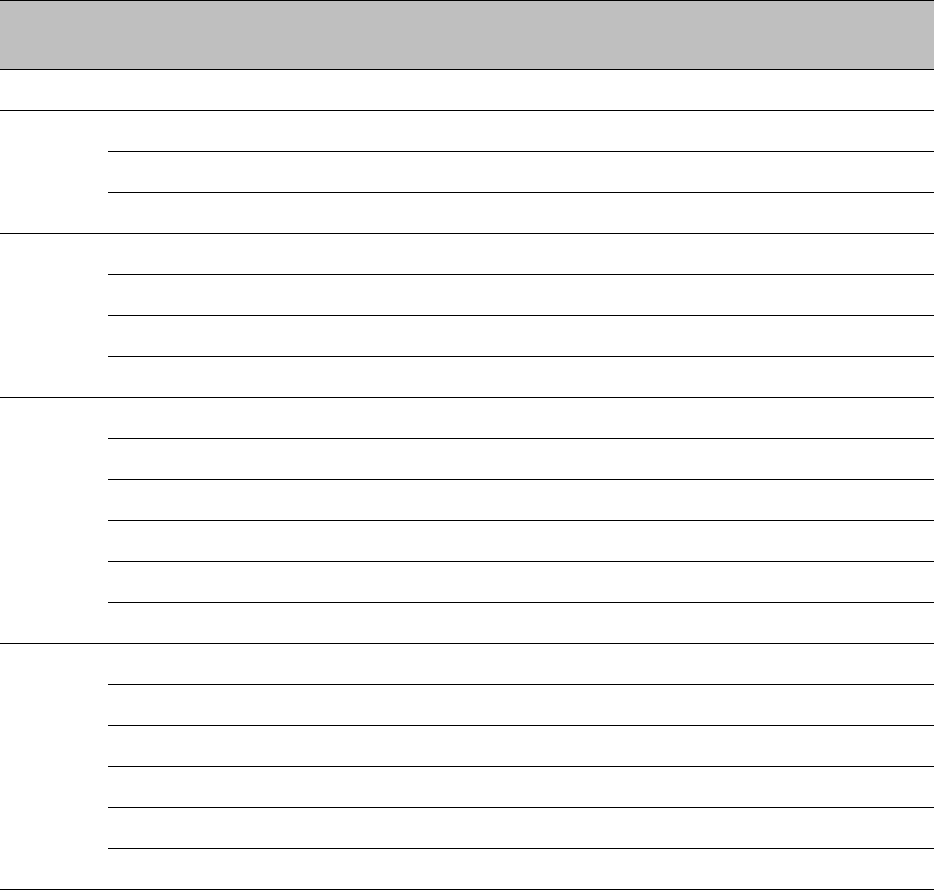
Chapter 4: Legal and regulatory information
Compliance with safety standards
Page 4-28
Table 72 FCC minimum safe distances – PMP/PTP 450 900 MHz, 2.4 GHz, 3.65 GHz and 5 GHz
Band
Antenna
P burst
(W)
G
(dBi)
S
(W/ m2)
d
(m)
900 MHz
Yagi
0.032
13 (11 dBi)
6
0.07
2.4 GHz
Sector Antenna
0.079
50 (17 dBi)
10
0.18
Integrated
0.158
6 (8 dBi)
10
0.09
Reflector
0.040
100 (20 dBi)
10
0.18
3.65
GHz
Sector Antenna
0.316
32 (15 dBi)
10
0.28
Integrated
0.316
6 (8 dBi)
10
0.12
Reflector
0.25
100 (20 dBi)
10
0.45
High-gain Ruggedized
0.25
79 (19 dBi)
10
0.40
5.4 GHz
Sector
0.025
40 (16 dBi)
10
0.09
Integrated
0.126
8 (9 dBi)
10
0.09
Reflector
0.003
316 (25 dBi)
10
0.09
CLIP
0.020
50 (17 dBi)
10
0.09
LENS
0.032
28 (14.5 dBi)
10
0.08
Integrated Dish (450d)
0.0032
316 (25 dBi)
10
0.09
5.8 GHz
Sector
0.079
40 (16 dBi)
10
0.16
Integrated
0.158
8 (9 dBi)
10
0.10
Reflector
0.158
316 (25 dBi)
10
0.63
CLIP
0.158
50 (17 dBi)
10
0.25
LENS
0.158
28 (14.5 dBi)
10
0.19
Integrated Dish (450d)
0.158
316 (25 dBi)
10
0.63

Chapter 4: Legal and regulatory information
Compliance with safety standards
Page 4-29
Table 73 ISEDC minimum safe distances – PMP/PTP 450 900 MHz, 2.4 GHz, 3.5/3.65 GHz and 5 GHz
Band
Antenna
P burst
(W)
G
(dBi)
S
(W/ m2)
d
(m)
900 MHz
Yagi
0.316
13 (11 dBi)
2.74
0.35
2.4 GHz
Sector Antenna
0.079
50 (17 dBi)
5.35
0.24
Integrated
0.158
6 (8 dBi)
5.35
0.12
Reflector
0.040
100 (20 dBi)
5.35
0.24
3.5 GHz
Sector
0.316
32 (15 dBi)
37.10
0.15
Integrated
0.316
6 (8 dBi)
37.10
0.06
Reflector
0.316
100 (20 dBi)
37.10
0.26
High-gain Ruggedized
0.316
79 (19 dBi)
37.10
0.23
3.65
GHz
(lower
Canada)
Sector
0.316
32 (15 dBi)
38.20
0.15
Integrated
0.316
6 (8 dBi)
38.20
0.06
Reflector
0.316
100 (20 dBi)
38.20
0.26
High-gain Ruggedized
0.316
79 (19 dBi)
38.20
0.23
3.65
GHz
(upper
Canada)
Sector
0.316
32 (15 dBi)
38.20
0.14
Integrated
0.316
6 (8 dBi)
38.20
0.06
Reflector
0.20
100 (20 dBi)
38.20
0.20
High-gain Ruggedized
0.003
79 (19 dBi)
38.20
0.23
5.4 GHz
Sector
0.025
40 (16 dBi)
9.39
0.09
Integrated
0.126
8 (9 dBi)
9.39
0.09
Reflector
0.003
316 (25 dBi)
9.39
0.09
CLIP
0.020
50 (17 dBi)
9.39
0.09
LENS
0.032
28 (14.5 dBi)
9.39
0.09
Integrated Dish (450d)
0.0032
316 (25 dBi)
9.39
0.09
5.8 GHz
Sector
.079
40 (16 dBi)
9.69
0.16
Integrated
0.158
8 (9 dBi)
9.69
0.10
Reflector
0.158
316 (25 dBi)
9.69
0.064
CLIP
0.158
50 (17 dBi)
9.69
0.25
LENS
0.158
28 (14.5 dBi)
9.69
0.19
Integrated Dish (450d)
0.158
316 (25 dBi)
9.69
0.64

Chapter 4: Legal and regulatory information
Compliance with safety standards
Page 4-30
(*1) P: maximum average transmit power capability of the radio including cable loss (Watt)
Capacité de puissance d'émission moyenne maximale de la radio comprenant la perte dans
les câble de connexion (W)
(*2) G: total transmit gain as a factor, converted from dB
Gain total d'émission, converti à partir de la valeur en dB
(*3) S: power density (W/m2)
Densité de puissance (W/m2)
(*4) d: minimum distance from point source (meters)
Distance minimale de source ponctuelle (en mètres)
Note
Gain of antenna in dBi = 10 * log(G).
The regulations require that the power used for the calculations is the maximum
power in the transmit burst subject to allowance for source-based time-averaging.
At 5.4 GHz and EU 5.8 GHz, the products are generally limited to a fixed EIRP which
can be achieved with the Integrated Antenna. The calculations above assume that the
maximum EIRP allowed by the regulations is being transmitted.
Remarque
Gain de l'antenne en dBi = 10 * log(G).
Les règlements exigent que la puissance utilisée pour les calculs soit la puissance
maximale de la rafale de transmission soumis à une réduction pour prendre en
compte le rapport cyclique pour les signaux modulés dans le temps.
Pour une opération dans la CEE dans les bandes 5,4 GHz et 5,8 GHz, les produits sont
généralement limités à une PIRE qui peut être atteinte avec l'antenne intégrée. Les
calculs ci-dessus supposent que la PIRE maximale autorisée par la réglementation est
atteinte.
Note
If there are no EIRP limits in the country of deployment, use the distance calculations
for FCC 5.8 GHz for all frequency bands.
At FCC 5.8 GHz, for antennas between 0.6m (2ft) and 1.8m (6ft), alter the distance
proportionally to the antenna gain.
Remarque
Si aucune limite de PIRE existe pour le pays de déploiement, utilisez les calculs de
distance pour FCC 5,8 GHz pour toutes les bandes de fréquence.
Pour la band FCC 5,8 GHz et les antennes entre 0,6 m (2 pieds) et 1,8 m (6 pieds),
modifier la distance proportionnellement au gain de l'antenne.
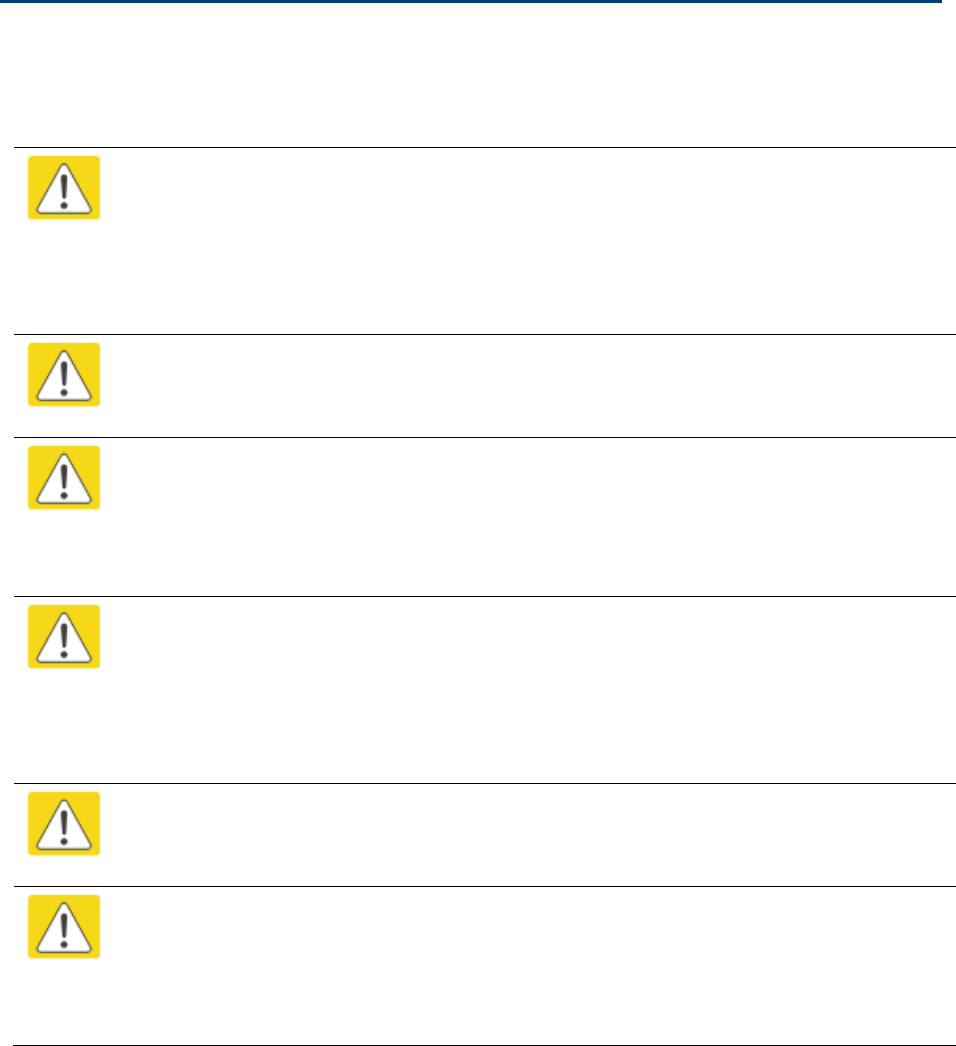
Chapter 4: Legal and regulatory information
Compliance with radio regulations
Page 4-31
Compliance with radio regulations
This section describes how the PMP/PTP 450 platform complies with the radio regulations that are
in force in various countries.
Caution
Where necessary, the end user is responsible for obtaining any National licenses
required to operate this product and these must be obtained before using the product
in any particular country. Contact the appropriate national administrations for details
of the conditions of use for the bands in question and any exceptions that might
apply.
Caution
Changes or modifications not expressly approved by Cambium Networks could void
the user’s authority to operate the system.
Caution
For the connectorized version of the product and in order to reduce potential radio
interference to other users, the antenna type and its gain should be so chosen that the
Effective Isotropically Radiated Power (EIRP) is not more than that permitted for
successful communication.
Attention
Le cas échéant, l'utilisateur final est responsable de l'obtention des licences nationales
nécessaires pour faire fonctionner ce produit. Celles-ci doivent être obtenus avant
d'utiliser le produit dans un pays particulier. Contactez les administrations nationales
concernées pour les détails des conditions d'utilisation des bandes en question, et
toutes les exceptions qui pourraient s'appliquer
Attention
Les changements ou modifications non expressément approuvés par les réseaux de
Cambium pourraient annuler l'autorité de l'utilisateur à faire fonctionner le système.
Attention
Pour la version du produit avec une antenne externe, et afin de réduire le risque
d'interférence avec d'autres utilisateurs, le type d'antenne et son gain doivent être
choisis afin que la puissance isotrope rayonnée équivalente (PIRE) ne soit pas
supérieure au minimum nécessaire pour établir une liaison de la qualité requise.

Chapter 4: Legal and regulatory information
Compliance with radio regulations
Page 4-32
Type approvals
This system has achieved Type Approval in various countries around the world. This means that
the system has been tested against various local technical regulations and found to comply. The
frequency bands in which the system operates may be ‘unlicensed’ and, in these bands, the
system can be used provided it does not cause interference. The system is not guaranteed
protection against interference from other products and installations.
The radio specification type approvals that have been granted for 450 platform frequency variants
are listed under Table 74.
Table 74 Radio certifications
Region/Country
Band
Specification
Brazil
4.9 GHz
ANATEL, RESOLUÇÃO Nº 633, DE 14 DE MARÇO DE 2014
5.4 GHz
ANATEL, RESOLUTION No. 506, FROM JULY 1, 2008
5.8 GHz
ANATEL, RESOLUTION No. 506, FROM JULY 1, 2008
Mexico
900 MHz
NOM-121-SCT1-2009
4.9 GHz
Protocol Between the UNITED STATES OF AMERICA and
MEXICO – Use of 4940 to 4990 MHz band.
5.4 GHz
Acuerdo del 27 de noviembre de 2012
5.8 GHz
NOM-121-SCT1-2009
USA
900 MHz
FCC Part 15.247
2.4 GHz
FCC Part 15 Class B
3.6 GHz
FCC Part 15 Class B
4.9 GHz
FCC 47 CFR Part 90
5.1 GHz
FCC 47 CFR Part 15 E
5.2 GHz
FCC 47 CFR Part 15 E
5.4 GHz
FCC 47 CFR Part 15 E
5.8 GHz
FCC 47 CFR Part 15 C
Canada
900 MHz
RSS Gen and RSS 210
2.4 GHz
RSS Gen and RSS 210
3.5 /3.6 GHz
RSS Gen and RSS 192
4.9 GHz
IC RSS-111, Issue 5
5.8 GHz
IC RSS-247, Issue 1
Europe
3.5 GHz
ETSI EN 302 326-2 V1.2.2

Chapter 4: Legal and regulatory information
Compliance with radio regulations
Page 4-33
4.9 GHz
ETSI EN302 625; V1.1.1 Broadband Disaster Relief
5.4 GHz
ETSI EN 301 893 V1.7.1
5.8 GHz
ETSI EN 302 502 V1.2.1
Brazil specific information
Brazil notification
For compliant operation in the 5.4 GHz band, the Equivalent Isotropic Radiated Power from the
integrated antenna or connectorized antenna shall not exceed 30 dBm (0.5 W).
The operator is responsible for enabling the DFS feature on any Canopy 5.4 GHz radio by setting
the Country Code to “Brazil”, including after the module is reset to factory defaults.
Important Note: This equipment operates as a secondary application, so it has no rights against
harmful interference, even if generated by similar equipment, and cannot cause harmful
interference on systems operating as primary applications.
Brazil certification numbers
The Anatel certification number for Brazil for the PMP/PTP 450i is 2426-15-7745.
Australia Notification
900 MHz modules must be set to transmit and receive only on center channels of 920, 922, or 923
MHz so as to stay within the ACMA approved band of 915 MHz to 928 MHz for the class license and
not interfere with other approved users.
After taking into account antenna gain (in dBi), 900 MHz modules’ transmitter output power (in
dBm) must be set to stay within the legal regulatory limit of 30 dBm (1 W) EIRP for this 900 MHz
frequency band.
Regulatory Requirements for CEPT Member States
(www.cept.org)
When operated in accordance with the instructions for use, Cambium Wireless equipment
operating in the 5.1 GHz and 5.4 GHz bands is compliant with CEPT Resolution 229 (REV. WRC-12).
Operating the PMP/PTP 450 platform in the bands 5150 to 5350 MHz and 5470 to 5725 MHz is
granted providing it is not causing interference to the existing primary services allocated to those
bands.
For compliant operation in the 5250 to 5350 MHz band, the transmit power from the integrated
antenna or a connectorized antenna shall be limited to a maximum mean EIRP of 200 mW and a
maximum mean EIRP density of 10 mW/MHz in any 1 MHz band.

Chapter 4: Legal and regulatory information
Compliance with radio regulations
Page 4-34
For compliant operation in the 5470 to 5725 MHz band, the transmit power shall be restricted to a
maximum of 250 mW with a maximum mean EIRP of 1 W and a maximum mean EIRP density of
50 mW/MHz in any 1 MHz band.
For compliant operation in the bands 5 250-5 350 MHz and 5 470-5 725 MHz, the PMP/PTP 450
platform employs transmitter power control.
For EU member states, RLAN equipment in the 5.4GHz bands is exempt from individual licensing
under Commission Recommendation 2003/203/EC. Contact the appropriate national
administrations for details on the conditions of use for the bands in question and any exceptions
that might apply. Also see www.ero.dk for further information.
Cambium Radio equipment operating in the 5470 to 5725 MHz band are categorized as “Class 1”
devices within the EU in accordance with ECC DEC(04)08 and are “CE” marked
to show compliance with the European Radio & Telecommunications Terminal Equipment
(R&TTE) directive 1999/5/EC. The relevant Declaration of Conformity can be found at
http://www.cambiumnetworks.com/support/ec_doc/ .
A European Commission decision, implemented by Member States on 31 October 2005, makes the
frequency band 5470-5725 MHz available in all EU Member States for wireless access systems.
Under this decision, the designation of Canopy 5.4GHz products become “Class 1 devices” and
these do not require notification under article 6, section 4 of the R&TTE Directive. Consequently,
these 5.4GHz products are only marked with the symbol and may be used in
any member state.

Page 5-1
Chapter 5: Preparing for installation
This chapter describes how to stage and test the hardware for a PMP 450 platform network. This
chapter is arranged as follows:
Safety on page 5-2: Describes the precautions to be observed and checks to be performed
before proceeding with the installation
Preparing for installation on page 5-5: Describes the pre-configuration procedure before
proceed with installation.
Testing system components on page 5-7: Describes the procedures for unpacking and
performing and initial staging of the PMP/PTP 450 platform equipment
Configuring Link for Test on page 5-15: Describes the procedures for testing the equipment’s
radio links.

Chapter 5: Preparing for installation
Safety
Page 5-2
Safety
Warning
To prevent loss of life or physical injury, observe the following safety guidelines. In no
event shall Cambium Networks be liable for any injury or damage caused during the
installation of the Cambium PMP/PTP 450 platform. Ensure that only qualified
personnel install a PMP/PTP 450 platform link.
Power lines
Exercise extreme care when working near power lines.
Working at heights
Exercise extreme care when working at heights.
Power supply
Always use one of the Cambium PMP/PTP 450 platform Series power supply units (PSU) to power
the ODU. Failure to use a Cambium supplied PoE could result in equipment damage and will
invalidate the safety certification and may cause a safety hazard.
Grounding and protective earth
The Outdoor Unit (ODU) must be properly grounded to protect against lightning. It is the user’s
responsibility to install the equipment in accordance with national regulations. In the USA follow
the requirements of the National Electrical code NFPA 70-2005 and 780-2004 Installation of
Lightning Protection Systems. In Canada, follow Section 54 of the Canadian Electrical Code. These
codes describe correct installation procedures for grounding the outdoor unit, mast, lead-in wire
and discharge unit, size of grounding conductors and connection requirements for grounding
electrodes. Other regulations may apply in different countries and therefore it is recommended
that installation of the outdoor unit be contracted to a professional installer.
Powering down before servicing
Always power down and unplug the equipment before servicing.
Chapter 5: Preparing for installation
Safety
Page 5-3
Primary disconnect device
The ODU power supply is the primary disconnect device.
External cables
Safety may be compromised if outdoor rated cables are not used for connections that will be
exposed to the outdoor environment. For outdoor copper Cat5e Ethernet interfaces, always use
Cat5e cable that is gel-filled and shielded with copper-plated steel.
RF exposure near the antenna
Strong radio frequency (RF) fields will be present close to the antenna when the transmitter is on.
Always turn off the power to the ODU before undertaking maintenance activities in front of the
antenna.
Minimum separation distances
Ensure that personnel are not exposed to unsafe levels of RF energy. The units start to radiate RF
energy as soon as they are powered up. Never work in front of the antenna when the ODU is
powered. Install the ODUs so as to provide and maintain the minimum separation distances from
all persons. For minimum separation distances, see Calculated distances and power compliance
margins on page 4-24.
Grounding and lightning protection requirements
Ensure that the installation meets the requirements defined in Grounding and lightning protection
on page 3-8.
Grounding cable installation methods
To provide effective protection against lightning induced surges, observe these requirements:
Grounding conductor runs are as short, straight and smooth as possible, with bends and
curves kept to a minimum.
Grounding cables must not be installed with drip loops.
All bends must have a minimum radius of 200 mm (8 in) and a minimum angle of 90°. A
diagonal run is preferable to a bend, even though it does not follow the contour or run parallel
to the supporting structure.
All bends, curves and connections must be routed towards the grounding electrode system,
ground rod, or ground bar.

Chapter 5: Preparing for installation
Safety
Page 5-4
Grounding conductors must be securely fastened.
Braided grounding conductors must not be used.
Approved bonding techniques must be used for the connection of dissimilar metals.
Siting ODUs and antennas
ODUs, external antennas and GPS receivers are not designed to survive direct lightning strikes. For
this reason they must be installed in Zone B as defined in Lightning protection zones on page 3-9.
Mounting in Zone A may put equipment, structures and life at risk.
Thermal Safety
The ODU enclosure may be hot to the touch when in operation. The ODU must not be operated in
ambient temperatures exceeding 40°C unless mounted in a Restricted Access Location. For more
information, see ODU ambient temperature limits on page 3-10.
Warning
Do not install the ODU in a location where the ambient temperature could exceed 40°C
unless this is a Restricted Access Location as defined by EN 60950-1.
Alerte
L’unité externe ne doit pas être installée dans un endroit où la température ambiante
est supérieure à 40C à moins que l’accès soit limité au personnel autorisé.

Chapter 5: Preparing for installation
Preparing for installation
Page 5-5
Preparing for installation
ODU pre-configuration
It is common practice to pre-configure the units during staging before site installation by
performing the following tasks:
Connecting to the unit
Configuring IP and Ethernet interfaces
Upgrading the software version and using CNUT
General configuration
Configuring security
Configuring radio parameters
Setting up SNMP agent
Configuring syslog
Configuring remote access
Monitoring the Link
Configuring quality of service
Zero Touch Configuration Using DHCP Option 66
Configuring Radio via config file
Configuring a RADIUS server
If the units are to be pre-configured during staging, the safety precautions below MUST be
observed.
Preparing personnel
In no event shall Cambium Networks be liable for any injury or damage caused during the
installation of the Cambium PMP/PTP 450 platform equipment.
Ensure that only qualified personnel undertake the installation of a PMP/PTP 450 platform system.
Ensure that all safety precautions are observed.
Preparing inventory
Perform the following inventory checks:
Check that the correct components are available, as described in Ordering the components on
page 2-43.
Check the contents of all packages against their packing lists.
Chapter 5: Preparing for installation
Preparing for installation
Page 5-6
Preparing tools
Check that following specific tools are available, in addition to general tools:
RJ45 crimp tool (it must be the correct tool for the type of RJ45 being used).
Personal Computer (PC) with 10 or 100 or 1000 BaseT Ethernet port
Internet Explorer or Firefox
Ethernet patch cables

Chapter 5: Preparing for installation
Testing system components
Page 5-7
Testing system components
The best practice is to connect all components—AP/BHM, SMs/BHS, GPS antenna (if applicable)
and CMM (if applicable)—in a test setting and initially configure and verify them before deploying
them to an installation. In this way, any configuration issues are worked out before going on-site,
on a tower, in the weather, where the discovery of configuration issues or marginal hardware is
more problematic and work-flow affecting.
Unpacking Components
When a delivery arrives, inspect all packages immediately for damages.
Carefully unpack the equipment, verify that all the components have arrived as per order and are
in good condition. Save all packaging materials for equipment transportation to the installation
site.
Preparing the ODU
After the equipment is unpacked, the units may be configured for staging tests.
Use either of two methods to configure an AP/BHM:
Use the Quick Start feature of the product (via GUI menu Quick Start)
Manually set each parameter
After changing configuration parameters on a GUI web page:
Before you leave a web page, click the Save button to save the change(s)
After making change(s) on multiple web pages, click the Reboot button to reboot the module
and implement the change(s)
Configuring the Computing Device for Test
If the computer is configured for Dynamic Host Configuration Protocol (DHCP), disconnect the
computer from the network. If the computer is instead configured for static IP addressing
Set the static address in the 169.254 network
Set the subnet mask to 255.255.0.0.
For detailed instructions, see section Configuring the management PC on page 5-15.

Chapter 5: Preparing for installation
Testing system components
Page 5-8
Factory default Configuration
From the factory, the APs/BHMs and SMs/BHSs are all configured to not transmit on any
frequency. This configuration ensures that equipment operators do not accidentally turn on an
unsynchronized module. Site synchronization of modules is required because
modules:
o cannot transmit and receive signals at the same time.
o use TDD (Time Division Duplexing) to distribute signal access of the downlink and uplink
frames.
when one module transmits while an unintended module nearby receives signal, the
transmitting module may interfere with or desense the receiving module. In this context,
interference is self-interference (within the same network).
ODU interfaces
See section PMP/PTP 450 platform interfaces on page 2-7
ODU diagnostic LEDs
See section AP/BHM LEDs on page 2-12.
See section SM/BHS LEDs on page 2-13.
Recommended Tools for Installation
The following tools may be needed for installation:
Table 75 Tools for PMP and PTP 450 platform equipment installation
Equipment to Be
Installed
Tools Required
AP or BHM
3 mm Allen Wrench
Used for connecting the antenna mating bracket to the rear of the AP
housing
Crescent Wrench Pair
Used for tightening cable glands
Self-amalgamating and PVC Tape
Used for weatherproofing N-type connections

Chapter 5: Preparing for installation
Testing system components
Page 5-9
Equipment to Be
Installed
Tools Required
AP or BHM or BHS
Antenna
13 mm Spanner Wrench (or Ratchet Spanner Wrench) Pair
Used for connecting the antenna (sector or omni for AP, or directional for
BH)base to the pole/mast mounting bracket
Self-amalgamating and PVC Tape
Used for weatherproofing N-type connections
N-type Torque Wrench (not required but recommended)
Used for assuring proper tightening of N-type connectors terminating the
RF cables
SM
Wrench/driver (depending on operator’s choice of clamps)
Used for tightening clamps to the pole
Alignment tone adapter / headset
Used for aligning the SM to the AP
Universal Global
Positioning System
Philips Screwdriver
Used for attaching the UGPS unit to the pole/mast mounting bracket
13mm Spanner Wrench (or Ratchet Spanner Wrench)
Used for connecting the mounting bracket’s U-bolt to the antenna or mast
Cabling
Electrician’s Scissors or Wire Cutters
Used for cutting wire to length
RJ-11/RJ-45 Crimping Tool
Used for stripping RJ-11/RJ-45 cables and for terminating cable ends
Cable Testing Device
Used to ensure that cables are properly constructed
Standards for Wiring
Modules automatically sense whether the Ethernet cable in a connection is wired as straight-
through or crossover. Operators may use either straight-through or crossover cable to connect a
network interface card (NIC), hub, router, or switch to these modules. For a straight-through cable,
use the EIA/TIA-568B wire color-code standard on both ends. For a crossover cable, use the
EIA/TIA-568B wire color-code standard on one end, and the EIA/TIA-568A wire color-code standard
on the other end.

Chapter 5: Preparing for installation
Testing system components
Page 5-10
Best Practices for Cabling
The following practices are essential to the reliability and longevity of cabled connections:
Use only shielded cables to resist interference.
For vertical runs, provide cable support and strain relief.
Include a 2-ft (0.6-m) service loop on each end of the cable to allow for thermal expansion and
contraction and to facilitate terminating the cable again when needed.
Include a drip loop to shed water so that most of the water does not reach the connector at the
device.
Properly crimp all connectors.
Use dielectric grease on all connectors to resist corrosion.
Use only shielded connectors to resist interference and corrosion.
Wiring Connectors
The following diagrams correlate pins to wire colors and illustrate crossovers where applicable.
Pin 1, relative to the lock tab on the connector of a straight-through cable is located as shown
below.
Figure 42 Pin 1 location

Chapter 5: Preparing for installation
Testing system components
Page 5-11
Main port pinout
Table 76 Main port pinout
RJ45 pin
Description
1
+TxRx0
2
–TxRx0
3
+TxRx1
4
+TxRx2
5
–TxRx2
6
–TxRx1
7
+TxRx3
8
–TxRx3
Aux port pinout
Table 77 Aux port pinout
RJ45 pin
Description
1
+TxRx0
2
–TxRx0
3
+TxRx1
4
GPS power out, Alignment tone out, GPS data out
5
GPS data in
6
–TxRx1
7
GPS 0v
8
GPS Sync in
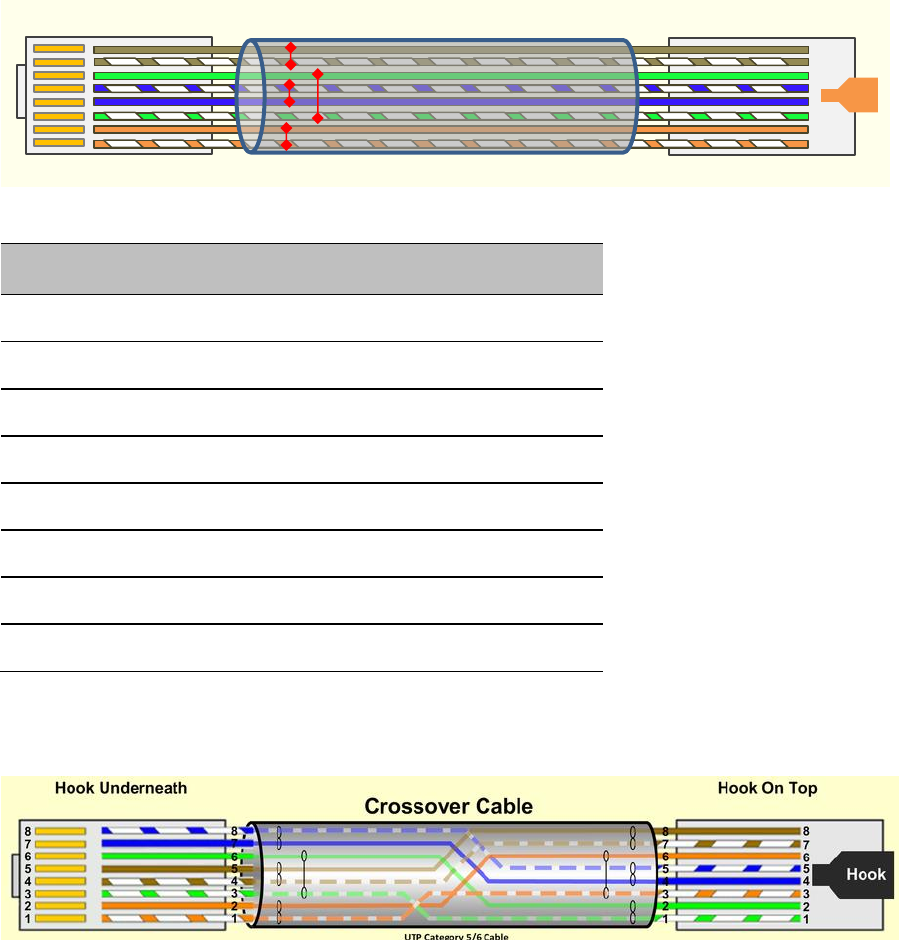
Chapter 5: Preparing for installation
Testing system components
Page 5-12
RJ-45 Pinout for Straight-through Ethernet Cable
Figure 43 Straight-through Ethernet Cable
Table 78 RJ-45 pinout for straight-through Ethernet cable
Pin
Signal
Pair
Color
1
TP1+
2
White/orange stripe
2
TP1-
2
Orange solid
3
TP2+
3
White/green stripe
4
TP3-
1
Blue solid
5
TP3+
1
White/blue stripe
6
TP2-
3
Green solid
7
TP4+
4
White/brown stripe
8
TP4-
4
Brown solid
RJ-45 Pinout for Crossover Ethernet Cable
``
RJ45 Connector (Bottom)
Straight-Through Cable
RJ45 Connector (Top)
8
7
6
5
4
3
2
1
8
7
6
5
4
3
2
1
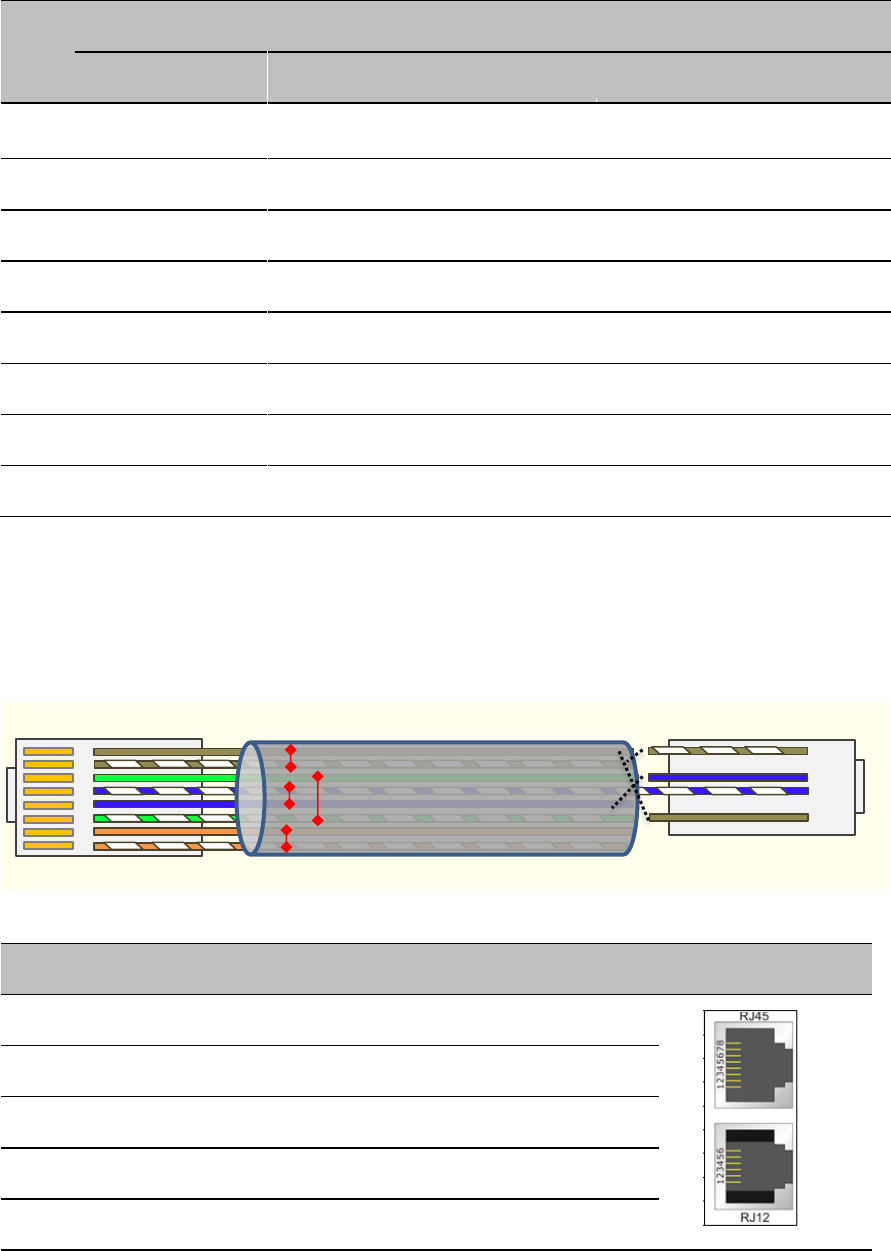
Chapter 5: Preparing for installation
Testing system components
Page 5-13
Table 79 RJ-45 pinout for crossover Ethernet cable
Pin
Connection 1
Connection 2
Signal
Pair
Color
Signal
Pair
Color
1
TP2+
3
White/green stripe
TP1+
2
White/orange stripe
2
TP2-
3
Green solid
TP1-
2
Orange solid
3
TP1+
2
White/orange stripe
TP2+
3
White/green stripe
4
TP3-
1
Blue solid
TP3-
1
Blue solid
5
TP3+
1
White/blue stripe
TP3+
1
White/blue stripe
6
TP1-
2
Orange solid
TP2-
3
Green solid
7
TP4+
4
White/brown stripe
TP4+
4
White/brown stripe
8
TP4-
4
Brown solid
TP4-
4
Brown solid
AP/BHM to UGPS cable
The AP/BHM to UGPS cable can be constructed from RJ12 to RJ 45 cable using the ping
configuration described in Table 80.
Figure 44 AP/BHM to UGPS cable
Table 80 AP/BHM to UGPS cable pinout
Pin
450i AP RJ 45 Connector
Pin
UGPS RJ 12 Connector
Connector
1
NC
1
8 on RJ 45
2
NC
2
NC
3
NC
3
5 on RJ 45
4
4 on RJ 12
4
4 on RJ 45
5
3 on RJ 12
5
NC
``
RJ45 Connector (Bottom)
Straight-Through Cable
RJ12 Connector (Top)
6
NC 5
4
3
NC 2
1
8
7
6
5
4
3
2
1

Chapter 5: Preparing for installation
Testing system components
Page 5-14
6
NC
6
7 on RJ 45
7
6 on RJ 12
8
1 on RJ 12
Note
The AP/BHM will only power up the UGPS if it configured to do so.
Alignment tone cable
The alignment tone cable is constructed using RJ45 plug and Stereo plug. The pin configuration is
shown inFigure 45
Figure 45 Alignment tone cable pin configuration
Override plug cable
To construct an override plug, perform the following steps:
Crip a RJ-11 6 pin connector onto a 6 inch length of CAT 5 cable
Pin out all 6 pins
Short (solder together) pins 4 and 6 on the other end. Do not connect any other wires to
anything.
Figure 46 RJ-11 pinout for the default plug
220 Ω
220 Ω
Resistors
Pin 7
Pin 4
Left
Right
Common
#8
#1
``
RJ12 Connector (Bottom)
Override plug cable wiring
6
5
4
3
2
1
Tie together
Not used
Not used
Not used

Chapter 5: Preparing for installation
Configuring Link for Test
Page 5-15
Configuring Link for Test
It is important to stage the AP/BHM and SM/BHS units first to verify proper registration before
deploying the modules to the site. To begin configuring the modules for test, see the sections
below:
Configuring the management PC
To configure the local management PC to communicate with the AP, SM, BHM or BHS, proceed as
follows:
Powering the AP/SM/BH for test configuration
Perform the following steps to power on the ODU.
Procedure 2 Powering the ODU
1
Plug one end of a CAT 5 Ethernet cable into the ODU.
2
Plug the Ethernet cable connector labeled To Radio into the jack in the pig tail that
hangs from the power supply.
3
Plug the other connector of the pig tail (this connector labeled To Computer) into
the Ethernet jack of the computing device.
4
Plug the power supply into an electrical outlet.
Warning
From this point until you remove power from the ODU, stay at least as
far from the AP as the minimum separation distance specified in
Minimum separation distances on page 5-3.
5
Power up the computing device
6
Start the browser in the computing device
The AP/BHM interface provides a series of web pages to configure and monitor the unit. Access
web-based interface through a computing device that is either directly connected or connected
through a network to the AP/BHM. If the computing device is not connected to a network when it is
being configured for test environment, and if the computer has used a proxy server address and
port to configure a module, then the operator may need to first disable the proxy setting in the
computer.

Chapter 5: Preparing for installation
Configuring Link for Test
Page 5-16
Perform the following procedure to toggle the computer to not use the proxy setting.
Procedure 3 Bypassing browser proxy settings to access module web pages
1
Launch Microsoft Internet Explorer
2
Select Tools, Internet Options, Connections, LAN Settings. Alternate web browser
menu selections may differ.
3
Uncheck the Use a proxy server box.
In the address bar of your browser, enter the IP address of the AP/BHM. (For example, enter
http://169.254.1.1 to access the AP/BHM through its default IP address). The AP/BHM
responds by opening the General Status tab of its Home page.
Logging into the web interface – AP/SM/BH
Procedure 4 Logging into the web interface
1
Plug one end of a CAT 5 Ethernet cable into the AP/BHM
2
Plug the Ethernet cable connector labeled To Radio into the jack in the pig tail that
hangs from the power supply.
3
Plug the other connector of the pig tail (this connector labeled To Computer) into
the Ethernet jack of the computing device.
4
Plug the power supply into an electrical outlet.
Warning
From this point until you remove power from the ODU, stay at least as
far from the ODU as the minimum separation distance specified in
Minimum separation distances on page 5-3.
Using the Quick Start Configuration Wizard of the AP/BHM
See section Quick link setup on page 7-81.